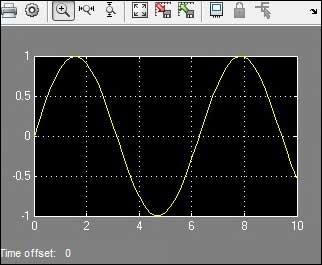MATLAB - คู่มือฉบับย่อ
MATLAB (ห้องปฏิบัติการเมทริกซ์) เป็นภาษาโปรแกรมระดับสูงรุ่นที่สี่และสภาพแวดล้อมแบบโต้ตอบสำหรับการคำนวณเชิงตัวเลขการแสดงภาพและการเขียนโปรแกรม
MATLAB ได้รับการพัฒนาโดย MathWorks
ช่วยให้การปรับเปลี่ยนเมทริกซ์ การวางแผนฟังก์ชันและข้อมูล การใช้อัลกอริทึม การสร้างส่วนต่อประสานผู้ใช้ การเชื่อมต่อกับโปรแกรมที่เขียนในภาษาอื่น ๆ รวมถึง C, C ++, Java และ FORTRAN วิเคราะห์ข้อมูล พัฒนาอัลกอริทึม และสร้างแบบจำลองและแอปพลิเคชัน
มีคำสั่งในตัวมากมายและฟังก์ชันทางคณิตศาสตร์ที่ช่วยคุณในการคำนวณทางคณิตศาสตร์สร้างพล็อตและดำเนินการตามวิธีการเชิงตัวเลข
MATLAB's Power of Computational Mathematics
MATLAB ใช้ในทุกแง่มุมของคณิตศาสตร์เชิงคำนวณ ต่อไปนี้คือการคำนวณทางคณิตศาสตร์ที่ใช้กันทั่วไปซึ่งใช้กันมากที่สุด -
- การจัดการกับเมทริกซ์และอาร์เรย์
- การพล็อตและกราฟิก 2 มิติและ 3 มิติ
- พีชคณิตเชิงเส้น
- สมการพีชคณิต
- ฟังก์ชันที่ไม่ใช่เชิงเส้น
- Statistics
- การวิเคราะห์ข้อมูล
- แคลคูลัสและสมการเชิงอนุพันธ์
- การคำนวณเชิงตัวเลข
- Integration
- Transforms
- Curve Fitting
- ฟังก์ชั่นพิเศษอื่น ๆ อีกมากมาย
คุณสมบัติของ MATLAB
ต่อไปนี้เป็นคุณสมบัติพื้นฐานของ MATLAB -
เป็นภาษาระดับสูงสำหรับการคำนวณเชิงตัวเลขการสร้างภาพและการพัฒนาแอปพลิเคชัน
นอกจากนี้ยังมีสภาพแวดล้อมแบบโต้ตอบสำหรับการสำรวจการออกแบบและการแก้ปัญหาซ้ำ ๆ
มีคลังฟังก์ชันทางคณิตศาสตร์มากมายสำหรับพีชคณิตเชิงเส้นสถิติการวิเคราะห์ฟูริเยร์การกรองการหาค่าเหมาะสมการรวมเชิงตัวเลขและการแก้สมการเชิงอนุพันธ์ธรรมดา
มีกราฟิกในตัวสำหรับการแสดงข้อมูลและเครื่องมือสำหรับการสร้างพล็อตแบบกำหนดเอง
อินเทอร์เฟซการเขียนโปรแกรมของ MATLAB มีเครื่องมือในการพัฒนาเพื่อปรับปรุงการบำรุงรักษาคุณภาพโค้ดและเพิ่มประสิทธิภาพสูงสุด
มีเครื่องมือสำหรับสร้างแอพพลิเคชั่นที่มีอินเทอร์เฟซแบบกราฟิกที่กำหนดเอง
มีฟังก์ชันสำหรับการรวมอัลกอริทึมที่ใช้ MATLAB เข้ากับแอปพลิเคชันและภาษาภายนอกเช่น C, Java, .NET และ Microsoft Excel
การใช้ MATLAB
MATLAB ถูกใช้กันอย่างแพร่หลายในฐานะเครื่องมือคำนวณทางวิทยาศาสตร์และวิศวกรรมซึ่งครอบคลุมสาขาฟิสิกส์เคมีคณิตศาสตร์และวิศวกรรมศาสตร์ทั้งหมด ถูกใช้ในแอพพลิเคชั่นต่างๆ ได้แก่ -
- การประมวลผลสัญญาณและการสื่อสาร
- การประมวลผลภาพและวิดีโอ
- ระบบควบคุม
- การทดสอบและการวัดผล
- การเงินคอมพิวเตอร์
- ชีววิทยาเชิงคำนวณ
การตั้งค่าสภาพแวดล้อมท้องถิ่น
การตั้งค่าสภาพแวดล้อม MATLAB เป็นเรื่องของการคลิกเพียงไม่กี่ครั้ง โปรแกรมติดตั้งสามารถดาวน์โหลดได้จากที่นี่
MathWorks มีผลิตภัณฑ์ที่ได้รับอนุญาตเวอร์ชันทดลองใช้และเวอร์ชันสำหรับนักเรียนด้วยเช่นกัน คุณต้องลงชื่อเข้าใช้ไซต์และรอการอนุมัติเล็กน้อย
หลังจากดาวน์โหลดโปรแกรมติดตั้งซอฟต์แวร์สามารถติดตั้งได้ด้วยการคลิกเพียงไม่กี่ครั้ง

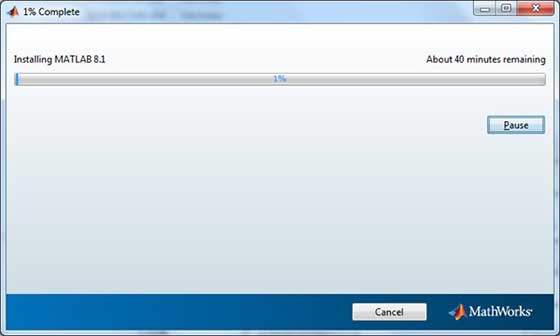
การทำความเข้าใจสภาพแวดล้อม MATLAB
MATLAB development IDE สามารถเปิดได้จากไอคอนที่สร้างบนเดสก์ท็อป หน้าต่างการทำงานหลักใน MATLAB เรียกว่าเดสก์ท็อป เมื่อ MATLAB เริ่มทำงานเดสก์ท็อปจะปรากฏในรูปแบบเริ่มต้น -
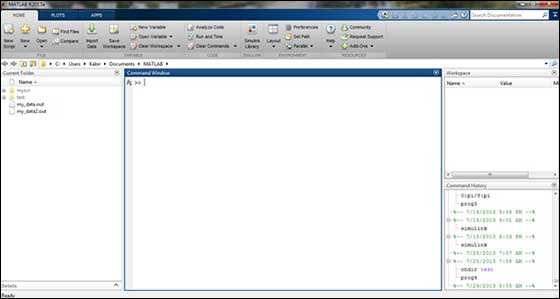
เดสก์ท็อปมีแผงดังต่อไปนี้ -
Current Folder - แผงนี้ช่วยให้คุณเข้าถึงโฟลเดอร์และไฟล์โครงการ
Command Window- นี่คือพื้นที่หลักที่สามารถป้อนคำสั่งได้ที่บรรทัดคำสั่ง มันถูกระบุโดยพรอมต์คำสั่ง (>>)
Workspace - พื้นที่ทำงานแสดงตัวแปรทั้งหมดที่สร้างและ / หรือนำเข้าจากไฟล์
Command History - แผงนี้แสดงหรือส่งคืนคำสั่งที่ป้อนในบรรทัดคำสั่ง
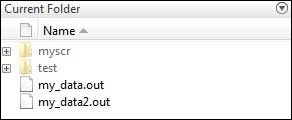

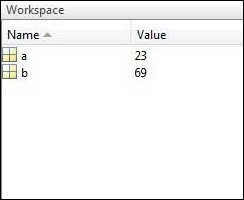

ตั้งค่า GNU Octave
หากคุณมีความยินดีที่จะใช้คู่บนเครื่องของคุณ (Linux, BSD, OS X หรือ Windows) แล้วกรุณาดาวน์โหลดรุ่นล่าสุดจากดาวน์โหลด GNU Octave คุณสามารถตรวจสอบคำแนะนำในการติดตั้งสำหรับเครื่องของคุณ
สภาพแวดล้อม MATLAB ทำงานเหมือนเครื่องคิดเลขที่ซับซ้อนมาก คุณสามารถป้อนคำสั่งที่พรอมต์คำสั่ง >>
MATLAB เป็นสภาพแวดล้อมที่ถูกตีความ กล่าวอีกนัยหนึ่งคือคุณให้คำสั่งและ MATLAB จะดำเนินการทันที
ลงมือปฏิบัติ
พิมพ์นิพจน์ที่ถูกต้องตัวอย่างเช่น
5 + 5แล้วกด ENTER
เมื่อคุณคลิกปุ่ม Execute หรือพิมพ์ Ctrl + E MATLAB จะดำเนินการทันทีและผลลัพธ์ที่ได้กลับมาคือ -
ans = 10ให้เราดูตัวอย่างเพิ่มเติม -
3 ^ 2 % 3 raised to the power of 2เมื่อคุณคลิกปุ่ม Execute หรือพิมพ์ Ctrl + E MATLAB จะดำเนินการทันทีและผลลัพธ์ที่ได้กลับมาคือ -
ans = 9ตัวอย่างอื่น,
sin(pi /2) % sine of angle 90oเมื่อคุณคลิกปุ่ม Execute หรือพิมพ์ Ctrl + E MATLAB จะดำเนินการทันทีและผลลัพธ์ที่ได้กลับมาคือ -
ans = 1ตัวอย่างอื่น,
7/0 % Divide by zeroเมื่อคุณคลิกปุ่ม Execute หรือพิมพ์ Ctrl + E MATLAB จะดำเนินการทันทีและผลลัพธ์ที่ได้กลับมาคือ -
ans = Inf
warning: division by zeroตัวอย่างอื่น,
732 * 20.3เมื่อคุณคลิกปุ่ม Execute หรือพิมพ์ Ctrl + E MATLAB จะดำเนินการทันทีและผลลัพธ์ที่ได้กลับมาคือ -
ans = 1.4860e+04MATLAB มีนิพจน์พิเศษสำหรับสัญลักษณ์ทางคณิตศาสตร์บางอย่างเช่น pi สำหรับπ, Inf สำหรับ∞, i (และ j) สำหรับ√-1 เป็นต้น Nan ย่อมาจาก 'not a number'
การใช้อัฒภาค (;) ใน MATLAB
อัฒภาค (;) หมายถึงการสิ้นสุดคำสั่ง อย่างไรก็ตามหากคุณต้องการระงับและซ่อนเอาต์พุต MATLAB สำหรับนิพจน์ให้เพิ่มเครื่องหมายอัฒภาคหลังนิพจน์
ตัวอย่างเช่น,
x = 3;
y = x + 5เมื่อคุณคลิกปุ่ม Execute หรือพิมพ์ Ctrl + E MATLAB จะดำเนินการทันทีและผลลัพธ์ที่ได้กลับมาคือ -
y = 8การเพิ่มความคิดเห็น
สัญลักษณ์เปอร์เซ็นต์ (%) ใช้สำหรับระบุบรรทัดความคิดเห็น ตัวอย่างเช่น,
x = 9 % assign the value 9 to xคุณยังสามารถเขียนบล็อกความคิดเห็นโดยใช้ตัวดำเนินการบล็อกความคิดเห็น% {และ%}
ตัวแก้ไข MATLAB มีเครื่องมือและรายการเมนูบริบทเพื่อช่วยคุณเพิ่มลบหรือเปลี่ยนรูปแบบของความคิดเห็น
ตัวดำเนินการและอักขระพิเศษที่ใช้กันทั่วไป
MATLAB รองรับตัวดำเนินการที่ใช้กันทั่วไปและอักขระพิเศษต่อไปนี้ -
| ตัวดำเนินการ | วัตถุประสงค์ |
|---|---|
| + | บวก; ตัวดำเนินการเพิ่มเติม |
| - | ลบ; ตัวดำเนินการลบ |
| * | ตัวดำเนินการคูณสเกลาร์และเมทริกซ์ |
| .* | ตัวดำเนินการคูณอาร์เรย์ |
| ^ | ตัวดำเนินการยกกำลังสเกลาร์และเมทริกซ์ |
| .^ | ตัวดำเนินการยกกำลังอาร์เรย์ |
| \ | ตัวดำเนินการด้านซ้าย |
| / | ตัวดำเนินการส่วนขวา |
| .\ | ตัวดำเนินการแบ่งด้านซ้ายของอาร์เรย์ |
| ./ | อาร์เรย์ตัวดำเนินการแบ่งขวา |
| : | ลำไส้ใหญ่; สร้างองค์ประกอบที่เว้นระยะอย่างสม่ำเสมอและแสดงทั้งแถวหรือคอลัมน์ |
| ( ) | วงเล็บ; ล้อมรอบอาร์กิวเมนต์ของฟังก์ชันและดัชนีอาร์เรย์ แทนที่ลำดับความสำคัญ |
| [ ] | วงเล็บ; องค์ประกอบอาร์เรย์เปลือกหุ้ม |
| . | จุดทศนิยม |
| … | จุดไข่ปลา; ตัวดำเนินการต่อสาย |
| , | ลูกน้ำ; แยกคำสั่งและองค์ประกอบในแถว |
| ; | อัฒภาค; แยกคอลัมน์และระงับการแสดงผล |
| % | เครื่องหมายเปอร์เซ็นต์; กำหนดความคิดเห็นและระบุการจัดรูปแบบ |
| _ | เครื่องหมายคำพูดและตัวดำเนินการเปลี่ยน |
| ._ | ตัวดำเนินการทรานสโพสที่ไม่ต่อกัน |
| = | ตัวดำเนินการมอบหมาย |
ตัวแปรพิเศษและค่าคงที่
MATLAB รองรับตัวแปรพิเศษและค่าคงที่ดังต่อไปนี้ -
| ชื่อ | ความหมาย |
|---|---|
| ans | คำตอบล่าสุด |
| eps | ความแม่นยำของจุดลอยตัว |
| i,j | หน่วยจินตภาพ√-1 |
| Inf | อินฟินิตี้. |
| NaN | ผลลัพธ์ที่เป็นตัวเลขที่ไม่ได้กำหนด (ไม่ใช่ตัวเลข) |
| pi | หมายเลขπ |
การตั้งชื่อตัวแปร
ชื่อตัวแปรประกอบด้วยตัวอักษรตามด้วยจำนวนตัวอักษรตัวเลขหรือขีดล่าง
MATLAB คือ case-sensitive.
ชื่อตัวแปรอาจมีความยาวเท่าใดก็ได้อย่างไรก็ตาม MATLAB ใช้อักขระ N ตัวแรกเท่านั้นโดยที่ฟังก์ชันกำหนดให้ N namelengthmax.
บันทึกงานของคุณ
save คำสั่งใช้สำหรับบันทึกตัวแปรทั้งหมดในพื้นที่ทำงานเป็นไฟล์ที่มีนามสกุล. mat ในไดเร็กทอรีปัจจุบัน
ตัวอย่างเช่น,
save myfileคุณสามารถโหลดไฟล์ซ้ำได้ทุกเมื่อในภายหลังโดยใช้ไฟล์ load คำสั่ง
load myfileในสภาพแวดล้อม MATLAB ตัวแปรทุกตัวคืออาร์เรย์หรือเมทริกซ์
คุณสามารถกำหนดตัวแปรด้วยวิธีง่ายๆ ตัวอย่างเช่น,
x = 3 % defining x and initializing it with a valueMATLAB จะดำเนินการตามคำสั่งข้างต้นและส่งกลับผลลัพธ์ต่อไปนี้ -
x = 3สร้างเมทริกซ์ 1 ต่อ 1 ชื่อxและเก็บค่า 3 ไว้ในองค์ประกอบ ให้เราตรวจสอบตัวอย่างอื่น
x = sqrt(16) % defining x and initializing it with an expressionMATLAB จะดำเนินการตามคำสั่งข้างต้นและส่งกลับผลลัพธ์ต่อไปนี้ -
x = 4โปรดทราบว่า -
เมื่อป้อนตัวแปรลงในระบบแล้วคุณสามารถอ้างถึงได้ในภายหลัง
ตัวแปรต้องมีค่าก่อนที่จะใช้
เมื่อนิพจน์ส่งคืนผลลัพธ์ที่ไม่ได้กำหนดให้กับตัวแปรใด ๆ ระบบจะกำหนดให้กับตัวแปรชื่อ ans ซึ่งสามารถใช้ในภายหลังได้
ตัวอย่างเช่น,
sqrt(78)MATLAB จะดำเนินการตามคำสั่งข้างต้นและส่งกลับผลลัพธ์ต่อไปนี้ -
ans = 8.8318คุณสามารถใช้ตัวแปรนี้ ans -
sqrt(78);
9876/ansMATLAB จะดำเนินการตามคำสั่งข้างต้นและส่งกลับผลลัพธ์ต่อไปนี้ -
ans = 1118.2ลองดูตัวอย่างอื่น -
x = 7 * 8;
y = x * 7.89MATLAB จะดำเนินการตามคำสั่งข้างต้นและส่งกลับผลลัพธ์ต่อไปนี้ -
y = 441.84การมอบหมายงานหลายรายการ
คุณสามารถมอบหมายงานได้หลายงานในบรรทัดเดียวกัน ตัวอย่างเช่น,
a = 2; b = 7; c = a * bMATLAB จะดำเนินการตามคำสั่งข้างต้นและส่งกลับผลลัพธ์ต่อไปนี้ -
c = 14ฉันลืมตัวแปรไปแล้ว!
who คำสั่งแสดงชื่อตัวแปรทั้งหมดที่คุณใช้
whoMATLAB จะดำเนินการตามคำสั่งข้างต้นและส่งกลับผลลัพธ์ต่อไปนี้ -
Your variables are:
a ans b cwhos คำสั่งแสดงเพิ่มเติมเล็กน้อยเกี่ยวกับตัวแปร -
- ตัวแปรที่อยู่ในหน่วยความจำ
- ประเภทของแต่ละตัวแปร
- หน่วยความจำที่จัดสรรให้กับตัวแปรแต่ละตัว
- ไม่ว่าจะเป็นตัวแปรที่ซับซ้อนหรือไม่ก็ตาม
whosMATLAB จะดำเนินการตามคำสั่งข้างต้นและส่งกลับผลลัพธ์ต่อไปนี้ -
Attr Name Size Bytes Class
==== ==== ==== ==== =====
a 1x1 8 double
ans 1x70 757 cell
b 1x1 8 double
c 1x1 8 double
Total is 73 elements using 781 bytesclear คำสั่งลบตัวแปรทั้งหมด (หรือที่ระบุ) ออกจากหน่วยความจำ
clear x % it will delete x, won't display anything
clear % it will delete all variables in the workspace
% peacefully and unobtrusivelyการมอบหมายงานแบบยาว
การกำหนดแบบยาวสามารถขยายไปยังบรรทัดอื่นได้โดยใช้จุดไข่ปลา (... ) ตัวอย่างเช่น,
initial_velocity = 0;
acceleration = 9.8;
time = 20;
final_velocity = initial_velocity + acceleration * timeMATLAB จะดำเนินการตามคำสั่งข้างต้นและส่งกลับผลลัพธ์ต่อไปนี้ -
final_velocity = 196รูปแบบคำสั่ง
โดยค่าเริ่มต้น MATLAB จะแสดงตัวเลขที่มีค่าทศนิยมสี่ตำแหน่ง นี้เรียกว่าshort format.
อย่างไรก็ตามหากคุณต้องการความแม่นยำมากขึ้นคุณต้องใช้ไฟล์ format คำสั่ง
format long คำสั่งแสดง 16 หลักหลังทศนิยม
ตัวอย่างเช่น -
format long
x = 7 + 10/3 + 5 ^ 1.2MATLAB จะดำเนินการตามคำสั่งข้างต้นและส่งคืนผลลัพธ์ต่อไปนี้
x = 17.2319816406394ตัวอย่างอื่น,
format short
x = 7 + 10/3 + 5 ^ 1.2MATLAB จะดำเนินการตามคำสั่งข้างต้นและส่งกลับผลลัพธ์ต่อไปนี้ -
x = 17.232format bankคำสั่งปัดเศษตัวเลขเป็นทศนิยมสองตำแหน่ง ตัวอย่างเช่น,
format bank
daily_wage = 177.45;
weekly_wage = daily_wage * 6MATLAB จะดำเนินการตามคำสั่งข้างต้นและส่งกลับผลลัพธ์ต่อไปนี้ -
weekly_wage = 1064.70MATLAB แสดงตัวเลขจำนวนมากโดยใช้สัญกรณ์เอกซ์โพเนนเชียล
format short e คำสั่งอนุญาตให้แสดงในรูปแบบเลขชี้กำลังโดยมีทศนิยมสี่ตำแหน่งบวกเลขชี้กำลัง
ตัวอย่างเช่น,
format short e
4.678 * 4.9MATLAB จะดำเนินการตามคำสั่งข้างต้นและส่งกลับผลลัพธ์ต่อไปนี้ -
ans = 2.2922e+01format long eคำสั่งอนุญาตให้แสดงในรูปแบบเลขชี้กำลังโดยมีทศนิยมสี่ตำแหน่งบวกเลขชี้กำลัง ตัวอย่างเช่น,
format long e
x = piMATLAB จะดำเนินการตามคำสั่งข้างต้นและส่งกลับผลลัพธ์ต่อไปนี้ -
x = 3.141592653589793e+00format ratคำสั่งให้นิพจน์เหตุผลที่ใกล้เคียงที่สุดซึ่งเป็นผลมาจากการคำนวณ ตัวอย่างเช่น,
format rat
4.678 * 4.9MATLAB จะดำเนินการตามคำสั่งข้างต้นและส่งกลับผลลัพธ์ต่อไปนี้ -
ans = 34177/1491การสร้างเวกเตอร์
เวกเตอร์คืออาร์เรย์ของตัวเลขหนึ่งมิติ MATLAB อนุญาตให้สร้างเวกเตอร์สองประเภท -
- เวกเตอร์แถว
- เวกเตอร์คอลัมน์
Row vectors ถูกสร้างขึ้นโดยการใส่ชุดขององค์ประกอบไว้ในวงเล็บเหลี่ยมโดยใช้ช่องว่างหรือลูกน้ำเพื่อคั่นองค์ประกอบ
ตัวอย่างเช่น,
r = [7 8 9 10 11]MATLAB จะดำเนินการตามคำสั่งข้างต้นและส่งกลับผลลัพธ์ต่อไปนี้ -
r =
7 8 9 10 11ตัวอย่างอื่น,
r = [7 8 9 10 11];
t = [2, 3, 4, 5, 6];
res = r + tMATLAB จะดำเนินการตามคำสั่งข้างต้นและส่งกลับผลลัพธ์ต่อไปนี้ -
res =
9 11 13 15 17Column vectors สร้างขึ้นโดยการใส่ชุดขององค์ประกอบไว้ในวงเล็บเหลี่ยมโดยใช้เครื่องหมายอัฒภาค (;) เพื่อคั่นองค์ประกอบ
c = [7; 8; 9; 10; 11]MATLAB จะดำเนินการตามคำสั่งข้างต้นและส่งกลับผลลัพธ์ต่อไปนี้ -
c =
7
8
9
10
11การสร้างเมทริกซ์
เมทริกซ์คืออาร์เรย์สองมิติของตัวเลข
ใน MATLAB เมทริกซ์ถูกสร้างขึ้นโดยการป้อนแต่ละแถวเป็นลำดับของช่องว่างหรือองค์ประกอบที่คั่นด้วยเครื่องหมายจุลภาคและจุดสิ้นสุดของแถวจะถูกกำหนดด้วยเครื่องหมายอัฒภาค ตัวอย่างเช่นให้เราสร้างเมทริกซ์ 3 คูณ 3 เป็น -
m = [1 2 3; 4 5 6; 7 8 9]MATLAB จะดำเนินการตามคำสั่งข้างต้นและส่งกลับผลลัพธ์ต่อไปนี้ -
m =
1 2 3
4 5 6
7 8 9MATLAB เป็นโปรแกรมเชิงโต้ตอบสำหรับการคำนวณเชิงตัวเลขและการแสดงข้อมูล คุณสามารถป้อนคำสั่งโดยพิมพ์ที่พรอมต์ MATLAB '>>' บนไฟล์Command Window.
ในส่วนนี้เราจะแสดงรายการคำสั่ง MATLAB ทั่วไปที่ใช้กันทั่วไป
คำสั่งสำหรับการจัดการเซสชัน
MATLAB มีคำสั่งต่างๆสำหรับจัดการเซสชัน ตารางต่อไปนี้แสดงคำสั่งดังกล่าวทั้งหมด -
| คำสั่ง | วัตถุประสงค์ |
|---|---|
| clc | ล้างหน้าต่างคำสั่ง |
| ชัดเจน | ลบตัวแปรออกจากหน่วยความจำ |
| มีอยู่ | ตรวจสอบการมีอยู่ของไฟล์หรือตัวแปร |
| ทั่วโลก | ประกาศตัวแปรเป็นโกลบอล |
| ช่วยด้วย | ค้นหาหัวข้อวิธีใช้ |
| มองหา | ค้นหารายการวิธีใช้สำหรับคำสำคัญ |
| เลิก | หยุด MATLAB |
| Who | แสดงรายการตัวแปรปัจจุบัน |
| ใคร | แสดงรายการตัวแปรปัจจุบัน (การแสดงผลแบบยาว) |
คำสั่งสำหรับการทำงานกับระบบ
MATLAB มีคำสั่งที่มีประโยชน์มากมายสำหรับการทำงานกับระบบเช่นการบันทึกงานปัจจุบันในพื้นที่ทำงานเป็นไฟล์และโหลดไฟล์ในภายหลัง
นอกจากนี้ยังมีคำสั่งต่างๆสำหรับกิจกรรมอื่น ๆ ที่เกี่ยวข้องกับระบบเช่นการแสดงวันที่การแสดงรายการไฟล์ในไดเร็กทอรีการแสดงไดเร็กทอรีปัจจุบันเป็นต้น
ตารางต่อไปนี้แสดงคำสั่งเกี่ยวกับระบบที่ใช้กันทั่วไป -
| คำสั่ง | วัตถุประสงค์ |
|---|---|
| ซีดี | เปลี่ยนไดเร็กทอรีปัจจุบัน |
| วันที่ | แสดงวันที่ปัจจุบัน |
| ลบ | ลบไฟล์ |
| ไดอารี่ | เปิด / ปิดการบันทึกไฟล์ไดอารี่ |
| ผบ | แสดงรายการไฟล์ทั้งหมดในไดเร็กทอรีปัจจุบัน |
| โหลด | โหลดตัวแปรพื้นที่ทำงานจากไฟล์ |
| เส้นทาง | แสดงเส้นทางการค้นหา |
| pwd | แสดงไดเร็กทอรีปัจจุบัน |
| บันทึก | บันทึกตัวแปรพื้นที่ทำงานในไฟล์ |
| ชนิด | แสดงเนื้อหาของไฟล์ |
| อะไร | แสดงรายการไฟล์ MATLAB ทั้งหมดในไดเร็กทอรีปัจจุบัน |
| wklread | อ่านไฟล์สเปรดชีต. wk1 |
คำสั่งอินพุตและเอาต์พุต
MATLAB มีคำสั่งที่เกี่ยวข้องกับอินพุตและเอาต์พุตดังต่อไปนี้ -
| คำสั่ง | วัตถุประสงค์ |
|---|---|
| Disp | แสดงเนื้อหาของอาร์เรย์หรือสตริง |
| fscanf | อ่านข้อมูลที่จัดรูปแบบจากไฟล์ |
| รูปแบบ | ควบคุมรูปแบบการแสดงหน้าจอ |
| fprintf | ดำเนินการเขียนรูปแบบไปยังหน้าจอหรือไฟล์ |
| อินพุต | แสดงพร้อมต์และรอการป้อนข้อมูล |
| ; | ระงับการพิมพ์หน้าจอ |
fscanf และ fprintfคำสั่งทำงานเหมือนฟังก์ชัน C scanf และ printf รองรับรหัสรูปแบบต่อไปนี้ -
| รหัสรูปแบบ | วัตถุประสงค์ |
|---|---|
| %s | จัดรูปแบบเป็นสตริง |
| %d | จัดรูปแบบเป็นจำนวนเต็ม |
| %f | จัดรูปแบบเป็นค่าทศนิยม |
| %e | จัดรูปแบบเป็นค่าทศนิยมในสัญกรณ์วิทยาศาสตร์ |
| %g | จัดรูปแบบในรูปแบบที่กะทัดรัดที่สุด:% f หรือ% e |
| \n | แทรกบรรทัดใหม่ในสตริงเอาต์พุต |
| \t | แทรกแท็บในสตริงเอาต์พุต |
ฟังก์ชันรูปแบบมีรูปแบบต่อไปนี้ที่ใช้สำหรับการแสดงตัวเลข -
| ฟังก์ชัน Format | แสดงได้ถึง |
|---|---|
| รูปแบบสั้น | ทศนิยมสี่หลัก (ค่าเริ่มต้น) |
| รูปแบบยาว | ทศนิยม 16 หลัก |
| รูปแบบสั้น e | เลขห้าหลักบวกเลขชี้กำลัง |
| รูปแบบยาว e | 16 หลักบวกเลขชี้กำลัง |
| รูปแบบธนาคาร | ทศนิยมสองหลัก |
| รูปแบบ + | บวกลบหรือศูนย์ |
| รูปแบบหนู | การประมาณอย่างมีเหตุผล |
| รูปแบบกะทัดรัด | ระงับฟีดบางบรรทัด |
| รูปแบบหลวม | รีเซ็ตเป็นโหมดการแสดงผลที่กะทัดรัดน้อยลง |
คำสั่ง Vector, Matrix และ Array
ตารางต่อไปนี้แสดงคำสั่งต่างๆที่ใช้สำหรับการทำงานกับอาร์เรย์เมทริกซ์และเวกเตอร์ -
| คำสั่ง | วัตถุประสงค์ |
|---|---|
| แมว | เชื่อมต่ออาร์เรย์ |
| หา | ค้นหาดัชนีขององค์ประกอบที่ไม่ใช่ศูนย์ |
| ความยาว | คำนวณจำนวนองค์ประกอบ |
| linspace | สร้างเวกเตอร์ที่เว้นระยะสม่ำเสมอ |
| logspace | สร้างเวกเตอร์เว้นวรรคลอการิทึม |
| สูงสุด | ส่งคืนองค์ประกอบที่ใหญ่ที่สุด |
| นาที | ส่งคืนองค์ประกอบที่เล็กที่สุด |
| แยง | ผลิตภัณฑ์ของแต่ละคอลัมน์ |
| ก่อร่างใหม่ | เปลี่ยนขนาด |
| ขนาด | คำนวณขนาดอาร์เรย์ |
| เรียงลำดับ | จัดเรียงแต่ละคอลัมน์ |
| ผลรวม | รวมแต่ละคอลัมน์ |
| ตา | สร้างเมทริกซ์เอกลักษณ์ |
| คน | สร้างอาร์เรย์ของรายการ |
| ศูนย์ | สร้างอาร์เรย์ของศูนย์ |
| ข้าม | คำนวณผลิตภัณฑ์ข้ามเมทริกซ์ |
| จุด | คำนวณผลิตภัณฑ์เมทริกซ์ดอท |
| det | Computes determinant of an array. |
| inv | Computes inverse of a matrix. |
| pinv | Computes pseudoinverse of a matrix. |
| rank | Computes rank of a matrix. |
| rref | Computes reduced row echelon form. |
| cell | Creates cell array. |
| celldisp | Displays cell array. |
| cellplot | Displays graphical representation of cell array. |
| num2cell | Converts numeric array to cell array. |
| deal | Matches input and output lists. |
| iscell | Identifies cell array. |
Plotting Commands
MATLAB provides numerous commands for plotting graphs. The following table shows some of the commonly used commands for plotting −
| Command | Purpose |
|---|---|
| axis | Sets axis limits. |
| fplot | Intelligent plotting of functions. |
| grid | Displays gridlines. |
| plot | Generates xy plot. |
| Prints plot or saves plot to a file. | |
| title | Puts text at top of plot. |
| xlabel | Adds text label to x-axis. |
| ylabel | Adds text label to y-axis. |
| axes | Creates axes objects. |
| close | Closes the current plot. |
| close all | Closes all plots. |
| figure | Opens a new figure window. |
| gtext | Enables label placement by mouse. |
| hold | Freezes current plot. |
| legend | Legend placement by mouse. |
| refresh | Redraws current figure window. |
| set | Specifies properties of objects such as axes. |
| subplot | Creates plots in subwindows. |
| text | Places string in figure. |
| bar | Creates bar chart. |
| loglog | Creates log-log plot. |
| polar | Creates polar plot. |
| semilogx | Creates semilog plot. (logarithmic abscissa). |
| semilogy | Creates semilog plot. (logarithmic ordinate). |
| stairs | Creates stairs plot. |
| stem | Creates stem plot. |
So far, we have used MATLAB environment as a calculator. However, MATLAB is also a powerful programming language, as well as an interactive computational environment.
In previous chapters, you have learned how to enter commands from the MATLAB command prompt. MATLAB also allows you to write series of commands into a file and execute the file as complete unit, like writing a function and calling it.
The M Files
MATLAB allows writing two kinds of program files −
Scripts − script files are program files with .m extension. In these files, you write series of commands, which you want to execute together. Scripts do not accept inputs and do not return any outputs. They operate on data in the workspace.
Functions − functions files are also program files with .m extension. Functions can accept inputs and return outputs. Internal variables are local to the function.
You can use the MATLAB editor or any other text editor to create your .mfiles. In this section, we will discuss the script files. A script file contains multiple sequential lines of MATLAB commands and function calls. You can run a script by typing its name at the command line.
Creating and Running Script File
To create scripts files, you need to use a text editor. You can open the MATLAB editor in two ways −
- Using the command prompt
- Using the IDE
If you are using the command prompt, type edit in the command prompt. This will open the editor. You can directly type edit and then the filename (with .m extension)
edit
Or
edit <filename>The above command will create the file in default MATLAB directory. If you want to store all program files in a specific folder, then you will have to provide the entire path.
Let us create a folder named progs. Type the following commands at the command prompt (>>) −
mkdir progs % create directory progs under default directory
chdir progs % changing the current directory to progs
edit prog1.m % creating an m file named prog1.mIf you are creating the file for first time, MATLAB prompts you to confirm it. Click Yes.
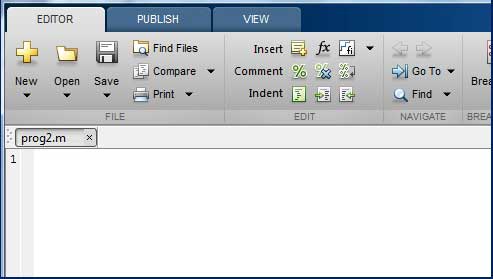
Alternatively, if you are using the IDE, choose NEW -> Script. This also opens the editor and creates a file named Untitled. You can name and save the file after typing the code.
Type the following code in the editor −
NoOfStudents = 6000;
TeachingStaff = 150;
NonTeachingStaff = 20;
Total = NoOfStudents + TeachingStaff ...
+ NonTeachingStaff;
disp(Total);After creating and saving the file, you can run it in two ways −
Clicking the Run button on the editor window or
Just typing the filename (without extension) in the command prompt: >> prog1
The command window prompt displays the result −
6170Example
Create a script file, and type the following code −
a = 5; b = 7;
c = a + b
d = c + sin(b)
e = 5 * d
f = exp(-d)When the above code is compiled and executed, it produces the following result −
c = 12
d = 12.657
e = 63.285
f = 3.1852e-06MATLAB does not require any type declaration or dimension statements. Whenever MATLAB encounters a new variable name, it creates the variable and allocates appropriate memory space.
If the variable already exists, then MATLAB replaces the original content with new content and allocates new storage space, where necessary.
For example,
Total = 42The above statement creates a 1-by-1 matrix named 'Total' and stores the value 42 in it.
Data Types Available in MATLAB
MATLAB provides 15 fundamental data types. Every data type stores data that is in the form of a matrix or array. The size of this matrix or array is a minimum of 0-by-0 and this can grow up to a matrix or array of any size.
The following table shows the most commonly used data types in MATLAB −
| Sr.No. | Data Type & Description |
|---|---|
| 1 | int8 8-bit signed integer |
| 2 | uint8 8-bit unsigned integer |
| 3 | int16 16-bit signed integer |
| 4 | uint16 16-bit unsigned integer |
| 5 | int32 32-bit signed integer |
| 6 | uint32 32-bit unsigned integer |
| 7 | int64 64-bit signed integer |
| 8 | uint64 64-bit unsigned integer |
| 9 | single single precision numerical data |
| 10 | double double precision numerical data |
| 11 | logical logical values of 1 or 0, represent true and false respectively |
| 12 | char character data (strings are stored as vector of characters) |
| 13 | cell array array of indexed cells, each capable of storing an array of a different dimension and data type |
| 14 | structure C-like structures, each structure having named fields capable of storing an array of a different dimension and data type |
| 15 | function handle pointer to a function |
| 16 | user classes objects constructed from a user-defined class |
| 17 | java classes objects constructed from a Java class |
Example
Create a script file with the following code −
str = 'Hello World!'
n = 2345
d = double(n)
un = uint32(789.50)
rn = 5678.92347
c = int32(rn)When the above code is compiled and executed, it produces the following result −
str = Hello World!
n = 2345
d = 2345
un = 790
rn = 5678.9
c = 5679Data Type Conversion
MATLAB provides various functions for converting, a value from one data type to another. The following table shows the data type conversion functions −
| Function | Purpose |
|---|---|
| char | Convert to character array (string) |
| int2str | Convert integer data to string |
| mat2str | Convert matrix to string |
| num2str | Convert number to string |
| str2double | Convert string to double-precision value |
| str2num | Convert string to number |
| native2unicode | Convert numeric bytes to Unicode characters |
| unicode2native | Convert Unicode characters to numeric bytes |
| base2dec | Convert base N number string to decimal number |
| bin2dec | Convert binary number string to decimal number |
| dec2base | Convert decimal to base N number in string |
| dec2bin | Convert decimal to binary number in string |
| dec2hex | Convert decimal to hexadecimal number in string |
| hex2dec | Convert hexadecimal number string to decimal number |
| hex2num | Convert hexadecimal number string to double-precision number |
| num2hex | Convert singles and doubles to IEEE hexadecimal strings |
| cell2mat | Convert cell array to numeric array |
| cell2struct | Convert cell array to structure array |
| cellstr | Create cell array of strings from character array |
| mat2cell | Convert array to cell array with potentially different sized cells |
| num2cell | Convert array to cell array with consistently sized cells |
| struct2cell | Convert structure to cell array |
Determination of Data Types
MATLAB provides various functions for identifying data type of a variable.
Following table provides the functions for determining the data type of a variable −
| Function | Purpose |
|---|---|
| is | Detect state |
| isa | Determine if input is object of specified class |
| iscell | Determine whether input is cell array |
| iscellstr | Determine whether input is cell array of strings |
| ischar | Determine whether item is character array |
| isfield | Determine whether input is structure array field |
| isfloat | Determine if input is floating-point array |
| ishghandle | True for Handle Graphics object handles |
| isinteger | Determine if input is integer array |
| isjava | Determine if input is Java object |
| islogical | Determine if input is logical array |
| isnumeric | Determine if input is numeric array |
| isobject | Determine if input is MATLAB object |
| isreal | Check if input is real array |
| isscalar | Determine whether input is scalar |
| isstr | Determine whether input is character array |
| isstruct | Determine whether input is structure array |
| isvector | Determine whether input is vector |
| class | Determine class of object |
| validateattributes | Check validity of array |
| whos | List variables in workspace, with sizes and types |
Example
Create a script file with the following code −
x = 3
isinteger(x)
isfloat(x)
isvector(x)
isscalar(x)
isnumeric(x)
x = 23.54
isinteger(x)
isfloat(x)
isvector(x)
isscalar(x)
isnumeric(x)
x = [1 2 3]
isinteger(x)
isfloat(x)
isvector(x)
isscalar(x)
x = 'Hello'
isinteger(x)
isfloat(x)
isvector(x)
isscalar(x)
isnumeric(x)When you run the file, it produces the following result −
x = 3
ans = 0
ans = 1
ans = 1
ans = 1
ans = 1
x = 23.540
ans = 0
ans = 1
ans = 1
ans = 1
ans = 1
x =
1 2 3
ans = 0
ans = 1
ans = 1
ans = 0
x = Hello
ans = 0
ans = 0
ans = 1
ans = 0
ans = 0An operator is a symbol that tells the compiler to perform specific mathematical or logical manipulations. MATLAB is designed to operate primarily on whole matrices and arrays. Therefore, operators in MATLAB work both on scalar and non-scalar data. MATLAB allows the following types of elementary operations −
- Arithmetic Operators
- Relational Operators
- Logical Operators
- Bitwise Operations
- Set Operations
Arithmetic Operators
MATLAB allows two different types of arithmetic operations −
- Matrix arithmetic operations
- Array arithmetic operations
Matrix arithmetic operations are same as defined in linear algebra. Array operations are executed element by element, both on one-dimensional and multidimensional array.
The matrix operators and array operators are differentiated by the period (.) symbol. However, as the addition and subtraction operation is same for matrices and arrays, the operator is same for both cases. The following table gives brief description of the operators −
Show Examples
| Sr.No. | Operator & Description |
|---|---|
| 1 | + Addition or unary plus. A+B adds the values stored in variables A and B. A and B must have the same size, unless one is a scalar. A scalar can be added to a matrix of any size. |
| 2 | - Subtraction or unary minus. A-B subtracts the value of B from A. A and B must have the same size, unless one is a scalar. A scalar can be subtracted from a matrix of any size. |
| 3 | * Matrix multiplication. C = A*B is the linear algebraic product of the matrices A and B. More precisely,

For non-scalar A and B, the number of columns of A must be equal to the number of rows of B. A scalar can multiply a matrix of any size. |
| 4 | .* Array multiplication. A.*B is the element-by-element product of the arrays A and B. A and B must have the same size, unless one of them is a scalar. |
| 5 | / Slash or matrix right division. B/A is roughly the same as B*inv(A). More precisely, B/A = (A'\B')'. |
| 6 | ./ Array right division. A./B is the matrix with elements A(i,j)/B(i,j). A and B must have the same size, unless one of them is a scalar. |
| 7 | \ Backslash or matrix left division. If A is a square matrix, A\B is roughly the same as inv(A)*B, except it is computed in a different way. If A is an n-by-n matrix and B is a column vector with n components, or a matrix with several such columns, then X = A\B is the solution to the equation AX = B. A warning message is displayed if A is badly scaled or nearly singular. |
| 8 | .\ Array left division. A.\B is the matrix with elements B(i,j)/A(i,j). A and B must have the same size, unless one of them is a scalar. |
| 9 | ^ Matrix power. X^p is X to the power p, if p is a scalar. If p is an integer, the power is computed by repeated squaring. If the integer is negative, X is inverted first. For other values of p, the calculation involves eigenvalues and eigenvectors, such that if [V,D] = eig(X), then X^p = V*D.^p/V. |
| 10 | .^ Array power. A.^B is the matrix with elements A(i,j) to the B(i,j) power. A and B must have the same size, unless one of them is a scalar. |
| 11 | ' Matrix transpose. A' is the linear algebraic transpose of A. For complex matrices, this is the complex conjugate transpose. |
| 12 | .' Array transpose. A.' is the array transpose of A. For complex matrices, this does not involve conjugation. |
Relational Operators
Relational operators can also work on both scalar and non-scalar data. Relational operators for arrays perform element-by-element comparisons between two arrays and return a logical array of the same size, with elements set to logical 1 (true) where the relation is true and elements set to logical 0 (false) where it is not.
The following table shows the relational operators available in MATLAB −
Show Examples
| Sr.No. | Operator & Description |
|---|---|
| 1 | < Less than |
| 2 | <= Less than or equal to |
| 3 | > Greater than |
| 4 | >= Greater than or equal to |
| 5 | == Equal to |
| 6 | ~= Not equal to |
Logical Operators
MATLAB offers two types of logical operators and functions −
Element-wise − These operators operate on corresponding elements of logical arrays.
Short-circuit − These operators operate on scalar and, logical expressions.
Element-wise logical operators operate element-by-element on logical arrays. The symbols &, |, and ~ are the logical array operators AND, OR, and NOT.
Short-circuit logical operators allow short-circuiting on logical operations. The symbols && and || are the logical short-circuit operators AND and OR.
Show Examples
Bitwise Operations
Bitwise operators work on bits and perform bit-by-bit operation. The truth tables for &, |, and ^ are as follows −
| p | q | p & q | p | q | p ^ q |
|---|---|---|---|---|
| 0 | 0 | 0 | 0 | 0 |
| 0 | 1 | 0 | 1 | 1 |
| 1 | 1 | 1 | 1 | 0 |
| 1 | 0 | 0 | 1 | 1 |
Assume if A = 60; and B = 13; Now in binary format they will be as follows −
A = 0011 1100
B = 0000 1101
-----------------
A&B = 0000 1100
A|B = 0011 1101
A^B = 0011 0001
~A = 1100 0011
MATLAB provides various functions for bit-wise operations like 'bitwise and', 'bitwise or' and 'bitwise not' operations, shift operation, etc.
The following table shows the commonly used bitwise operations −
Show Examples
| Function | Purpose |
|---|---|
| bitand(a, b) | Bit-wise AND of integers a and b |
| bitcmp(a) | Bit-wise complement of a |
| bitget(a,pos) | Get bit at specified position pos, in the integer array a |
| bitor(a, b) | Bit-wise OR of integers a and b |
| bitset(a, pos) | Set bit at specific location pos of a |
| bitshift(a, k) | Returns a shifted to the left by k bits, equivalent to multiplying by 2k. Negative values of k correspond to shifting bits right or dividing by 2|k| and rounding to the nearest integer towards negative infinite. Any overflow bits are truncated. |
| bitxor(a, b) | Bit-wise XOR of integers a and b |
| swapbytes | Swap byte ordering |
Set Operations
MATLAB provides various functions for set operations, like union, intersection and testing for set membership, etc.
The following table shows some commonly used set operations −
Show Examples
| Sr.No. | Function & Description |
|---|---|
| 1 | intersect(A,B) Set intersection of two arrays; returns the values common to both A and B. The values returned are in sorted order. |
| 2 | intersect(A,B,'rows') Treats each row of A and each row of B as single entities and returns the rows common to both A and B. The rows of the returned matrix are in sorted order. |
| 3 | ismember(A,B) Returns an array the same size as A, containing 1 (true) where the elements of A are found in B. Elsewhere, it returns 0 (false). |
| 4 | ismember(A,B,'rows') Treats each row of A and each row of B as single entities and returns a vector containing 1 (true) where the rows of matrix A are also rows of B. Elsewhere, it returns 0 (false). |
| 5 | issorted(A) Returns logical 1 (true) if the elements of A are in sorted order and logical 0 (false) otherwise. Input A can be a vector or an N-by-1 or 1-by-N cell array of strings. A is considered to be sorted if A and the output of sort(A) are equal. |
| 6 | issorted(A, 'rows') Returns logical 1 (true) if the rows of two-dimensional matrix A is in sorted order, and logical 0 (false) otherwise. Matrix A is considered to be sorted if A and the output of sortrows(A) are equal. |
| 7 | setdiff(A,B) Sets difference of two arrays; returns the values in A that are not in B. The values in the returned array are in sorted order. |
| 8 | setdiff(A,B,'rows') Treats each row of A and each row of B as single entities and returns the rows from A that are not in B. The rows of the returned matrix are in sorted order. The 'rows' option does not support cell arrays. |
| 9 | setxor Sets exclusive OR of two arrays |
| 10 | union Sets union of two arrays |
| 11 | unique Unique values in array |
Decision making structures require that the programmer should specify one or more conditions to be evaluated or tested by the program, along with a statement or statements to be executed if the condition is determined to be true, and optionally, other statements to be executed if the condition is determined to be false.
Following is the general form of a typical decision making structure found in most of the programming languages −

MATLAB provides following types of decision making statements. Click the following links to check their detail −
| Sr.No. | Statement & Description |
|---|---|
| 1 | if ... end statement An if ... end statement consists of a boolean expression followed by one or more statements. |
| 2 | if...else...end statement An if statement can be followed by an optional else statement, which executes when the boolean expression is false. |
| 3 | If... elseif...elseif...else...end statements An if statement can be followed by one (or more) optional elseif... and an else statement, which is very useful to test various conditions. |
| 4 | nested if statements You can use one if or elseif statement inside another if or elseif statement(s). |
| 5 | switch statement A switch statement allows a variable to be tested for equality against a list of values. |
| 6 | nested switch statements You can use one switch statement inside another switch statement(s). |
There may be a situation when you need to execute a block of code several number of times. In general, statements are executed sequentially. The first statement in a function is executed first, followed by the second, and so on.
Programming languages provide various control structures that allow for more complicated execution paths.
A loop statement allows us to execute a statement or group of statements multiple times and following is the general form of a loop statement in most of the programming languages −
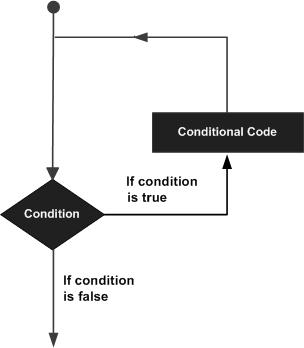
MATLAB provides following types of loops to handle looping requirements. Click the following links to check their detail −
| Sr.No. | Loop Type & Description |
|---|---|
| 1 | while loop Repeats a statement or group of statements while a given condition is true. It tests the condition before executing the loop body. |
| 2 | for loop Executes a sequence of statements multiple times and abbreviates the code that manages the loop variable. |
| 3 | nested loops You can use one or more loops inside any another loop. |
Loop Control Statements
Loop control statements change execution from its normal sequence. When execution leaves a scope, all automatic objects that were created in that scope are destroyed.
MATLAB supports the following control statements. Click the following links to check their detail.
| Sr.No. | Control Statement & Description |
|---|---|
| 1 | break statement Terminates the loop statement and transfers execution to the statement immediately following the loop. |
| 2 | continue statement Causes the loop to skip the remainder of its body and immediately retest its condition prior to reiterating. |
A vector is a one-dimensional array of numbers. MATLAB allows creating two types of vectors −
- Row vectors
- Column vectors
Row Vectors
Row vectors are created by enclosing the set of elements in square brackets, using space or comma to delimit the elements.
r = [7 8 9 10 11]MATLAB will execute the above statement and return the following result −
r =
7 8 9 10 11Column Vectors
Column vectors are created by enclosing the set of elements in square brackets, using semicolon to delimit the elements.
c = [7; 8; 9; 10; 11]MATLAB will execute the above statement and return the following result −
c =
7
8
9
10
11Referencing the Elements of a Vector
You can reference one or more of the elements of a vector in several ways. The ith component of a vector v is referred as v(i). For example −
v = [ 1; 2; 3; 4; 5; 6]; % creating a column vector of 6 elements
v(3)MATLAB will execute the above statement and return the following result −
ans = 3When you reference a vector with a colon, such as v(:), all the components of the vector are listed.
v = [ 1; 2; 3; 4; 5; 6]; % creating a column vector of 6 elements
v(:)MATLAB will execute the above statement and return the following result −
ans =
1
2
3
4
5
6MATLAB allows you to select a range of elements from a vector.
For example, let us create a row vector rv of 9 elements, then we will reference the elements 3 to 7 by writing rv(3:7) and create a new vector named sub_rv.
rv = [1 2 3 4 5 6 7 8 9];
sub_rv = rv(3:7)MATLAB will execute the above statement and return the following result −
sub_rv =
3 4 5 6 7Vector Operations
In this section, let us discuss the following vector operations −
Addition and Subtraction of Vectors
Scalar Multiplication of Vectors
Transpose of a Vector
Appending Vectors
Magnitude of a Vector
Vector Dot Product
Vectors with Uniformly Spaced Elements
A matrix is a two-dimensional array of numbers.
In MATLAB, you create a matrix by entering elements in each row as comma or space delimited numbers and using semicolons to mark the end of each row.
For example, let us create a 4-by-5 matrix a −
a = [ 1 2 3 4 5; 2 3 4 5 6; 3 4 5 6 7; 4 5 6 7 8]MATLAB will execute the above statement and return the following result −
a =
1 2 3 4 5
2 3 4 5 6
3 4 5 6 7
4 5 6 7 8Referencing the Elements of a Matrix
To reference an element in the mth row and nth column, of a matrix mx, we write −
mx(m, n);ยกตัวอย่างเช่นการอ้างถึงองค์ประกอบใน 2 ครั้งที่แถวและ 5 THคอลัมน์ของเมทริกซ์เช่นสร้างในส่วนที่ผ่านมาเราพิมพ์ -
a = [ 1 2 3 4 5; 2 3 4 5 6; 3 4 5 6 7; 4 5 6 7 8];
a(2,5)MATLAB จะดำเนินการตามคำสั่งข้างต้นและส่งกลับผลลัพธ์ต่อไปนี้ -
ans = 6เพื่ออ้างอิงองค์ประกอบทั้งหมดในเมตรTHคอลัมน์เราพิมพ์ A (:, ม.)
ขอให้เราสร้างคอลัมน์เวกเตอร์โวลต์จากองค์ประกอบของ 4 THแถวของเมทริกซ์ -
a = [ 1 2 3 4 5; 2 3 4 5 6; 3 4 5 6 7; 4 5 6 7 8];
v = a(:,4)MATLAB จะดำเนินการตามคำสั่งข้างต้นและส่งกลับผลลัพธ์ต่อไปนี้ -
v =
4
5
6
7คุณยังสามารถเลือกองค์ประกอบในคอลัมน์m thถึง n thสำหรับสิ่งนี้เราเขียน -
a(:,m:n)ให้เราสร้างเมทริกซ์ขนาดเล็กโดยใช้องค์ประกอบจากคอลัมน์ที่สองและสาม -
a = [ 1 2 3 4 5; 2 3 4 5 6; 3 4 5 6 7; 4 5 6 7 8];
a(:, 2:3)MATLAB จะดำเนินการตามคำสั่งข้างต้นและส่งกลับผลลัพธ์ต่อไปนี้ -
ans =
2 3
3 4
4 5
5 6ในทำนองเดียวกันคุณสามารถสร้างเมทริกซ์ย่อยโดยใช้ส่วนย่อยของเมทริกซ์
a = [ 1 2 3 4 5; 2 3 4 5 6; 3 4 5 6 7; 4 5 6 7 8];
a(:, 2:3)MATLAB จะดำเนินการตามคำสั่งข้างต้นและส่งกลับผลลัพธ์ต่อไปนี้ -
ans =
2 3
3 4
4 5
5 6ในทำนองเดียวกันคุณสามารถสร้างเมทริกซ์ย่อยโดยใช้ส่วนย่อยของเมทริกซ์
ยกตัวอย่างให้เราสร้างย่อยเมทริกซ์SAการย่อยภายในของ -
3 4 5
4 5 6หากต้องการทำสิ่งนี้ให้เขียน -
a = [ 1 2 3 4 5; 2 3 4 5 6; 3 4 5 6 7; 4 5 6 7 8];
sa = a(2:3,2:4)MATLAB จะดำเนินการตามคำสั่งข้างต้นและส่งกลับผลลัพธ์ต่อไปนี้ -
sa =
3 4 5
4 5 6การลบแถวหรือคอลัมน์ในเมทริกซ์
คุณสามารถลบทั้งแถวหรือคอลัมน์ของเมทริกซ์ได้โดยกำหนดวงเล็บเหลี่ยมว่าง [] ให้กับแถวหรือคอลัมน์นั้น โดยทั่วไป [] หมายถึงอาร์เรย์ว่าง
ตัวอย่างเช่นให้เราลบแถวที่สี่ของ -
a = [ 1 2 3 4 5; 2 3 4 5 6; 3 4 5 6 7; 4 5 6 7 8];
a( 4 , : ) = []MATLAB จะดำเนินการตามคำสั่งข้างต้นและส่งกลับผลลัพธ์ต่อไปนี้ -
a =
1 2 3 4 5
2 3 4 5 6
3 4 5 6 7ต่อไปให้เราลบคอลัมน์ที่ห้าของ -
a = [ 1 2 3 4 5; 2 3 4 5 6; 3 4 5 6 7; 4 5 6 7 8];
a(: , 5)=[]MATLAB จะดำเนินการตามคำสั่งข้างต้นและส่งกลับผลลัพธ์ต่อไปนี้ -
a =
1 2 3 4
2 3 4 5
3 4 5 6
4 5 6 7ตัวอย่าง
ในตัวอย่างนี้ให้เราสร้างเมทริกซ์ 3 คูณ 3 m จากนั้นเราจะคัดลอกแถวที่สองและสามของเมทริกซ์นี้สองครั้งเพื่อสร้างเมทริกซ์ 4 คูณ 3
สร้างไฟล์สคริปต์ด้วยรหัสต่อไปนี้ -
a = [ 1 2 3 ; 4 5 6; 7 8 9];
new_mat = a([2,3,2,3],:)เมื่อคุณเรียกใช้ไฟล์จะแสดงผลลัพธ์ต่อไปนี้ -
new_mat =
4 5 6
7 8 9
4 5 6
7 8 9การดำเนินการเมทริกซ์
ในส่วนนี้ให้เราพูดถึงการดำเนินการเมทริกซ์พื้นฐานและที่ใช้กันทั่วไปดังต่อไปนี้ -
การบวกและการลบเมทริกซ์
กองเมทริกซ์
การดำเนินงานสเกลาร์ของเมทริกซ์
การเปลี่ยนเมทริกซ์
การเชื่อมต่อเมทริกซ์
การคูณเมทริกซ์
ดีเทอร์มิแนนต์ของเมทริกซ์
ผกผันของเมทริกซ์
ตัวแปรทั้งหมดของชนิดข้อมูลทั้งหมดใน MATLAB คืออาร์เรย์หลายมิติ เวกเตอร์เป็นอาร์เรย์หนึ่งมิติและเมทริกซ์คืออาร์เรย์สองมิติ
เราได้กล่าวถึงเวกเตอร์และเมทริกซ์แล้ว ในบทนี้เราจะกล่าวถึงอาร์เรย์หลายมิติ อย่างไรก็ตามก่อนหน้านั้นให้เราพูดถึงอาร์เรย์ชนิดพิเศษบางประเภท
อาร์เรย์พิเศษใน MATLAB
ในส่วนนี้เราจะพูดถึงฟังก์ชันบางอย่างที่สร้างอาร์เรย์พิเศษบางอย่าง สำหรับฟังก์ชันเหล่านี้อาร์กิวเมนต์เดียวจะสร้างอาร์เรย์สี่เหลี่ยมอาร์กิวเมนต์คู่จะสร้างอาร์เรย์สี่เหลี่ยม
zeros() ฟังก์ชันสร้างอาร์เรย์ของศูนย์ทั้งหมด -
ตัวอย่างเช่น -
zeros(5)MATLAB จะดำเนินการตามคำสั่งข้างต้นและส่งกลับผลลัพธ์ต่อไปนี้ -
ans =
0 0 0 0 0
0 0 0 0 0
0 0 0 0 0
0 0 0 0 0
0 0 0 0 0ones() ฟังก์ชันสร้างอาร์เรย์ของทุกคน -
ตัวอย่างเช่น -
ones(4,3)MATLAB จะดำเนินการตามคำสั่งข้างต้นและส่งกลับผลลัพธ์ต่อไปนี้ -
ans =
1 1 1
1 1 1
1 1 1
1 1 1eye() ฟังก์ชันสร้างเมทริกซ์เอกลักษณ์
ตัวอย่างเช่น -
eye(4)MATLAB จะดำเนินการตามคำสั่งข้างต้นและส่งกลับผลลัพธ์ต่อไปนี้ -
ans =
1 0 0 0
0 1 0 0
0 0 1 0
0 0 0 1rand() ฟังก์ชันสร้างอาร์เรย์ของตัวเลขสุ่มที่กระจายอย่างสม่ำเสมอบน (0,1) -
ตัวอย่างเช่น -
rand(3, 5)MATLAB จะดำเนินการตามคำสั่งข้างต้นและส่งกลับผลลัพธ์ต่อไปนี้ -
ans =
0.8147 0.9134 0.2785 0.9649 0.9572
0.9058 0.6324 0.5469 0.1576 0.4854
0.1270 0.0975 0.9575 0.9706 0.8003จัตุรัสวิเศษ
ก magic square เป็นรูปสี่เหลี่ยมจัตุรัสที่สร้างผลรวมเดียวกันเมื่อองค์ประกอบของมันถูกเพิ่มเป็นแถวฉลาดคอลัมน์หรือแนวทแยงมุม
magic()ฟังก์ชันสร้างอาร์เรย์สี่เหลี่ยมวิเศษ ใช้อาร์กิวเมนต์เอกพจน์ที่ให้ขนาดของกำลังสอง อาร์กิวเมนต์ต้องเป็นสเกลาร์ที่มากกว่าหรือเท่ากับ 3
magic(4)MATLAB จะดำเนินการตามคำสั่งข้างต้นและส่งกลับผลลัพธ์ต่อไปนี้ -
ans =
16 2 3 13
5 11 10 8
9 7 6 12
4 14 15 1อาร์เรย์หลายมิติ
อาร์เรย์ที่มีมากกว่าสองมิติเรียกว่าอาร์เรย์หลายมิติใน MATLAB อาร์เรย์หลายมิติใน MATLAB เป็นส่วนขยายของเมทริกซ์สองมิติปกติ
โดยทั่วไปในการสร้างอาร์เรย์หลายมิติอันดับแรกเราจะสร้างอาร์เรย์สองมิติและขยายออกไป
ตัวอย่างเช่นสร้างอาร์เรย์สองมิติ a
a = [7 9 5; 6 1 9; 4 3 2]MATLAB จะดำเนินการตามคำสั่งข้างต้นและส่งกลับผลลัพธ์ต่อไปนี้ -
a =
7 9 5
6 1 9
4 3 2อาร์เรย์aคืออาร์เรย์3 คูณ 3 เราสามารถเพิ่มมิติที่สามให้กับaโดยระบุค่าเช่น -
a(:, :, 2)= [ 1 2 3; 4 5 6; 7 8 9]MATLAB จะดำเนินการตามคำสั่งข้างต้นและส่งกลับผลลัพธ์ต่อไปนี้ -
a =
ans(:,:,1) =
0 0 0
0 0 0
0 0 0
ans(:,:,2) =
1 2 3
4 5 6
7 8 9นอกจากนี้เรายังสามารถสร้างอาร์เรย์หลายมิติโดยใช้ฟังก์ชัน (), ศูนย์ () หรือฟังก์ชันแรนด์ ()
ตัวอย่างเช่น,
b = rand(4,3,2)MATLAB จะดำเนินการตามคำสั่งข้างต้นและส่งกลับผลลัพธ์ต่อไปนี้ -
b(:,:,1) =
0.0344 0.7952 0.6463
0.4387 0.1869 0.7094
0.3816 0.4898 0.7547
0.7655 0.4456 0.2760
b(:,:,2) =
0.6797 0.4984 0.2238
0.6551 0.9597 0.7513
0.1626 0.3404 0.2551
0.1190 0.5853 0.5060เรายังสามารถใช้ไฟล์ cat()ฟังก์ชันในการสร้างอาร์เรย์หลายมิติ มันเชื่อมรายการอาร์เรย์ตามมิติที่ระบุ -
ไวยากรณ์สำหรับฟังก์ชัน cat () คือ -
B = cat(dim, A1, A2...)ที่ไหน
Bคืออาร์เรย์ใหม่ที่สร้างขึ้น
A1 , A2 , ... คืออาร์เรย์ที่จะเชื่อมต่อกัน
สลัวคือมิติที่จะเชื่อมอาร์เรย์เข้าด้วยกัน
ตัวอย่าง
สร้างไฟล์สคริปต์และพิมพ์รหัสต่อไปนี้ -
a = [9 8 7; 6 5 4; 3 2 1];
b = [1 2 3; 4 5 6; 7 8 9];
c = cat(3, a, b, [ 2 3 1; 4 7 8; 3 9 0])เมื่อคุณเรียกใช้ไฟล์จะแสดง -
c(:,:,1) =
9 8 7
6 5 4
3 2 1
c(:,:,2) =
1 2 3
4 5 6
7 8 9
c(:,:,3) =
2 3 1
4 7 8
3 9 0ฟังก์ชันอาร์เรย์
MATLAB มีฟังก์ชั่นต่อไปนี้ในการเรียงลำดับหมุนเปลี่ยนรูปร่างหรือเปลี่ยนเนื้อหาอาร์เรย์
| ฟังก์ชัน | วัตถุประสงค์ |
|---|---|
| ความยาว | ความยาวของเวกเตอร์หรือมิติอาร์เรย์ที่ใหญ่ที่สุด |
| ndims | จำนวนมิติอาร์เรย์ |
| เลข | จำนวนองค์ประกอบอาร์เรย์ |
| ขนาด | ขนาดอาร์เรย์ |
| iscolumn | กำหนดว่าอินพุตเป็นเวกเตอร์คอลัมน์หรือไม่ |
| มันว่างเปล่า | กำหนดว่าอาร์เรย์ว่างหรือไม่ |
| ismatrix | กำหนดว่าอินพุตเป็นเมทริกซ์หรือไม่ |
| isrow | กำหนดว่าอินพุตเป็นเวกเตอร์แถวหรือไม่ |
| isscalar | กำหนดว่าอินพุตเป็นสเกลาร์หรือไม่ |
| isvector | กำหนดว่าอินพุตเป็นเวกเตอร์หรือไม่ |
| blkdiag | สร้างบล็อกเมทริกซ์แนวทแยงจากอาร์กิวเมนต์อินพุต |
| Circshift | เลื่อนอาร์เรย์เป็นวงกลม |
| ctranspose | ทรานสโพสคอนจูเกตที่ซับซ้อน |
| diag | เมทริกซ์แนวทแยงและเส้นทแยงมุมของเมทริกซ์ |
| ฟลิปดิม | พลิกอาร์เรย์ตามมิติที่ระบุ |
| fliplr | พลิกเมทริกซ์จากซ้ายไปขวา |
| ฟลุด | พลิกเมทริกซ์ขึ้นลง |
| ipermute | ผกผันขนาดอนุญาตของอาร์เรย์ ND |
| อนุญาต | จัดเรียงขนาดของอาร์เรย์ ND ใหม่ |
| repmat | จำลองและเรียงกระเบื้อง |
| ก่อร่างใหม่ | ปรับรูปร่างอาร์เรย์ |
| เน่า 90 | หมุนเมทริกซ์ 90 องศา |
| shiftdim | เปลี่ยนขนาด |
| ถูกจัดเรียง | กำหนดว่าองค์ประกอบชุดอยู่ในลำดับที่จัดเรียงหรือไม่ |
| เรียงลำดับ | เรียงลำดับองค์ประกอบอาร์เรย์จากน้อยไปมากหรือมากไปหาน้อย |
| การเรียงลำดับ | เรียงลำดับแถวจากน้อยไปมาก |
| บีบ | ลบมิติข้อมูลเดี่ยว |
| ทรานสโพส | เปลี่ยน |
| vectorize | Vectorizes นิพจน์ |
ตัวอย่าง
ตัวอย่างต่อไปนี้แสดงให้เห็นถึงฟังก์ชันบางอย่างที่กล่าวถึงข้างต้น
Length, Dimension and Number of elements −
สร้างไฟล์สคริปต์และพิมพ์รหัสต่อไปนี้ -
x = [7.1, 3.4, 7.2, 28/4, 3.6, 17, 9.4, 8.9];
length(x) % length of x vector
y = rand(3, 4, 5, 2);
ndims(y) % no of dimensions in array y
s = ['Zara', 'Nuha', 'Shamim', 'Riz', 'Shadab'];
numel(s) % no of elements in sเมื่อคุณเรียกใช้ไฟล์จะแสดงผลลัพธ์ต่อไปนี้ -
ans = 8
ans = 4
ans = 23Circular Shifting of the Array Elements −
สร้างไฟล์สคริปต์และพิมพ์รหัสต่อไปนี้ -
a = [1 2 3; 4 5 6; 7 8 9] % the original array a
b = circshift(a,1) % circular shift first dimension values down by 1.
c = circshift(a,[1 -1]) % circular shift first dimension values % down by 1
% and second dimension values to the left % by 1.เมื่อคุณเรียกใช้ไฟล์จะแสดงผลลัพธ์ต่อไปนี้ -
a =
1 2 3
4 5 6
7 8 9
b =
7 8 9
1 2 3
4 5 6
c =
8 9 7
2 3 1
5 6 4การเรียงลำดับอาร์เรย์
สร้างไฟล์สคริปต์และพิมพ์รหัสต่อไปนี้ -
v = [ 23 45 12 9 5 0 19 17] % horizontal vector
sort(v) % sorting v
m = [2 6 4; 5 3 9; 2 0 1] % two dimensional array
sort(m, 1) % sorting m along the row
sort(m, 2) % sorting m along the columnเมื่อคุณเรียกใช้ไฟล์จะแสดงผลลัพธ์ต่อไปนี้ -
v =
23 45 12 9 5 0 19 17
ans =
0 5 9 12 17 19 23 45
m =
2 6 4
5 3 9
2 0 1
ans =
2 0 1
2 3 4
5 6 9
ans =
2 4 6
3 5 9
0 1 2อาร์เรย์ของเซลล์
อาร์เรย์ของเซลล์คืออาร์เรย์ของเซลล์ที่จัดทำดัชนีซึ่งแต่ละเซลล์สามารถจัดเก็บอาร์เรย์ของมิติข้อมูลและชนิดข้อมูลที่แตกต่างกันได้
cellฟังก์ชันใช้สำหรับสร้างอาร์เรย์ของเซลล์ ไวยากรณ์สำหรับฟังก์ชันเซลล์คือ -
C = cell(dim)
C = cell(dim1,...,dimN)
D = cell(obj)ที่ไหน
Cคืออาร์เรย์ของเซลล์
dimเป็นจำนวนเต็มสเกลาร์หรือเวกเตอร์ของจำนวนเต็มที่ระบุขนาดของอาร์เรย์เซลล์ C
dim1, ... , dimNเป็นจำนวนเต็มสเกลาร์ที่ระบุขนาดของ C;
objเป็นหนึ่งในสิ่งต่อไปนี้ -
- อาร์เรย์ Java หรือวัตถุ
- อาร์เรย์. NET ประเภท System.String หรือ System.Object
ตัวอย่าง
สร้างไฟล์สคริปต์และพิมพ์รหัสต่อไปนี้ -
c = cell(2, 5);
c = {'Red', 'Blue', 'Green', 'Yellow', 'White'; 1 2 3 4 5}เมื่อคุณเรียกใช้ไฟล์จะแสดงผลลัพธ์ต่อไปนี้ -
c =
{
[1,1] = Red
[2,1] = 1
[1,2] = Blue
[2,2] = 2
[1,3] = Green
[2,3] = 3
[1,4] = Yellow
[2,4] = 4
[1,5] = White
[2,5] = 5
}การเข้าถึงข้อมูลในอาร์เรย์ของเซลล์
มีสองวิธีในการอ้างถึงองค์ประกอบของอาร์เรย์เซลล์ -
- การใส่ดัชนีในวงเล็บแรก () เพื่ออ้างถึงชุดของเซลล์
- การใส่ดัชนีในวงเล็บปีกกา {} เพื่ออ้างถึงข้อมูลภายในเซลล์แต่ละเซลล์
เมื่อคุณใส่ดัชนีในวงเล็บแรกหมายถึงชุดของเซลล์
ดัชนีอาร์เรย์ของเซลล์ในวงเล็บเรียบหมายถึงชุดของเซลล์
ตัวอย่างเช่น -
c = {'Red', 'Blue', 'Green', 'Yellow', 'White'; 1 2 3 4 5};
c(1:2,1:2)MATLAB จะดำเนินการตามคำสั่งข้างต้นและส่งกลับผลลัพธ์ต่อไปนี้ -
ans =
{
[1,1] = Red
[2,1] = 1
[1,2] = Blue
[2,2] = 2
}คุณยังสามารถเข้าถึงเนื้อหาของเซลล์ได้ด้วยการสร้างดัชนีด้วยวงเล็บปีกกา
ตัวอย่างเช่น -
c = {'Red', 'Blue', 'Green', 'Yellow', 'White'; 1 2 3 4 5};
c{1, 2:4}MATLAB จะดำเนินการตามคำสั่งข้างต้นและส่งกลับผลลัพธ์ต่อไปนี้ -
ans = Blue
ans = Green
ans = Yellowcolon(:)เป็นหนึ่งในตัวดำเนินการที่มีประโยชน์ที่สุดใน MATLAB ใช้เพื่อสร้างเวกเตอร์อาร์เรย์ตัวห้อยและspecify for iterations.
หากคุณต้องการสร้างเวกเตอร์แถวที่มีจำนวนเต็มตั้งแต่ 1 ถึง 10 คุณต้องเขียน -
1:10MATLAB รันคำสั่งและส่งกลับเวกเตอร์แถวที่มีจำนวนเต็มตั้งแต่ 1 ถึง 10 -
ans =
1 2 3 4 5 6 7 8 9 10หากคุณต้องการระบุค่าที่เพิ่มขึ้นนอกเหนือจากค่าหนึ่งตัวอย่างเช่น -
100: -5: 50MATLAB รันคำสั่งและส่งกลับผลลัพธ์ต่อไปนี้ -
ans =
100 95 90 85 80 75 70 65 60 55 50ให้เราใช้ตัวอย่างอื่น -
0:pi/8:piMATLAB รันคำสั่งและส่งกลับผลลัพธ์ต่อไปนี้ -
ans =
Columns 1 through 7
0 0.3927 0.7854 1.1781 1.5708 1.9635 2.3562
Columns 8 through 9
2.7489 3.1416คุณสามารถใช้ตัวดำเนินการโคลอนเพื่อสร้างเวกเตอร์ของดัชนีเพื่อเลือกแถวคอลัมน์หรือองค์ประกอบของอาร์เรย์
ตารางต่อไปนี้อธิบายถึงการใช้งานเพื่อจุดประสงค์นี้ (ให้เรามีเมทริกซ์ A) -
| รูปแบบ | วัตถุประสงค์ |
|---|---|
| A(:,j) | คือคอลัมน์ jth ของ A |
| A(i,:) | คือแถวที่หนึ่งของ A |
| A(:,:) | คืออาร์เรย์สองมิติที่เทียบเท่ากัน สำหรับเมทริกซ์นี่เหมือนกับ A |
| A(j:k) | คือ A (j), A (j + 1), ... , A (k) |
| A(:,j:k) | คือ A (:, j), A (:, j + 1), ... , A (:, k) |
| A(:,:,k) | เป็นเคTHหน้าของสามมิติอาร์เรย์ A. |
| A(i,j,k,:) | เป็นเวกเตอร์ในอาร์เรย์สี่มิติ A. เวกเตอร์ประกอบด้วย A (i, j, k, 1), A (i, j, k, 2), A (i, j, k, 3) และอื่น ๆ |
| A(:) | คือองค์ประกอบทั้งหมดของ A ซึ่งถือเป็นคอลัมน์เดียว ทางด้านซ้ายของคำสั่งมอบหมาย A (:) เติม A โดยรักษารูปร่างไว้ก่อน ในกรณีนี้ด้านขวาต้องมีจำนวนองค์ประกอบเท่ากับ A |
ตัวอย่าง
สร้างไฟล์สคริปต์และพิมพ์รหัสต่อไปนี้ -
A = [1 2 3 4; 4 5 6 7; 7 8 9 10]
A(:,2) % second column of A
A(:,2:3) % second and third column of A
A(2:3,2:3) % second and third rows and second and third columnsเมื่อคุณเรียกใช้ไฟล์จะแสดงผลลัพธ์ต่อไปนี้ -
A =
1 2 3 4
4 5 6 7
7 8 9 10
ans =
2
5
8
ans =
2 3
5 6
8 9
ans =
5 6
8 9MATLAB รองรับคลาสตัวเลขต่างๆซึ่งรวมถึงจำนวนเต็มที่ลงชื่อและไม่ได้ลงนามและตัวเลขทศนิยมที่มีความแม่นยำเดียวและความแม่นยำสองเท่า โดยค่าเริ่มต้น MATLAB จะเก็บค่าตัวเลขทั้งหมดเป็นตัวเลขทศนิยมที่มีความแม่นยำสองเท่า
คุณสามารถเลือกจัดเก็บตัวเลขหรืออาร์เรย์ของตัวเลขใด ๆ เป็นจำนวนเต็มหรือเป็นตัวเลขที่มีความแม่นยำเดียว
ประเภทตัวเลขทั้งหมดสนับสนุนการทำงานของอาร์เรย์พื้นฐานและการดำเนินการทางคณิตศาสตร์
การแปลงเป็นข้อมูลตัวเลขประเภทต่างๆ
MATLAB มีฟังก์ชันต่อไปนี้ในการแปลงเป็นข้อมูลตัวเลขประเภทต่างๆ -
| ฟังก์ชัน | วัตถุประสงค์ |
|---|---|
| สองเท่า | แปลงเป็นตัวเลขความแม่นยำสองเท่า |
| โสด | แปลงเป็นตัวเลขความแม่นยำเดียว |
| int8 | แปลงเป็นจำนวนเต็มที่มีลายเซ็น 8 บิต |
| int16 | แปลงเป็นจำนวนเต็ม 16 บิตที่ลงชื่อ |
| int32 | แปลงเป็นจำนวนเต็มลายเซ็น 32 บิต |
| int64 | แปลงเป็นจำนวนเต็ม 64 บิตที่ลงชื่อ |
| uint8 | แปลงเป็นจำนวนเต็ม 8 บิตที่ไม่ได้ลงชื่อ |
| uint16 | แปลงเป็นจำนวนเต็ม 16 บิตที่ไม่ได้ลงชื่อ |
| uint32 | Converts to 32-bit unsigned integer |
| uint64 | Converts to 64-bit unsigned integer |
Example
Create a script file and type the following code −
x = single([5.32 3.47 6.28]) .* 7.5
x = double([5.32 3.47 6.28]) .* 7.5
x = int8([5.32 3.47 6.28]) .* 7.5
x = int16([5.32 3.47 6.28]) .* 7.5
x = int32([5.32 3.47 6.28]) .* 7.5
x = int64([5.32 3.47 6.28]) .* 7.5When you run the file, it shows the following result −
x =
39.900 26.025 47.100
x =
39.900 26.025 47.100
x =
38 23 45
x =
38 23 45
x =
38 23 45
x =
38 23 45Example
Let us extend the previous example a little more. Create a script file and type the following code −
x = int32([5.32 3.47 6.28]) .* 7.5
x = int64([5.32 3.47 6.28]) .* 7.5
x = num2cell(x)When you run the file, it shows the following result −
x =
38 23 45
x =
38 23 45
x =
{
[1,1] = 38
[1,2] = 23
[1,3] = 45
}Smallest and Largest Integers
The functions intmax() and intmin() return the maximum and minimum values that can be represented with all types of integer numbers.
Both the functions take the integer data type as the argument, for example, intmax(int8) or intmin(int64) and return the maximum and minimum values that you can represent with the integer data type.
Example
The following example illustrates how to obtain the smallest and largest values of integers. Create a script file and write the following code in it −
% displaying the smallest and largest signed integer data
str = 'The range for int8 is:\n\t%d to %d ';
sprintf(str, intmin('int8'), intmax('int8'))
str = 'The range for int16 is:\n\t%d to %d ';
sprintf(str, intmin('int16'), intmax('int16'))
str = 'The range for int32 is:\n\t%d to %d ';
sprintf(str, intmin('int32'), intmax('int32'))
str = 'The range for int64 is:\n\t%d to %d ';
sprintf(str, intmin('int64'), intmax('int64'))
% displaying the smallest and largest unsigned integer data
str = 'The range for uint8 is:\n\t%d to %d ';
sprintf(str, intmin('uint8'), intmax('uint8'))
str = 'The range for uint16 is:\n\t%d to %d ';
sprintf(str, intmin('uint16'), intmax('uint16'))
str = 'The range for uint32 is:\n\t%d to %d ';
sprintf(str, intmin('uint32'), intmax('uint32'))
str = 'The range for uint64 is:\n\t%d to %d ';
sprintf(str, intmin('uint64'), intmax('uint64'))When you run the file, it shows the following result −
ans = The range for int8 is:
-128 to 127
ans = The range for int16 is:
-32768 to 32767
ans = The range for int32 is:
-2147483648 to 2147483647
ans = The range for int64 is:
0 to 0
ans = The range for uint8 is:
0 to 255
ans = The range for uint16 is:
0 to 65535
ans = The range for uint32 is:
0 to -1
ans = The range for uint64 is:
0 to 18446744073709551616Smallest and Largest Floating Point Numbers
The functions realmax() and realmin() return the maximum and minimum values that can be represented with floating point numbers.
Both the functions when called with the argument 'single', return the maximum and minimum values that you can represent with the single-precision data type and when called with the argument 'double', return the maximum and minimum values that you can represent with the double-precision data type.
Example
The following example illustrates how to obtain the smallest and largest floating point numbers. Create a script file and write the following code in it −
% displaying the smallest and largest single-precision
% floating point number
str = 'The range for single is:\n\t%g to %g and\n\t %g to %g';
sprintf(str, -realmax('single'), -realmin('single'), ...
realmin('single'), realmax('single'))
% displaying the smallest and largest double-precision
% floating point number
str = 'The range for double is:\n\t%g to %g and\n\t %g to %g';
sprintf(str, -realmax('double'), -realmin('double'), ...
realmin('double'), realmax('double'))When you run the file, it displays the following result −
ans = The range for single is:
-3.40282e+38 to -1.17549e-38 and
1.17549e-38 to 3.40282e+38
ans = The range for double is:
-1.79769e+308 to -2.22507e-308 and
2.22507e-308 to 1.79769e+308Creating a character string is quite simple in MATLAB. In fact, we have used it many times. For example, you type the following in the command prompt −
my_string = 'Tutorials Point'MATLAB will execute the above statement and return the following result −
my_string = Tutorials PointMATLAB considers all variables as arrays, and strings are considered as character arrays. Let us use the whos command to check the variable created above −
whosMATLAB will execute the above statement and return the following result −
Name Size Bytes Class Attributes
my_string 1x16 32 charInterestingly, you can use numeric conversion functions like uint8 or uint16 to convert the characters in the string to their numeric codes. The char function converts the integer vector back to characters −
Example
Create a script file and type the following code into it −
my_string = 'Tutorial''s Point';
str_ascii = uint8(my_string) % 8-bit ascii values
str_back_to_char= char(str_ascii)
str_16bit = uint16(my_string) % 16-bit ascii values
str_back_to_char = char(str_16bit)When you run the file, it displays the following result −
str_ascii =
84 117 116 111 114 105 97 108 39 115 32 80 111 105 110 116
str_back_to_char = Tutorial's Point
str_16bit =
84 117 116 111 114 105 97 108 39 115 32 80 111 105 110 116
str_back_to_char = Tutorial's PointRectangular Character Array
The strings we have discussed so far are one-dimensional character arrays; however, we need to store more than that. We need to store more dimensional textual data in our program. This is achieved by creating rectangular character arrays.
Simplest way of creating a rectangular character array is by concatenating two or more one-dimensional character arrays, either vertically or horizontally as required.
You can combine strings vertically in either of the following ways −
Using the MATLAB concatenation operator [] and separating each row with a semicolon (;). Please note that in this method each row must contain the same number of characters. For strings with different lengths, you should pad with space characters as needed.
Using the char function. If the strings are of different lengths, char pads the shorter strings with trailing blanks so that each row has the same number of characters.
Example
Create a script file and type the following code into it −
doc_profile = ['Zara Ali '; ...
'Sr. Surgeon '; ...
'R N Tagore Cardiology Research Center']
doc_profile = char('Zara Ali', 'Sr. Surgeon', ...
'RN Tagore Cardiology Research Center')When you run the file, it displays the following result −
doc_profile =
Zara Ali
Sr. Surgeon
R N Tagore Cardiology Research Center
doc_profile =
Zara Ali
Sr. Surgeon
RN Tagore Cardiology Research CenterYou can combine strings horizontally in either of the following ways −
Using the MATLAB concatenation operator, [] and separating the input strings with a comma or a space. This method preserves any trailing spaces in the input arrays.
Using the string concatenation function, strcat. This method removes trailing spaces in the inputs.
Example
Create a script file and type the following code into it −
name = 'Zara Ali ';
position = 'Sr. Surgeon ';
worksAt = 'R N Tagore Cardiology Research Center';
profile = [name ', ' position ', ' worksAt]
profile = strcat(name, ', ', position, ', ', worksAt)When you run the file, it displays the following result −
profile = Zara Ali , Sr. Surgeon , R N Tagore Cardiology Research Center
profile = Zara Ali,Sr. Surgeon,R N Tagore Cardiology Research CenterCombining Strings into a Cell Array
From our previous discussion, it is clear that combining strings with different lengths could be a pain as all strings in the array has to be of the same length. We have used blank spaces at the end of strings to equalize their length.
However, a more efficient way to combine the strings is to convert the resulting array into a cell array.
MATLAB cell array can hold different sizes and types of data in an array. Cell arrays provide a more flexible way to store strings of varying length.
The cellstr function converts a character array into a cell array of strings.
Example
Create a script file and type the following code into it −
name = 'Zara Ali ';
position = 'Sr. Surgeon ';
worksAt = 'R N Tagore Cardiology Research Center';
profile = char(name, position, worksAt);
profile = cellstr(profile);
disp(profile)When you run the file, it displays the following result −
{
[1,1] = Zara Ali
[2,1] = Sr. Surgeon
[3,1] = R N Tagore Cardiology Research Center
}String Functions in MATLAB
MATLAB provides numerous string functions creating, combining, parsing, comparing and manipulating strings.
Following table provides brief description of the string functions in MATLAB −
| Function | Purpose |
|---|---|
| Functions for storing text in character arrays, combine character arrays, etc. | |
| blanks | Create string of blank characters |
| cellstr | Create cell array of strings from character array |
| char | Convert to character array (string) |
| iscellstr | Determine whether input is cell array of strings |
| ischar | Determine whether item is character array |
| sprintf | Format data into string |
| strcat | Concatenate strings horizontally |
| strjoin | Join strings in cell array into single string |
| Functions for identifying parts of strings, find and replace substrings | |
| ischar | Determine whether item is character array |
| isletter | Array elements that are alphabetic letters |
| isspace | Array elements that are space characters |
| isstrprop | Determine whether string is of specified category |
| sscanf | Read formatted data from string |
| strfind | Find one string within another |
| strrep | Find and replace substring |
| strsplit | Split string at specified delimiter |
| strtok | Selected parts of string |
| validatestring | Check validity of text string |
| symvar | Determine symbolic variables in expression |
| regexp | Match regular expression (case sensitive) |
| regexpi | Match regular expression (case insensitive) |
| regexprep | Replace string using regular expression |
| regexptranslate | Translate string into regular expression |
| Functions for string comparison | |
| strcmp | Compare strings (case sensitive) |
| strcmpi | Compare strings (case insensitive) |
| strncmp | Compare first n characters of strings (case sensitive) |
| strncmpi | Compare first n characters of strings (case insensitive) |
| Functions for changing string to upper- or lowercase, creating or removing white space | |
| deblank | Strip trailing blanks from end of string |
| strtrim | Remove leading and trailing white space from string |
| lower | Convert string to lowercase |
| upper | Convert string to uppercase |
| strjust | Justify character array |
Examples
The following examples illustrate some of the above-mentioned string functions −
Formatting Strings
Create a script file and type the following code into it −
A = pi*1000*ones(1,5);
sprintf(' %f \n %.2f \n %+.2f \n %12.2f \n %012.2f \n', A)When you run the file, it displays the following result −
ans = 3141.592654
3141.59
+3141.59
3141.59
000003141.59Joining Strings
Create a script file and type the following code into it −
%cell array of strings
str_array = {'red','blue','green', 'yellow', 'orange'};
% Join strings in cell array into single string
str1 = strjoin(str_array, "-")
str2 = strjoin(str_array, ",")When you run the file, it displays the following result −
str1 = red-blue-green-yellow-orange
str2 = red,blue,green,yellow,orangeFinding and Replacing Strings
Create a script file and type the following code into it −
students = {'Zara Ali', 'Neha Bhatnagar', ...
'Monica Malik', 'Madhu Gautam', ...
'Madhu Sharma', 'Bhawna Sharma',...
'Nuha Ali', 'Reva Dutta', ...
'Sunaina Ali', 'Sofia Kabir'};
% The strrep function searches and replaces sub-string.
new_student = strrep(students(8), 'Reva', 'Poulomi')
% Display first names
first_names = strtok(students)When you run the file, it displays the following result −
new_student =
{
[1,1] = Poulomi Dutta
}
first_names =
{
[1,1] = Zara
[1,2] = Neha
[1,3] = Monica
[1,4] = Madhu
[1,5] = Madhu
[1,6] = Bhawna
[1,7] = Nuha
[1,8] = Reva
[1,9] = Sunaina
[1,10] = Sofia
}Comparing Strings
Create a script file and type the following code into it −
str1 = 'This is test'
str2 = 'This is text'
if (strcmp(str1, str2))
sprintf('%s and %s are equal', str1, str2)
else
sprintf('%s and %s are not equal', str1, str2)
endWhen you run the file, it displays the following result −
str1 = This is test
str2 = This is text
ans = This is test and This is text are not equalA function is a group of statements that together perform a task. In MATLAB, functions are defined in separate files. The name of the file and of the function should be the same.
Functions operate on variables within their own workspace, which is also called the local workspace, separate from the workspace you access at the MATLAB command prompt which is called the base workspace.
Functions can accept more than one input arguments and may return more than one output arguments.
Syntax of a function statement is −
function [out1,out2, ..., outN] = myfun(in1,in2,in3, ..., inN)Example
The following function named mymax should be written in a file named mymax.m. It takes five numbers as argument and returns the maximum of the numbers.
Create a function file, named mymax.m and type the following code in it −
function max = mymax(n1, n2, n3, n4, n5)
%This function calculates the maximum of the
% five numbers given as input
max = n1;
if(n2 > max)
max = n2;
end
if(n3 > max)
max = n3;
end
if(n4 > max)
max = n4;
end
if(n5 > max)
max = n5;
endThe first line of a function starts with the keyword function. It gives the name of the function and order of arguments. In our example, the mymax function has five input arguments and one output argument.
The comment lines that come right after the function statement provide the help text. These lines are printed when you type −
help mymaxMATLAB will execute the above statement and return the following result −
This function calculates the maximum of the
five numbers given as inputYou can call the function as −
mymax(34, 78, 89, 23, 11)MATLAB will execute the above statement and return the following result −
ans = 89Anonymous Functions
An anonymous function is like an inline function in traditional programming languages, defined within a single MATLAB statement. It consists of a single MATLAB expression and any number of input and output arguments.
You can define an anonymous function right at the MATLAB command line or within a function or script.
This way you can create simple functions without having to create a file for them.
The syntax for creating an anonymous function from an expression is
f = @(arglist)expressionExample
In this example, we will write an anonymous function named power, which will take two numbers as input and return first number raised to the power of the second number.
Create a script file and type the following code in it −
power = @(x, n) x.^n;
result1 = power(7, 3)
result2 = power(49, 0.5)
result3 = power(10, -10)
result4 = power (4.5, 1.5)When you run the file, it displays −
result1 = 343
result2 = 7
result3 = 1.0000e-10
result4 = 9.5459Primary and Sub-Functions
Any function other than an anonymous function must be defined within a file. Each function file contains a required primary function that appears first and any number of optional sub-functions that comes after the primary function and used by it.
Primary functions can be called from outside of the file that defines them, either from command line or from other functions, but sub-functions cannot be called from command line or other functions, outside the function file.
Sub-functions are visible only to the primary function and other sub-functions within the function file that defines them.
Example
Let us write a function named quadratic that would calculate the roots of a quadratic equation. The function would take three inputs, the quadratic co-efficient, the linear co-efficient and the constant term. It would return the roots.
The function file quadratic.m will contain the primary function quadratic and the sub-function disc, which calculates the discriminant.
Create a function file quadratic.m and type the following code in it −
function [x1,x2] = quadratic(a,b,c)
%this function returns the roots of
% a quadratic equation.
% It takes 3 input arguments
% which are the co-efficients of x2, x and the
%constant term
% It returns the roots
d = disc(a,b,c);
x1 = (-b + d) / (2*a);
x2 = (-b - d) / (2*a);
end % end of quadratic
function dis = disc(a,b,c)
%function calculates the discriminant
dis = sqrt(b^2 - 4*a*c);
end % end of sub-functionYou can call the above function from command prompt as −
quadratic(2,4,-4)MATLAB will execute the above statement and return the following result −
ans = 0.7321Nested Functions
You can define functions within the body of another function. These are called nested functions. A nested function contains any or all of the components of any other function.
Nested functions are defined within the scope of another function and they share access to the containing function's workspace.
A nested function follows the following syntax −
function x = A(p1, p2)
...
B(p2)
function y = B(p3)
...
end
...
endExample
Let us rewrite the function quadratic, from previous example, however, this time the disc function will be a nested function.
Create a function file quadratic2.m and type the following code in it −
function [x1,x2] = quadratic2(a,b,c)
function disc % nested function
d = sqrt(b^2 - 4*a*c);
end % end of function disc
disc;
x1 = (-b + d) / (2*a);
x2 = (-b - d) / (2*a);
end % end of function quadratic2You can call the above function from command prompt as −
quadratic2(2,4,-4)MATLAB will execute the above statement and return the following result −
ans = 0.73205Private Functions
A private function is a primary function that is visible only to a limited group of other functions. If you do not want to expose the implementation of a function(s), you can create them as private functions.
Private functions reside in subfolders with the special name private.
They are visible only to functions in the parent folder.
Example
Let us rewrite the quadratic function. This time, however, the disc function calculating the discriminant, will be a private function.
Create a subfolder named private in working directory. Store the following function file disc.m in it −
function dis = disc(a,b,c)
%function calculates the discriminant
dis = sqrt(b^2 - 4*a*c);
end % end of sub-functionCreate a function quadratic3.m in your working directory and type the following code in it −
function [x1,x2] = quadratic3(a,b,c)
%this function returns the roots of
% a quadratic equation.
% It takes 3 input arguments
% which are the co-efficient of x2, x and the
%constant term
% It returns the roots
d = disc(a,b,c);
x1 = (-b + d) / (2*a);
x2 = (-b - d) / (2*a);
end % end of quadratic3You can call the above function from command prompt as −
quadratic3(2,4,-4)MATLAB will execute the above statement and return the following result −
ans = 0.73205Global Variables
Global variables can be shared by more than one function. For this, you need to declare the variable as global in all the functions.
If you want to access that variable from the base workspace, then declare the variable at the command line.
The global declaration must occur before the variable is actually used in a function. It is a good practice to use capital letters for the names of global variables to distinguish them from other variables.
Example
Let us create a function file named average.m and type the following code in it −
function avg = average(nums)
global TOTAL
avg = sum(nums)/TOTAL;
endCreate a script file and type the following code in it −
global TOTAL;
TOTAL = 10;
n = [34, 45, 25, 45, 33, 19, 40, 34, 38, 42];
av = average(n)When you run the file, it will display the following result −
av = 35.500Importing data in MATLAB means loading data from an external file. The importdata function allows loading various data files of different formats. It has the following five forms −
| Sr.No. | Function & Description |
|---|---|
| 1 | A = importdata(filename) Loads data into array A from the file denoted by filename. |
| 2 | A = importdata('-pastespecial') Loads data from the system clipboard rather than from a file. |
| 3 | A = importdata(___, delimiterIn) Interprets delimiterIn as the column separator in ASCII file, filename, or the clipboard data. You can use delimiterIn with any of the input arguments in the above syntaxes. |
| 4 | A = importdata(___, delimiterIn, headerlinesIn) Loads data from ASCII file, filename, or the clipboard, reading numeric data starting from line headerlinesIn+1. |
| 5 | [A, delimiterOut, headerlinesOut] = importdata(___) Returns the detected delimiter character for the input ASCII file in delimiterOut and the detected number of header lines in headerlinesOut, using any of the input arguments in the previous syntaxes. |
By default, Octave does not have support for importdata() function, so you will have to search and install this package to make following examples work with your Octave installation.
Example 1
Let us load and display an image file. Create a script file and type the following code in it −
filename = 'smile.jpg';
A = importdata(filename);
image(A);When you run the file, MATLAB displays the image file. However, you must store it in the current directory.

Example 2
In this example, we import a text file and specify Delimiter and Column Header. Let us create a space-delimited ASCII file with column headers, named weeklydata.txt.
Our text file weeklydata.txt looks like this −
SunDay MonDay TuesDay WednesDay ThursDay FriDay SaturDay
95.01 76.21 61.54 40.57 55.79 70.28 81.53
73.11 45.65 79.19 93.55 75.29 69.87 74.68
60.68 41.85 92.18 91.69 81.32 90.38 74.51
48.60 82.14 73.82 41.03 0.99 67.22 93.18
89.13 44.47 57.63 89.36 13.89 19.88 46.60Create a script file and type the following code in it −
filename = 'weeklydata.txt';
delimiterIn = ' ';
headerlinesIn = 1;
A = importdata(filename,delimiterIn,headerlinesIn);
% View data
for k = [1:7]
disp(A.colheaders{1, k})
disp(A.data(:, k))
disp(' ')
endWhen you run the file, it displays the following result −
SunDay
95.0100
73.1100
60.6800
48.6000
89.1300
MonDay
76.2100
45.6500
41.8500
82.1400
44.4700
TuesDay
61.5400
79.1900
92.1800
73.8200
57.6300
WednesDay
40.5700
93.5500
91.6900
41.0300
89.3600
ThursDay
55.7900
75.2900
81.3200
0.9900
13.8900
FriDay
70.2800
69.8700
90.3800
67.2200
19.8800
SaturDay
81.5300
74.6800
74.5100
93.1800
46.6000ตัวอย่างที่ 3
ในตัวอย่างนี้ให้เรานำเข้าข้อมูลจากคลิปบอร์ด
คัดลอกบรรทัดต่อไปนี้ไปยังคลิปบอร์ด -
Mathematics is simple
สร้างไฟล์สคริปต์และพิมพ์รหัสต่อไปนี้ -
A = importdata('-pastespecial')เมื่อคุณเรียกใช้ไฟล์จะแสดงผลลัพธ์ต่อไปนี้ -
A =
'Mathematics is simple'ไฟล์ระดับต่ำ I / O
IMPORTDATAฟังก์ชั่นการทำงานระดับสูง ฟังก์ชัน I / O ของไฟล์ระดับต่ำใน MATLAB ช่วยให้สามารถควบคุมการอ่านหรือเขียนข้อมูลไปยังไฟล์ได้มากที่สุด อย่างไรก็ตามฟังก์ชันเหล่านี้ต้องการข้อมูลโดยละเอียดเพิ่มเติมเกี่ยวกับไฟล์ของคุณเพื่อให้ทำงานได้อย่างมีประสิทธิภาพ
MATLAB มีฟังก์ชันต่อไปนี้สำหรับการอ่านและเขียนในระดับไบต์หรืออักขระ -
| ฟังก์ชัน | คำอธิบาย |
|---|---|
| fclose | ปิดไฟล์ที่เปิดอยู่หนึ่งไฟล์หรือทั้งหมด |
| feof | ทดสอบ end-of-file |
| เฟอร์รารี่ | ข้อมูลเกี่ยวกับข้อผิดพลาด I / O ของไฟล์ |
| fgetl | อ่านบรรทัดจากไฟล์ลบอักขระขึ้นบรรทัดใหม่ |
| fgets | อ่านบรรทัดจากไฟล์โดยรักษาอักขระขึ้นบรรทัดใหม่ |
| fopen | เปิดไฟล์หรือรับข้อมูลเกี่ยวกับไฟล์ที่เปิด |
| fprintf | เขียนข้อมูลลงในไฟล์ข้อความ |
| เฟรด | อ่านข้อมูลจากไฟล์ไบนารี |
| frewind | ย้ายตัวบ่งชี้ตำแหน่งไฟล์ไปที่จุดเริ่มต้นของไฟล์ที่เปิด |
| fscanf | อ่านข้อมูลจากไฟล์ข้อความ |
| fseek | ย้ายไปยังตำแหน่งที่ระบุในไฟล์ |
| ftell | ตำแหน่งในไฟล์ที่เปิด |
| fwrite | เขียนข้อมูลลงในไฟล์ไบนารี |
นำเข้าไฟล์ข้อมูลข้อความด้วย I / O ระดับต่ำ
MATLAB มีฟังก์ชันต่อไปนี้สำหรับการนำเข้าไฟล์ข้อมูลข้อความในระดับต่ำ -
fscanf ฟังก์ชันอ่านข้อมูลที่จัดรูปแบบในไฟล์ข้อความหรือไฟล์ ASCII
fgetl และ fgets ฟังก์ชั่นอ่านทีละบรรทัดของไฟล์โดยที่อักขระขึ้นบรรทัดใหม่จะแยกแต่ละบรรทัด
fread ฟังก์ชันอ่านกระแสข้อมูลในระดับไบต์หรือบิต
ตัวอย่าง
เรามีไฟล์ข้อมูลข้อความ 'myfile.txt' ที่บันทึกไว้ในไดเร็กทอรีการทำงานของเรา ไฟล์เก็บข้อมูลปริมาณน้ำฝนเป็นเวลาสามเดือน มิถุนายนกรกฎาคมและสิงหาคมปี 2555
ข้อมูลใน myfile.txt ประกอบด้วยชุดเวลาเดือนและการวัดปริมาณน้ำฝนซ้ำ ๆ กันที่ห้าแห่ง ข้อมูลส่วนหัวเก็บจำนวนเดือน M; ดังนั้นเราจึงมีชุดการวัด M
ไฟล์มีลักษณะดังนี้ -
Rainfall Data
Months: June, July, August
M = 3
12:00:00
June-2012
17.21 28.52 39.78 16.55 23.67
19.15 0.35 17.57 NaN 12.01
17.92 28.49 17.40 17.06 11.09
9.59 9.33 NaN 0.31 0.23
10.46 13.17 NaN 14.89 19.33
20.97 19.50 17.65 14.45 14.00
18.23 10.34 17.95 16.46 19.34
09:10:02
July-2012
12.76 16.94 14.38 11.86 16.89
20.46 23.17 NaN 24.89 19.33
30.97 49.50 47.65 24.45 34.00
18.23 30.34 27.95 16.46 19.34
30.46 33.17 NaN 34.89 29.33
30.97 49.50 47.65 24.45 34.00
28.67 30.34 27.95 36.46 29.34
15:03:40
August-2012
17.09 16.55 19.59 17.25 19.22
17.54 11.45 13.48 22.55 24.01
NaN 21.19 25.85 25.05 27.21
26.79 24.98 12.23 16.99 18.67
17.54 11.45 13.48 22.55 24.01
NaN 21.19 25.85 25.05 27.21
26.79 24.98 12.23 16.99 18.67เราจะนำเข้าข้อมูลจากไฟล์นี้และแสดงข้อมูลนี้ ทำตามขั้นตอนต่อไปนี้ -
เปิดไฟล์ด้วย fopen ฟังก์ชั่นและรับตัวระบุไฟล์
อธิบายข้อมูลในไฟล์ด้วย format specifiersเช่น '%s'สำหรับสตริง'%d'สำหรับจำนวนเต็มหรือ'%f'สำหรับตัวเลขทศนิยม
หากต้องการข้ามอักขระลิเทอรัลในไฟล์ให้รวมไว้ในคำอธิบายรูปแบบ หากต้องการข้ามช่องข้อมูลให้ใช้เครื่องหมายดอกจัน ('*') ในตัวระบุ
ตัวอย่างเช่นในการอ่านส่วนหัวและส่งคืนค่าเดียวสำหรับ M เราเขียน -
M = fscanf(fid, '%*s %*s\n%*s %*s %*s %*s\nM=%d\n\n', 1);โดยค่าเริ่มต้น, fscanfอ่านข้อมูลตามคำอธิบายรูปแบบของเราจนกว่าจะไม่พบข้อมูลใด ๆ ที่ตรงกันหรือไปถึงจุดสิ้นสุดของไฟล์ ในที่นี้เราจะใช้สำหรับการวนซ้ำสำหรับการอ่านข้อมูล 3 ชุดและแต่ละครั้งจะอ่าน 7 แถวและ 5 คอลัมน์
เราจะสร้างโครงสร้างชื่อmydataในพื้นที่ทำงานเพื่อเก็บข้อมูลที่อ่านจากไฟล์ โครงสร้างนี้มีสามช่อง - เวลา , เดือนและraindataอาร์เรย์
สร้างไฟล์สคริปต์และพิมพ์รหัสต่อไปนี้ -
filename = '/data/myfile.txt';
rows = 7;
cols = 5;
% open the file
fid = fopen(filename);
% read the file headers, find M (number of months)
M = fscanf(fid, '%*s %*s\n%*s %*s %*s %*s\nM=%d\n\n', 1);
% read each set of measurements
for n = 1:M
mydata(n).time = fscanf(fid, '%s', 1);
mydata(n).month = fscanf(fid, '%s', 1);
% fscanf fills the array in column order,
% so transpose the results
mydata(n).raindata = ...
fscanf(fid, '%f', [rows, cols]);
end
for n = 1:M
disp(mydata(n).time), disp(mydata(n).month)
disp(mydata(n).raindata)
end
% close the file
fclose(fid);เมื่อคุณเรียกใช้ไฟล์จะแสดงผลลัพธ์ต่อไปนี้ -
12:00:00
June-2012
17.2100 17.5700 11.0900 13.1700 14.4500
28.5200 NaN 9.5900 NaN 14.0000
39.7800 12.0100 9.3300 14.8900 18.2300
16.5500 17.9200 NaN 19.3300 10.3400
23.6700 28.4900 0.3100 20.9700 17.9500
19.1500 17.4000 0.2300 19.5000 16.4600
0.3500 17.0600 10.4600 17.6500 19.3400
09:10:02
July-2012
12.7600 NaN 34.0000 33.1700 24.4500
16.9400 24.8900 18.2300 NaN 34.0000
14.3800 19.3300 30.3400 34.8900 28.6700
11.8600 30.9700 27.9500 29.3300 30.3400
16.8900 49.5000 16.4600 30.9700 27.9500
20.4600 47.6500 19.3400 49.5000 36.4600
23.1700 24.4500 30.4600 47.6500 29.3400
15:03:40
August-2012
17.0900 13.4800 27.2100 11.4500 25.0500
16.5500 22.5500 26.7900 13.4800 27.2100
19.5900 24.0100 24.9800 22.5500 26.7900
17.2500 NaN 12.2300 24.0100 24.9800
19.2200 21.1900 16.9900 NaN 12.2300
17.5400 25.8500 18.6700 21.1900 16.9900
11.4500 25.0500 17.5400 25.8500 18.6700การส่งออกข้อมูล (หรือเอาต์พุต) ใน MATLAB หมายถึงการเขียนลงในไฟล์ MATLAB อนุญาตให้คุณใช้ข้อมูลของคุณในแอปพลิเคชันอื่นที่อ่านไฟล์ ASCII สำหรับสิ่งนี้ MATLAB มีตัวเลือกการส่งออกข้อมูลมากมาย
คุณสามารถสร้างไฟล์ประเภทต่อไปนี้ -
ไฟล์ข้อมูล ASCII ที่คั่นด้วยรูปสี่เหลี่ยมจากอาร์เรย์
ไฟล์ Diary (หรือบันทึก) ของการกดแป้นพิมพ์และเอาต์พุตข้อความที่เป็นผลลัพธ์
ไฟล์ ASCII เฉพาะโดยใช้ฟังก์ชันระดับต่ำเช่น fprintf
ไฟล์ MEX เพื่อเข้าถึงรูทีน C / C ++ หรือ Fortran ของคุณที่เขียนลงในรูปแบบไฟล์ข้อความเฉพาะ
นอกจากนี้คุณยังสามารถส่งออกข้อมูลไปยังสเปรดชีตได้อีกด้วย
มีสองวิธีในการส่งออกอาร์เรย์ตัวเลขเป็นไฟล์ข้อมูล ASCII ที่มีตัวคั่น -
ใช้ save ฟังก์ชันและระบุไฟล์ -ascii รอบคัดเลือก
ใช้ dlmwrite ฟังก์ชัน
ไวยากรณ์สำหรับการใช้ฟังก์ชันบันทึกคือ -
save my_data.out num_array -asciiโดยที่my_data.outคือไฟล์ข้อมูล ASCII ที่ใช้ตัวคั่นที่สร้างขึ้นnum_arrayคืออาร์เรย์ตัวเลขและ−ascii เป็นตัวระบุ
ไวยากรณ์สำหรับการใช้ dlmwrite ฟังก์ชันคือ -
dlmwrite('my_data.out', num_array, 'dlm_char')โดยที่my_data.outคือไฟล์ข้อมูล ASCII ที่ใช้ตัวคั่นที่สร้างขึ้นnum_arrayคืออาร์เรย์ตัวเลขและdlm_charเป็นอักขระตัวคั่น
ตัวอย่าง
ตัวอย่างต่อไปนี้แสดงให้เห็นถึงแนวคิด สร้างไฟล์สคริปต์และพิมพ์รหัสต่อไปนี้ -
num_array = [ 1 2 3 4 ; 4 5 6 7; 7 8 9 0];
save array_data1.out num_array -ascii;
type array_data1.out
dlmwrite('array_data2.out', num_array, ' ');
type array_data2.outเมื่อคุณเรียกใช้ไฟล์จะแสดงผลลัพธ์ต่อไปนี้ -
1.0000000e+00 2.0000000e+00 3.0000000e+00 4.0000000e+00
4.0000000e+00 5.0000000e+00 6.0000000e+00 7.0000000e+00
7.0000000e+00 8.0000000e+00 9.0000000e+00 0.0000000e+00
1 2 3 4
4 5 6 7
7 8 9 0โปรดทราบว่าคำสั่ง save -ascii และฟังก์ชัน dlmwrite ไม่ทำงานกับอาร์เรย์ของเซลล์เป็นอินพุต ในการสร้างไฟล์ ASCII ที่มีตัวคั่นจากเนื้อหาของอาร์เรย์เซลล์คุณสามารถทำได้
แปลงอาร์เรย์ของเซลล์เป็นเมทริกซ์โดยใช้ cell2mat ฟังก์ชัน
หรือส่งออกอาร์เรย์เซลล์โดยใช้ฟังก์ชัน I / O ไฟล์ระดับต่ำ
หากคุณใช้ไฟล์ save ฟังก์ชันในการเขียนอาร์เรย์อักขระไปยังไฟล์ ASCII โดยจะเขียนอักขระที่เทียบเท่ากับ ASCII ไปยังไฟล์
ตัวอย่างเช่นให้เราเขียนคำว่า 'สวัสดี' ลงในไฟล์ -
h = 'hello';
save textdata.out h -ascii
type textdata.outMATLAB รันข้อความข้างต้นและแสดงผลลัพธ์ต่อไปนี้ ซึ่งเป็นอักขระของสตริง 'hello' ในรูปแบบ ASCII 8 หลัก
1.0400000e+02 1.0100000e+02 1.0800000e+02 1.0800000e+02 1.1100000e+02การเขียนลงในไฟล์ Diary
ไฟล์ไดอารี่คือบันทึกกิจกรรมของเซสชัน MATLAB ของคุณ ฟังก์ชันไดอารี่จะสร้างสำเนาเซสชันของคุณในไฟล์ดิสก์โดยไม่รวมกราฟิก
หากต้องการเปิดฟังก์ชันไดอารี่ให้พิมพ์ -
diaryหรือคุณสามารถตั้งชื่อไฟล์บันทึกได้โดยพูดว่า -
diary logdata.outวิธีปิดฟังก์ชั่นไดอารี่ -
diary offคุณสามารถเปิดไฟล์ไดอารี่ในโปรแกรมแก้ไขข้อความ
การส่งออกข้อมูลไปยังไฟล์ข้อมูลข้อความด้วย I / O ระดับต่ำ
จนถึงขณะนี้เราได้ส่งออกอาร์เรย์ตัวเลข อย่างไรก็ตามคุณอาจต้องสร้างไฟล์ข้อความอื่น ๆ รวมทั้งข้อมูลตัวเลขและตัวอักษรรวมกันไฟล์เอาต์พุตที่ไม่ถูกต้องหรือไฟล์ที่มีรูปแบบการเข้ารหัสที่ไม่ใช่ ASCII สำหรับวัตถุประสงค์เหล่านี้ MATLAB ให้บริการระดับต่ำfprintf ฟังก์ชัน
เช่นเดียวกับในกิจกรรมไฟล์ I / O ระดับต่ำก่อนที่จะส่งออกคุณต้องเปิดหรือสร้างไฟล์ด้วยนามสกุล fopenฟังก์ชั่นและรับตัวระบุไฟล์ ตามค่าเริ่มต้น fopen จะเปิดไฟล์สำหรับการเข้าถึงแบบอ่านอย่างเดียว คุณควรระบุสิทธิ์ในการเขียนหรือต่อท้ายเช่น 'w' หรือ 'a'
หลังจากประมวลผลไฟล์แล้วคุณต้องปิดไฟล์ด้วย fclose(fid) ฟังก์ชัน
ตัวอย่างต่อไปนี้แสดงให้เห็นถึงแนวคิด -
ตัวอย่าง
สร้างไฟล์สคริปต์และพิมพ์รหัสต่อไปนี้ -
% create a matrix y, with two rows
x = 0:10:100;
y = [x; log(x)];
% open a file for writing
fid = fopen('logtable.txt', 'w');
% Table Header
fprintf(fid, 'Log Function\n\n');
% print values in column order
% two values appear on each row of the file
fprintf(fid, '%f %f\n', y);
fclose(fid);
% display the file created
type logtable.txtเมื่อคุณเรียกใช้ไฟล์จะแสดงผลลัพธ์ต่อไปนี้ -
Log Function
0.000000 -Inf
10.000000 2.302585
20.000000 2.995732
30.000000 3.401197
40.000000 3.688879
50.000000 3.912023
60.000000 4.094345
70.000000 4.248495
80.000000 4.382027
90.000000 4.499810
100.000000 4.605170ในการลงจุดกราฟของฟังก์ชันคุณต้องทำตามขั้นตอนต่อไปนี้ -
กำหนด xโดยระบุไฟล์ range of values สำหรับตัวแปร xซึ่งจะมีการพล็อตฟังก์ชัน
กำหนดฟังก์ชัน y = f(x)
โทร plot คำสั่งเป็น plot(x, y)
ตัวอย่างต่อไปนี้จะแสดงให้เห็นถึงแนวคิด ให้เราพล็อตฟังก์ชันง่ายๆy = x สำหรับช่วงของค่าสำหรับ x ตั้งแต่ 0 ถึง 100 โดยเพิ่มขึ้น 5
สร้างไฟล์สคริปต์และพิมพ์รหัสต่อไปนี้ -
x = [0:5:100];
y = x;
plot(x, y)เมื่อคุณเรียกใช้ไฟล์ MATLAB จะแสดงพล็อตต่อไปนี้ -

ให้เรานำตัวอย่างอีกหนึ่งพล็อตฟังก์ชัน y = x 2 ในตัวอย่างนี้เราจะวาดกราฟสองกราฟด้วยฟังก์ชันเดียวกัน แต่ในครั้งที่สองเราจะลดค่าของส่วนเพิ่มลง โปรดทราบว่าเมื่อเราลดการเพิ่มขึ้นกราฟจะราบรื่นขึ้น
สร้างไฟล์สคริปต์และพิมพ์รหัสต่อไปนี้ -
x = [1 2 3 4 5 6 7 8 9 10];
x = [-100:20:100];
y = x.^2;
plot(x, y)เมื่อคุณเรียกใช้ไฟล์ MATLAB จะแสดงพล็อตต่อไปนี้ -
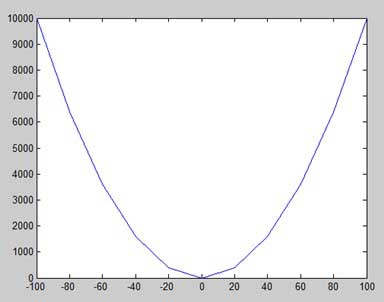
เปลี่ยนไฟล์โค้ดเล็กน้อยลดส่วนเพิ่มเป็น 5 -
x = [-100:5:100];
y = x.^2;
plot(x, y)MATLAB วาดกราฟที่นุ่มนวลขึ้น -
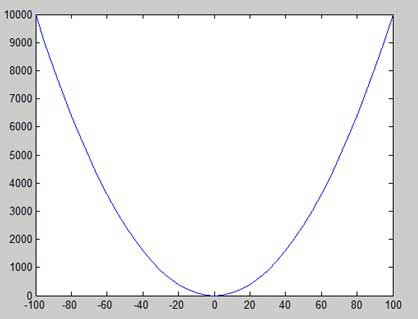
การเพิ่มชื่อเรื่องป้ายกำกับเส้นตารางและมาตราส่วนบนกราฟ
MATLAB ช่วยให้คุณสามารถเพิ่มชื่อเรื่องป้ายกำกับตามแกน x และแกน y เส้นกริดและยังปรับแกนเพื่อให้กราฟขึ้น
xlabel และ ylabel คำสั่งสร้างป้ายกำกับตามแกน x และแกน y
title คำสั่งอนุญาตให้คุณใส่ชื่อเรื่องบนกราฟ
grid on คำสั่งช่วยให้คุณสามารถวางเส้นกริดบนกราฟได้
axis equal คำสั่งอนุญาตให้สร้างพล็อตด้วยสเกลแฟคเตอร์เดียวกันและช่องว่างบนทั้งสองแกน
axis square คำสั่งสร้างพล็อตสี่เหลี่ยม
ตัวอย่าง
สร้างไฟล์สคริปต์และพิมพ์รหัสต่อไปนี้ -
x = [0:0.01:10];
y = sin(x);
plot(x, y), xlabel('x'), ylabel('Sin(x)'), title('Sin(x) Graph'),
grid on, axis equalMATLAB สร้างกราฟต่อไปนี้ -
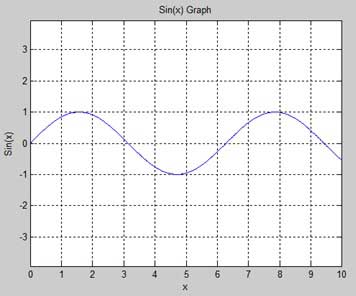
การวาดหลายฟังก์ชั่นบนกราฟเดียวกัน
คุณสามารถวาดกราฟหลาย ๆ กราฟบนพล็อตเดียวกันได้ ตัวอย่างต่อไปนี้แสดงให้เห็นถึงแนวคิด -
ตัวอย่าง
สร้างไฟล์สคริปต์และพิมพ์รหัสต่อไปนี้ -
x = [0 : 0.01: 10];
y = sin(x);
g = cos(x);
plot(x, y, x, g, '.-'), legend('Sin(x)', 'Cos(x)')MATLAB สร้างกราฟต่อไปนี้ -
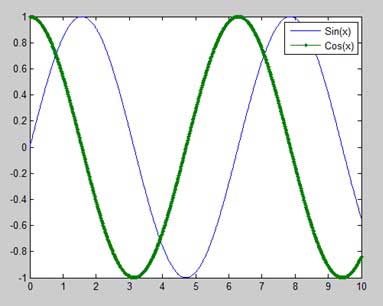
การตั้งค่าสีบนกราฟ
MATLAB มีตัวเลือกสีพื้นฐานแปดสีสำหรับการวาดกราฟ ตารางต่อไปนี้แสดงสีและรหัส -
| รหัส | สี |
|---|---|
| ว | สีขาว |
| k | ดำ |
| ข | สีน้ำเงิน |
| ร | แดง |
| ค | สีฟ้า |
| ก | เขียว |
| ม | ม่วงแดง |
| ย | สีเหลือง |
ตัวอย่าง
ให้เราวาดกราฟของพหุนามสองตัว
f (x) = 3x 4 + 2x 3 + 7x 2 + 2x + 9 และ
ก (x) = 5x 3 + 9x + 2
สร้างไฟล์สคริปต์และพิมพ์รหัสต่อไปนี้ -
x = [-10 : 0.01: 10];
y = 3*x.^4 + 2 * x.^3 + 7 * x.^2 + 2 * x + 9;
g = 5 * x.^3 + 9 * x + 2;
plot(x, y, 'r', x, g, 'g')เมื่อคุณเรียกใช้ไฟล์ MATLAB จะสร้างกราฟต่อไปนี้ -
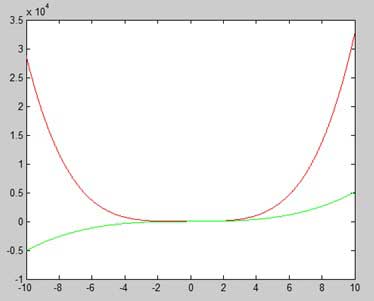
การตั้งค่าเครื่องชั่งแกน
axisคำสั่งอนุญาตให้คุณตั้งค่าสเกลแกน คุณสามารถระบุค่าต่ำสุดและสูงสุดสำหรับแกน x และ y โดยใช้คำสั่งแกนด้วยวิธีต่อไปนี้ -
axis ( [xmin xmax ymin ymax] )ตัวอย่างต่อไปนี้แสดงสิ่งนี้ -
ตัวอย่าง
สร้างไฟล์สคริปต์และพิมพ์รหัสต่อไปนี้ -
x = [0 : 0.01: 10];
y = exp(-x).* sin(2*x + 3);
plot(x, y), axis([0 10 -1 1])เมื่อคุณเรียกใช้ไฟล์ MATLAB จะสร้างกราฟต่อไปนี้ -

การสร้าง Sub-Plots
เมื่อคุณสร้างอาร์เรย์ของพล็อตในรูปเดียวกันแต่ละพล็อตเหล่านี้เรียกว่าพล็อตย่อย subplot คำสั่งใช้สำหรับสร้างพล็อตย่อย
ไวยากรณ์สำหรับคำสั่งคือ -
subplot(m, n, p)โดยที่mและnคือจำนวนแถวและคอลัมน์ของพล็อตอาร์เรย์และpระบุตำแหน่งที่จะวางพล็อตเฉพาะ
แต่ละพล็อตที่สร้างด้วยคำสั่ง subplot สามารถมีลักษณะเฉพาะของตัวเอง ตัวอย่างต่อไปนี้แสดงให้เห็นถึงแนวคิด -
ตัวอย่าง
ให้เราสร้างสองแปลง -
y = e −1.5xบาป (10x)
y = e −2xบาป (10x)
สร้างไฟล์สคริปต์และพิมพ์รหัสต่อไปนี้ -
x = [0:0.01:5];
y = exp(-1.5*x).*sin(10*x);
subplot(1,2,1)
plot(x,y), xlabel('x'),ylabel('exp(–1.5x)*sin(10x)'),axis([0 5 -1 1])
y = exp(-2*x).*sin(10*x);
subplot(1,2,2)
plot(x,y),xlabel('x'),ylabel('exp(–2x)*sin(10x)'),axis([0 5 -1 1])เมื่อคุณเรียกใช้ไฟล์ MATLAB จะสร้างกราฟต่อไปนี้ -
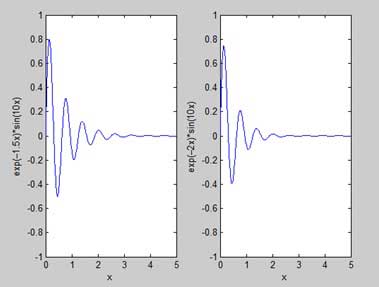
บทนี้จะดำเนินการสำรวจความสามารถในการพล็อตและกราฟิกของ MATLAB เราจะหารือ -
- การวาดแผนภูมิแท่ง
- การวาดรูปทรง
- พล็อตสามมิติ
การวาดแผนภูมิแท่ง
barคำสั่งวาดแผนภูมิแท่งสองมิติ ให้เรายกตัวอย่างเพื่อแสดงความคิด
ตัวอย่าง
ให้เรามีห้องเรียนในจินตนาการที่มีนักเรียน 10 คน เรารู้ว่าเปอร์เซ็นต์ของเครื่องหมายที่นักเรียนเหล่านี้ได้รับคือ 75, 58, 90, 87, 50, 85, 92, 75, 60 และ 95 เราจะวาดแผนภูมิแท่งสำหรับข้อมูลนี้
สร้างไฟล์สคริปต์และพิมพ์รหัสต่อไปนี้ -
x = [1:10];
y = [75, 58, 90, 87, 50, 85, 92, 75, 60, 95];
bar(x,y), xlabel('Student'),ylabel('Score'),
title('First Sem:')
print -deps graph.epsเมื่อคุณเรียกใช้ไฟล์ MATLAB จะแสดงแผนภูมิแท่งต่อไปนี้ -

การวาดรูปทรง
เส้นชั้นความสูงของฟังก์ชันของตัวแปรสองตัวคือเส้นโค้งที่ฟังก์ชันมีค่าคงที่ เส้นชั้นความสูงใช้สำหรับการสร้างแผนที่รูปร่างโดยรวมจุดที่มีความสูงเท่ากันเหนือระดับที่กำหนดเช่นระดับน้ำทะเลปานกลาง
MATLAB ให้ไฟล์ contour ฟังก์ชั่นสำหรับการวาดแผนที่รูปร่าง
ตัวอย่าง
ให้เราสร้างแผนที่รูปร่างที่แสดงเส้นชั้นความสูงสำหรับฟังก์ชันที่กำหนด g = f (x, y) ฟังก์ชันนี้มีสองตัวแปร ดังนั้นเราจะต้องสร้างตัวแปรอิสระสองชุดคือชุดข้อมูล x และ y สองชุด ซึ่งทำได้โดยเรียกไฟล์meshgrid คำสั่ง
meshgrid คำสั่งใช้สำหรับสร้างเมทริกซ์ขององค์ประกอบที่กำหนดช่วงมากกว่า x และ y พร้อมกับข้อกำหนดของการเพิ่มขึ้นในแต่ละกรณี
ให้เราพล็อตฟังก์ชันของเรา g = f (x, y) โดยที่ −5 ≤ x ≤ 5, −3 ≤ y ≤ 3 ให้เราเพิ่ม 0.1 สำหรับทั้งสองค่า ตัวแปรถูกตั้งค่าเป็น -
[x,y] = meshgrid(–5:0.1:5, –3:0.1:3);สุดท้ายเราต้องกำหนดฟังก์ชัน ให้ฟังก์ชันของเราเป็น: x 2 + y 2
สร้างไฟล์สคริปต์และพิมพ์รหัสต่อไปนี้ -
[x,y] = meshgrid(-5:0.1:5,-3:0.1:3); %independent variables
g = x.^2 + y.^2; % our function
contour(x,y,g) % call the contour function
print -deps graph.epsเมื่อคุณเรียกใช้ไฟล์ MATLAB จะแสดงแผนที่รูปร่างต่อไปนี้ -
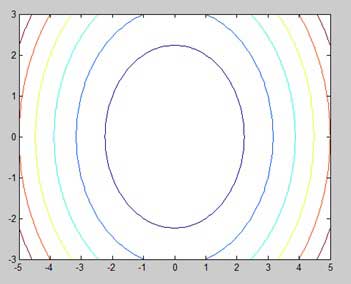
ให้เราแก้ไขโค้ดเล็กน้อยเพื่อให้แผนที่ดูดีขึ้น
[x,y] = meshgrid(-5:0.1:5,-3:0.1:3); %independent variables
g = x.^2 + y.^2; % our function
[C, h] = contour(x,y,g); % call the contour function
set(h,'ShowText','on','TextStep',get(h,'LevelStep')*2)
print -deps graph.epsเมื่อคุณเรียกใช้ไฟล์ MATLAB จะแสดงแผนที่รูปร่างต่อไปนี้ -
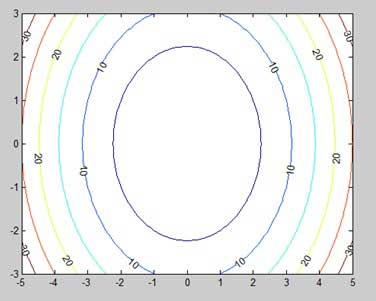
พล็อตสามมิติ
พล็อตสามมิติโดยทั่วไปจะแสดงพื้นผิวที่กำหนดโดยฟังก์ชันในสองตัวแปร g = f (x, y)
ก่อนหน้านี้ในการกำหนด g อันดับแรกเราจะสร้างชุดของจุด (x, y) บนโดเมนของฟังก์ชันโดยใช้ meshgridคำสั่ง ต่อไปเราจะกำหนดฟังก์ชันเอง สุดท้ายเราใช้ไฟล์surf คำสั่งเพื่อสร้างพล็อตพื้นผิว
ตัวอย่างต่อไปนี้แสดงให้เห็นถึงแนวคิด -
ตัวอย่าง
ให้เราสร้างแผนที่พื้นผิว 3 มิติสำหรับฟังก์ชัน g = xe - (x 2 + y 2 )
สร้างไฟล์สคริปต์และพิมพ์รหัสต่อไปนี้ -
[x,y] = meshgrid(-2:.2:2);
g = x .* exp(-x.^2 - y.^2);
surf(x, y, g)
print -deps graph.epsเมื่อคุณเรียกใช้ไฟล์ MATLAB จะแสดงแผนที่ 3 มิติต่อไปนี้ -

คุณยังสามารถใช้ไฟล์ meshคำสั่งเพื่อสร้างพื้นผิวสามมิติ อย่างไรก็ตามsurf คำสั่งแสดงทั้งเส้นเชื่อมต่อและใบหน้าของพื้นผิวเป็นสีในขณะที่ mesh คำสั่งสร้างพื้นผิวโครงร่างที่มีเส้นสีเชื่อมต่อกับจุดที่กำหนด
จนถึงตอนนี้เราได้เห็นแล้วว่าตัวอย่างทั้งหมดทำงานใน MATLAB เช่นเดียวกับ GNU หรือที่เรียกว่า Octave แต่สำหรับการแก้สมการพีชคณิตพื้นฐานทั้ง MATLAB และ Octave มีความแตกต่างกันเล็กน้อยดังนั้นเราจะพยายามครอบคลุม MATLAB และ Octave ในส่วนที่แยกจากกัน
เราจะพูดถึงการแยกตัวประกอบและการทำให้นิพจน์พีชคณิตง่ายขึ้น
การแก้สมการพีชคณิตพื้นฐานใน MATLAB
solveฟังก์ชันใช้สำหรับแก้สมการพีชคณิต ในรูปแบบที่ง่ายที่สุดฟังก์ชันแก้ใช้สมการที่อยู่ในเครื่องหมายคำพูดเป็นอาร์กิวเมนต์
ตัวอย่างเช่นให้เราแก้สำหรับ x ในสมการ x-5 = 0
solve('x-5=0')MATLAB จะดำเนินการตามคำสั่งข้างต้นและส่งกลับผลลัพธ์ต่อไปนี้ -
ans =
5คุณยังสามารถเรียกใช้ฟังก์ชันการแก้ปัญหาว่า -
y = solve('x-5 = 0')MATLAB จะดำเนินการตามคำสั่งข้างต้นและส่งกลับผลลัพธ์ต่อไปนี้ -
y =
5คุณอาจไม่รวมด้านขวามือของสมการ -
solve('x-5')MATLAB จะดำเนินการตามคำสั่งข้างต้นและส่งกลับผลลัพธ์ต่อไปนี้ -
ans =
5หากสมการมีหลายสัญลักษณ์ตามค่าเริ่มต้น MATLAB จะถือว่าคุณกำลังแก้ปัญหาสำหรับ x อย่างไรก็ตามฟังก์ชันการแก้จะมีรูปแบบอื่น -
solve(equation, variable)คุณยังสามารถพูดถึงตัวแปรได้อีกด้วย
ตัวอย่างเช่นให้เราแก้สมการ v - u - 3t 2 = 0 สำหรับ v ในกรณีนี้เราควรเขียน -
solve('v-u-3*t^2=0', 'v')MATLAB จะดำเนินการตามคำสั่งข้างต้นและส่งกลับผลลัพธ์ต่อไปนี้ -
ans =
3*t^2 + uการแก้สมการพีชคณิตพื้นฐานในอ็อกเทฟ
roots ฟังก์ชันใช้สำหรับแก้สมการพีชคณิตในอ็อกเทฟและคุณสามารถเขียนตัวอย่างด้านบนได้ดังนี้ -
ตัวอย่างเช่นให้เราแก้สำหรับ x ในสมการ x-5 = 0
roots([1, -5])Octave จะดำเนินการตามคำสั่งข้างต้นและส่งกลับผลลัพธ์ต่อไปนี้ -
ans = 5คุณยังสามารถเรียกใช้ฟังก์ชันการแก้ปัญหาว่า -
y = roots([1, -5])Octave จะดำเนินการตามคำสั่งข้างต้นและส่งกลับผลลัพธ์ต่อไปนี้ -
y = 5การแก้สมการกำลังสองใน MATLAB
solveฟังก์ชั่นยังสามารถแก้สมการลำดับที่สูงขึ้น มักใช้ในการแก้สมการกำลังสอง ฟังก์ชันจะคืนค่ารากของสมการในอาร์เรย์
ตัวอย่างต่อไปนี้แก้สมการกำลังสอง x 2 -7x +12 = 0 สร้างไฟล์สคริปต์และพิมพ์รหัสต่อไปนี้ -
eq = 'x^2 -7*x + 12 = 0';
s = solve(eq);
disp('The first root is: '), disp(s(1));
disp('The second root is: '), disp(s(2));เมื่อคุณเรียกใช้ไฟล์จะแสดงผลลัพธ์ต่อไปนี้ -
The first root is:
3
The second root is:
4การแก้สมการกำลังสองในอ็อกเทฟ
ตัวอย่างต่อไปนี้แก้สมการกำลังสอง x 2 -7x +12 = 0 ในอ็อกเทฟ สร้างไฟล์สคริปต์และพิมพ์รหัสต่อไปนี้ -
s = roots([1, -7, 12]);
disp('The first root is: '), disp(s(1));
disp('The second root is: '), disp(s(2));เมื่อคุณเรียกใช้ไฟล์จะแสดงผลลัพธ์ต่อไปนี้ -
The first root is:
4
The second root is:
3การแก้สมการลำดับที่สูงขึ้นใน MATLAB
solveฟังก์ชั่นยังสามารถแก้สมการลำดับที่สูงขึ้น ตัวอย่างเช่นให้เราแก้สมการลูกบาศก์เป็น (x-3) 2 (x-7) = 0
solve('(x-3)^2*(x-7)=0')MATLAB จะดำเนินการตามคำสั่งข้างต้นและส่งกลับผลลัพธ์ต่อไปนี้ -
ans =
3
3
7ในกรณีของสมการลำดับที่สูงกว่ารากจะมีหลายคำ คุณสามารถรับค่าตัวเลขของรากดังกล่าวได้โดยการแปลงเป็นสองเท่า ตัวอย่างต่อไปนี้แก้สมการลำดับที่สี่ x 4 - 7x 3 + 3x 2 - 5x + 9 = 0
สร้างไฟล์สคริปต์และพิมพ์รหัสต่อไปนี้ -
eq = 'x^4 - 7*x^3 + 3*x^2 - 5*x + 9 = 0';
s = solve(eq);
disp('The first root is: '), disp(s(1));
disp('The second root is: '), disp(s(2));
disp('The third root is: '), disp(s(3));
disp('The fourth root is: '), disp(s(4));
% converting the roots to double type
disp('Numeric value of first root'), disp(double(s(1)));
disp('Numeric value of second root'), disp(double(s(2)));
disp('Numeric value of third root'), disp(double(s(3)));
disp('Numeric value of fourth root'), disp(double(s(4)));เมื่อคุณเรียกใช้ไฟล์จะส่งคืนผลลัพธ์ต่อไปนี้ -
The first root is:
6.630396332390718431485053218985
The second root is:
1.0597804633025896291682772499885
The third root is:
- 0.34508839784665403032666523448675 - 1.0778362954630176596831109269793*i
The fourth root is:
- 0.34508839784665403032666523448675 + 1.0778362954630176596831109269793*i
Numeric value of first root
6.6304
Numeric value of second root
1.0598
Numeric value of third root
-0.3451 - 1.0778i
Numeric value of fourth root
-0.3451 + 1.0778iโปรดทราบว่าสองรากสุดท้ายเป็นจำนวนเชิงซ้อน
การแก้สมการลำดับที่สูงขึ้นในอ็อกเทฟ
ตัวอย่างต่อไปนี้แก้สมการลำดับที่สี่ x 4 - 7x 3 + 3x 2 - 5x + 9 = 0
สร้างไฟล์สคริปต์และพิมพ์รหัสต่อไปนี้ -
v = [1, -7, 3, -5, 9];
s = roots(v);
% converting the roots to double type
disp('Numeric value of first root'), disp(double(s(1)));
disp('Numeric value of second root'), disp(double(s(2)));
disp('Numeric value of third root'), disp(double(s(3)));
disp('Numeric value of fourth root'), disp(double(s(4)));เมื่อคุณเรียกใช้ไฟล์จะส่งคืนผลลัพธ์ต่อไปนี้ -
Numeric value of first root
6.6304
Numeric value of second root
-0.34509 + 1.07784i
Numeric value of third root
-0.34509 - 1.07784i
Numeric value of fourth root
1.0598การแก้ระบบสมการใน MATLAB
solveนอกจากนี้ยังสามารถใช้ฟังก์ชันเพื่อสร้างคำตอบของระบบสมการที่เกี่ยวข้องกับตัวแปรมากกว่าหนึ่งตัว ให้เรายกตัวอย่างง่ายๆเพื่อสาธิตการใช้งานนี้
ให้เราแก้สมการ -
5x + 9y = 5
3x - 6y = 4
สร้างไฟล์สคริปต์และพิมพ์รหัสต่อไปนี้ -
s = solve('5*x + 9*y = 5','3*x - 6*y = 4');
s.x
s.yเมื่อคุณเรียกใช้ไฟล์จะแสดงผลลัพธ์ต่อไปนี้ -
ans =
22/19
ans =
-5/57ในทำนองเดียวกันคุณสามารถแก้ปัญหาระบบเชิงเส้นขนาดใหญ่ได้ พิจารณาชุดสมการต่อไปนี้ -
x + 3y -2z = 5
3x + 5y + 6z = 7
2x + 4y + 3z = 8
การแก้ระบบสมการในอ็อกเทฟ
เรามีแนวทางที่แตกต่างกันเล็กน้อยในการแก้ระบบสมการเชิงเส้น 'n' ใน 'n' ที่ไม่รู้จัก ให้เรายกตัวอย่างง่ายๆเพื่อสาธิตการใช้งานนี้
ให้เราแก้สมการ -
5x + 9y = 5
3x - 6y = 4
ระบบสมการเชิงเส้นดังกล่าวสามารถเขียนเป็นสมการเมทริกซ์เดี่ยว Ax = b โดยที่ A คือเมทริกซ์สัมประสิทธิ์ b คือเวกเตอร์คอลัมน์ที่มีด้านขวามือของสมการเชิงเส้นและ x คือเวกเตอร์คอลัมน์ที่แสดงถึงการแก้ปัญหาเป็น แสดงในโปรแกรมด้านล่าง -
สร้างไฟล์สคริปต์และพิมพ์รหัสต่อไปนี้ -
A = [5, 9; 3, -6];
b = [5;4];
A \ bเมื่อคุณเรียกใช้ไฟล์จะแสดงผลลัพธ์ต่อไปนี้ -
ans =
1.157895
-0.087719ในทำนองเดียวกันคุณสามารถแก้ปัญหาระบบเชิงเส้นขนาดใหญ่ดังที่ระบุด้านล่าง -
x + 3y -2z = 5
3x + 5y + 6z = 7
2x + 4y + 3z = 8
การขยายและรวบรวมสมการใน MATLAB
expand และ collectฟังก์ชันขยายและรวบรวมสมการตามลำดับ ตัวอย่างต่อไปนี้แสดงให้เห็นถึงแนวคิด -
เมื่อคุณทำงานกับฟังก์ชันสัญลักษณ์จำนวนมากคุณควรประกาศว่าตัวแปรของคุณเป็นสัญลักษณ์
สร้างไฟล์สคริปต์และพิมพ์รหัสต่อไปนี้ -
syms x %symbolic variable x
syms y %symbolic variable x
% expanding equations
expand((x-5)*(x+9))
expand((x+2)*(x-3)*(x-5)*(x+7))
expand(sin(2*x))
expand(cos(x+y))
% collecting equations
collect(x^3 *(x-7))
collect(x^4*(x-3)*(x-5))เมื่อคุณเรียกใช้ไฟล์จะแสดงผลลัพธ์ต่อไปนี้ -
ans =
x^2 + 4*x - 45
ans =
x^4 + x^3 - 43*x^2 + 23*x + 210
ans =
2*cos(x)*sin(x)
ans =
cos(x)*cos(y) - sin(x)*sin(y)
ans =
x^4 - 7*x^3
ans =
x^6 - 8*x^5 + 15*x^4การขยายและรวบรวมสมการในอ็อกเทฟ
คุณจำเป็นต้องมี symbolic แพคเกจซึ่งให้ expand และ collectฟังก์ชันเพื่อขยายและรวบรวมสมการตามลำดับ ตัวอย่างต่อไปนี้แสดงให้เห็นถึงแนวคิด -
เมื่อคุณทำงานกับฟังก์ชันสัญลักษณ์จำนวนมากคุณควรประกาศว่าตัวแปรของคุณเป็นสัญลักษณ์ แต่อ็อกเทฟมีแนวทางที่แตกต่างกันในการกำหนดตัวแปรเชิงสัญลักษณ์ สังเกตการใช้Sin และ Cosซึ่งกำหนดไว้ในแพ็คเกจสัญลักษณ์
สร้างไฟล์สคริปต์และพิมพ์รหัสต่อไปนี้ -
% first of all load the package, make sure its installed.
pkg load symbolic
% make symbols module available
symbols
% define symbolic variables
x = sym ('x');
y = sym ('y');
z = sym ('z');
% expanding equations
expand((x-5)*(x+9))
expand((x+2)*(x-3)*(x-5)*(x+7))
expand(Sin(2*x))
expand(Cos(x+y))
% collecting equations
collect(x^3 *(x-7), z)
collect(x^4*(x-3)*(x-5), z)เมื่อคุณเรียกใช้ไฟล์จะแสดงผลลัพธ์ต่อไปนี้ -
ans =
-45.0+x^2+(4.0)*x
ans =
210.0+x^4-(43.0)*x^2+x^3+(23.0)*x
ans =
sin((2.0)*x)
ans =
cos(y+x)
ans =
x^(3.0)*(-7.0+x)
ans =
(-3.0+x)*x^(4.0)*(-5.0+x)การแยกตัวประกอบและการลดความซับซ้อนของนิพจน์พีชคณิต
factor ฟังก์ชันแยกตัวประกอบนิพจน์และ simplifyฟังก์ชันลดความซับซ้อนของนิพจน์ ตัวอย่างต่อไปนี้แสดงให้เห็นถึงแนวคิด -
ตัวอย่าง
สร้างไฟล์สคริปต์และพิมพ์รหัสต่อไปนี้ -
syms x
syms y
factor(x^3 - y^3)
factor([x^2-y^2,x^3+y^3])
simplify((x^4-16)/(x^2-4))เมื่อคุณเรียกใช้ไฟล์จะแสดงผลลัพธ์ต่อไปนี้ -
ans =
(x - y)*(x^2 + x*y + y^2)
ans =
[ (x - y)*(x + y), (x + y)*(x^2 - x*y + y^2)]
ans =
x^2 + 4MATLAB นำเสนอวิธีต่างๆในการแก้ปัญหาของแคลคูลัสเชิงอนุพันธ์และปริพันธ์การแก้สมการเชิงอนุพันธ์ในระดับใด ๆ และการคำนวณขีด จำกัด เหนือสิ่งอื่นใดคุณสามารถพล็อตกราฟของฟังก์ชันที่ซับซ้อนและตรวจสอบ maxima, minima และจุดสเตชันเนอรีอื่น ๆ บนกราฟได้โดยการแก้ฟังก์ชันดั้งเดิมและอนุพันธ์ของมัน
บทนี้จะจัดการกับปัญหาของแคลคูลัส ในบทนี้จะกล่าวถึงแนวคิดก่อนแคลคูลัสคือการคำนวณขีด จำกัด ของฟังก์ชันและการตรวจสอบคุณสมบัติของลิมิต
ในบทถัดไปDifferentialเราจะคำนวณอนุพันธ์ของนิพจน์และค้นหาค่า maxima และ minima ในพื้นที่บนกราฟ เราจะพูดถึงการแก้สมการเชิงอนุพันธ์
สุดท้ายในการรวมบทที่เราจะหารือแคลคูลัส
การคำนวณขีด จำกัด
MATLAB ให้ไฟล์ limitฟังก์ชันสำหรับคำนวณขีด จำกัด ในรูปแบบพื้นฐานที่สุดไฟล์limit ฟังก์ชันรับนิพจน์เป็นอาร์กิวเมนต์และค้นหาขีด จำกัด ของนิพจน์เมื่อตัวแปรอิสระไปที่ศูนย์
ตัวอย่างเช่นให้เราคำนวณขีด จำกัด ของฟังก์ชัน f (x) = (x 3 + 5) / (x 4 + 7) เนื่องจาก x มีแนวโน้มเป็นศูนย์
syms x
limit((x^3 + 5)/(x^4 + 7))MATLAB จะดำเนินการตามคำสั่งข้างต้นและส่งกลับผลลัพธ์ต่อไปนี้ -
ans =
5/7ฟังก์ชันลิมิตตกอยู่ในขอบเขตของการคำนวณเชิงสัญลักษณ์ คุณต้องใช้ไฟล์symsฟังก์ชันเพื่อบอก MATLAB ว่าคุณใช้ตัวแปรสัญลักษณ์ใด คุณยังสามารถคำนวณขีด จำกัด ของฟังก์ชันได้เนื่องจากตัวแปรมีแนวโน้มที่จะเป็นตัวเลขอื่นที่ไม่ใช่ศูนย์ ในการคำนวณลิมx-> a (f (x)) เราใช้คำสั่ง จำกัด กับอาร์กิวเมนต์ เป็นครั้งแรกการแสดงออกและสองคือจำนวนที่xแนวทางที่นี่มันเป็น
ตัวอย่างเช่นให้เราคำนวณลิมิตของฟังก์ชัน f (x) = (x-3) / (x-1) เนื่องจาก x มีแนวโน้มเป็น 1
limit((x - 3)/(x-1),1)MATLAB จะดำเนินการตามคำสั่งข้างต้นและส่งกลับผลลัพธ์ต่อไปนี้ -
ans =
NaNลองดูอีกตัวอย่าง
limit(x^2 + 5, 3)MATLAB จะดำเนินการตามคำสั่งข้างต้นและส่งกลับผลลัพธ์ต่อไปนี้ -
ans =
14การคำนวณขีด จำกัด โดยใช้ Octave
ต่อไปนี้เป็นรุ่น Octave ของตัวอย่างข้างต้นโดยใช้ symbolic แพ็กเกจลองรันและเปรียบเทียบผลลัพธ์ -
pkg load symbolic
symbols
x = sym("x");
subs((x^3+5)/(x^4+7),x,0)Octave จะดำเนินการตามคำสั่งข้างต้นและส่งกลับผลลัพธ์ต่อไปนี้ -
ans =
0.7142857142857142857การตรวจสอบคุณสมบัติพื้นฐานของขีด จำกัด
Algebraic Limit Theorem ให้คุณสมบัติพื้นฐานบางประการของขีด จำกัด มีดังต่อไปนี้ -

ให้เราพิจารณาสองฟังก์ชั่น -
- f (x) = (3x + 5) / (x - 3)
- g (x) = x 2 + 1
ให้เราคำนวณขีด จำกัด ของฟังก์ชันเมื่อ x มีแนวโน้มที่ 5 ของทั้งสองฟังก์ชันและตรวจสอบคุณสมบัติพื้นฐานของขีด จำกัด โดยใช้ฟังก์ชันทั้งสองนี้และ MATLAB
ตัวอย่าง
สร้างไฟล์สคริปต์และพิมพ์รหัสต่อไปนี้ -
syms x
f = (3*x + 5)/(x-3);
g = x^2 + 1;
l1 = limit(f, 4)
l2 = limit (g, 4)
lAdd = limit(f + g, 4)
lSub = limit(f - g, 4)
lMult = limit(f*g, 4)
lDiv = limit (f/g, 4)เมื่อคุณเรียกใช้ไฟล์จะแสดง -
l1 =
17
l2 =
17
lAdd =
34
lSub =
0
lMult =
289
lDiv =
1การตรวจสอบคุณสมบัติพื้นฐานของขีด จำกัด โดยใช้อ็อกเทฟ
ต่อไปนี้เป็นรุ่น Octave ของตัวอย่างข้างต้นโดยใช้ symbolic แพ็กเกจลองรันและเปรียบเทียบผลลัพธ์ -
pkg load symbolic
symbols
x = sym("x");
f = (3*x + 5)/(x-3);
g = x^2 + 1;
l1 = subs(f, x, 4)
l2 = subs (g, x, 4)
lAdd = subs (f+g, x, 4)
lSub = subs (f-g, x, 4)
lMult = subs (f*g, x, 4)
lDiv = subs (f/g, x, 4)Octave จะดำเนินการตามคำสั่งข้างต้นและส่งกลับผลลัพธ์ต่อไปนี้ -
l1 =
17.0
l2 =
17.0
lAdd =
34.0
lSub =
0.0
lMult =
289.0
lDiv =
1.0ขีด จำกัด ด้านซ้ายและด้านขวา
เมื่อฟังก์ชันมีความไม่ต่อเนื่องสำหรับค่าเฉพาะบางค่าของตัวแปรจะไม่มีขีด จำกัด ที่จุดนั้น กล่าวอีกนัยหนึ่งขีด จำกัด ของฟังก์ชัน f (x) มีความไม่ต่อเนื่องที่ x = a เมื่อค่าของขีด จำกัด เมื่อ x เข้าใกล้ x จากด้านซ้ายจะไม่เท่ากับค่าของขีด จำกัด เมื่อ x เข้าใกล้จากด้านขวา
สิ่งนี้นำไปสู่แนวคิดของการ จำกัด มือซ้ายและมือขวา ขีด จำกัด ของคนถนัดซ้ายถูกกำหนดให้เป็นขีด จำกัด เป็น x -> a จากทางซ้ายกล่าวคือ x เข้าใกล้ a สำหรับค่า x <a ขีด จำกัด ของมือขวากำหนดเป็นขีด จำกัด เป็น x -> a จากทางขวากล่าวคือ x เข้าใกล้ a สำหรับค่า x> a เมื่อขีด จำกัด ของคนถนัดซ้ายและคนถนัดขวาไม่เท่ากันจะไม่มีขีด จำกัด
ให้เราพิจารณาฟังก์ชั่น -
f(x) = (x - 3)/|x - 3|
เราจะแสดงให้เห็นว่า lim x-> 3 f (x) ไม่มีอยู่จริง MATLAB ช่วยให้เราสร้างข้อเท็จจริงนี้ได้สองวิธี -
- โดยการพล็อตกราฟของฟังก์ชันและแสดงความไม่ต่อเนื่อง
- โดยคำนวณขีด จำกัด และแสดงให้เห็นว่าทั้งสองอย่างแตกต่างกัน
ขีด จำกัด ของมือซ้ายและมือขวาคำนวณโดยการส่งสตริงอักขระ 'ซ้าย' และ 'ขวา' ไปยังคำสั่ง จำกัด เป็นอาร์กิวเมนต์สุดท้าย
ตัวอย่าง
สร้างไฟล์สคริปต์และพิมพ์รหัสต่อไปนี้ -
f = (x - 3)/abs(x-3);
ezplot(f,[-1,5])
l = limit(f,x,3,'left')
r = limit(f,x,3,'right')เมื่อคุณเรียกใช้ไฟล์ MATLAB จะวาดพล็อตต่อไปนี้
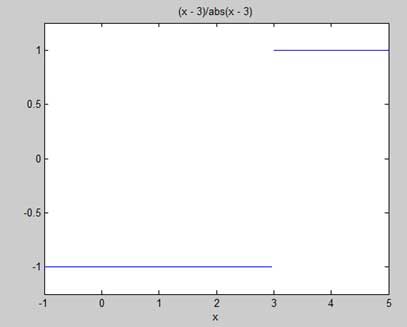
หลังจากแสดงผลลัพธ์ต่อไปนี้ -
l =
-1
r =
1MATLAB ให้ไฟล์ diffคำสั่งสำหรับการคำนวณอนุพันธ์เชิงสัญลักษณ์ ในรูปแบบที่ง่ายที่สุดคุณส่งผ่านฟังก์ชันที่คุณต้องการแยกความแตกต่างให้กับคำสั่ง diff เป็นอาร์กิวเมนต์
ตัวอย่างเช่นให้เราคำนวณอนุพันธ์ของฟังก์ชัน f (t) = 3t 2 + 2t -2
ตัวอย่าง
สร้างไฟล์สคริปต์และพิมพ์รหัสต่อไปนี้ -
syms t
f = 3*t^2 + 2*t^(-2);
diff(f)เมื่อโค้ดด้านบนถูกคอมไพล์และเรียกใช้งานจะให้ผลลัพธ์ดังนี้ -
ans =
6*t - 4/t^3ต่อไปนี้เป็น Octave เทียบเท่ากับการคำนวณข้างต้น -
pkg load symbolic
symbols
t = sym("t");
f = 3*t^2 + 2*t^(-2);
differentiate(f,t)Octave รันโค้ดและส่งกลับผลลัพธ์ต่อไปนี้ -
ans =
-(4.0)*t^(-3.0)+(6.0)*tการตรวจสอบกฎพื้นฐานของความแตกต่าง
ให้เราระบุสมการหรือกฎต่างๆโดยสังเขปสำหรับความแตกต่างของฟังก์ชันและตรวจสอบกฎเหล่านี้ เพื่อจุดประสงค์นี้เราจะเขียน f '(x) สำหรับอนุพันธ์ลำดับที่หนึ่งและ f "(x) สำหรับอนุพันธ์ลำดับที่สอง
ต่อไปนี้เป็นกฎสำหรับความแตกต่าง -
กฎข้อ 1
สำหรับฟังก์ชัน f และ g และจำนวนจริง a และ b เป็นอนุพันธ์ของฟังก์ชัน -
h(x) = af(x) + bg(x) ในส่วนที่เกี่ยวกับ x นั้นกำหนดโดย -
h'(x) = af'(x) + bg'(x)
กฎข้อ 2
sum และ subtraction กฎระบุว่าถ้า f และ g เป็นสองฟังก์ชัน f 'และ g' เป็นอนุพันธ์ตามลำดับจากนั้น
(f + g)' = f' + g'
(f - g)' = f' - g'
กฎข้อ 3
product กฎระบุว่าถ้า f และ g เป็นสองฟังก์ชัน f 'และ g' เป็นอนุพันธ์ตามลำดับดังนั้น
(f.g)' = f'.g + g'.f
กฎข้อ 4
quotient กฎระบุว่าถ้า f และ g เป็นสองฟังก์ชัน f 'และ g' เป็นอนุพันธ์ตามลำดับดังนั้น
(f/g)' = (f'.g - g'.f)/g2
กฎข้อ 5
polynomial หรือกฎอำนาจเบื้องต้นระบุว่าถ้า y = f(x) = xnแล้ว f' = n. x(n-1)
ผลลัพธ์โดยตรงของกฎนี้คืออนุพันธ์ของค่าคงที่ใด ๆ เป็นศูนย์กล่าวคือถ้า y = kค่าคงที่แล้ว
f' = 0
กฎข้อ 6
chain กฎระบุว่าอนุพันธ์ของฟังก์ชันของฟังก์ชัน h(x) = f(g(x)) เกี่ยวกับ x คือ
h'(x)= f'(g(x)).g'(x)
ตัวอย่าง
สร้างไฟล์สคริปต์และพิมพ์รหัสต่อไปนี้ -
syms x
syms t
f = (x + 2)*(x^2 + 3)
der1 = diff(f)
f = (t^2 + 3)*(sqrt(t) + t^3)
der2 = diff(f)
f = (x^2 - 2*x + 1)*(3*x^3 - 5*x^2 + 2)
der3 = diff(f)
f = (2*x^2 + 3*x)/(x^3 + 1)
der4 = diff(f)
f = (x^2 + 1)^17
der5 = diff(f)
f = (t^3 + 3* t^2 + 5*t -9)^(-6)
der6 = diff(f)เมื่อคุณเรียกใช้ไฟล์ MATLAB จะแสดงผลลัพธ์ต่อไปนี้ -
f =
(x^2 + 3)*(x + 2)
der1 =
2*x*(x + 2) + x^2 + 3
f =
(t^(1/2) + t^3)*(t^2 + 3)
der2 =
(t^2 + 3)*(3*t^2 + 1/(2*t^(1/2))) + 2*t*(t^(1/2) + t^3)
f =
(x^2 - 2*x + 1)*(3*x^3 - 5*x^2 + 2)
der3 =
(2*x - 2)*(3*x^3 - 5*x^2 + 2) - (- 9*x^2 + 10*x)*(x^2 - 2*x + 1)
f =
(2*x^2 + 3*x)/(x^3 + 1)
der4 =
(4*x + 3)/(x^3 + 1) - (3*x^2*(2*x^2 + 3*x))/(x^3 + 1)^2
f =
(x^2 + 1)^17
der5 =
34*x*(x^2 + 1)^16
f =
1/(t^3 + 3*t^2 + 5*t - 9)^6
der6 =
-(6*(3*t^2 + 6*t + 5))/(t^3 + 3*t^2 + 5*t - 9)^7ต่อไปนี้เป็น Octave เทียบเท่ากับการคำนวณข้างต้น -
pkg load symbolic
symbols
x = sym("x");
t = sym("t");
f = (x + 2)*(x^2 + 3)
der1 = differentiate(f,x)
f = (t^2 + 3)*(t^(1/2) + t^3)
der2 = differentiate(f,t)
f = (x^2 - 2*x + 1)*(3*x^3 - 5*x^2 + 2)
der3 = differentiate(f,x)
f = (2*x^2 + 3*x)/(x^3 + 1)
der4 = differentiate(f,x)
f = (x^2 + 1)^17
der5 = differentiate(f,x)
f = (t^3 + 3* t^2 + 5*t -9)^(-6)
der6 = differentiate(f,t)Octave รันโค้ดและส่งกลับผลลัพธ์ต่อไปนี้ -
f =
(2.0+x)*(3.0+x^(2.0))
der1 =
3.0+x^(2.0)+(2.0)*(2.0+x)*x
f =
(t^(3.0)+sqrt(t))*(3.0+t^(2.0))
der2 =
(2.0)*(t^(3.0)+sqrt(t))*t+((3.0)*t^(2.0)+(0.5)*t^(-0.5))*(3.0+t^(2.0))
f =
(1.0+x^(2.0)-(2.0)*x)*(2.0-(5.0)*x^(2.0)+(3.0)*x^(3.0))
der3 =
(-2.0+(2.0)*x)*(2.0-(5.0)*x^(2.0)+(3.0)*x^(3.0))+((9.0)*x^(2.0)-(10.0)*x)*(1.0+x^(2.0)-(2.0)*x)
f =
(1.0+x^(3.0))^(-1)*((2.0)*x^(2.0)+(3.0)*x)
der4 =
(1.0+x^(3.0))^(-1)*(3.0+(4.0)*x)-(3.0)*(1.0+x^(3.0))^(-2)*x^(2.0)*((2.0)*x^(2.0)+(3.0)*x)
f =
(1.0+x^(2.0))^(17.0)
der5 =
(34.0)*(1.0+x^(2.0))^(16.0)*x
f =
(-9.0+(3.0)*t^(2.0)+t^(3.0)+(5.0)*t)^(-6.0)
der6 =
-(6.0)*(-9.0+(3.0)*t^(2.0)+t^(3.0)+(5.0)*t)^(-7.0)*(5.0+(3.0)*t^(2.0)+(6.0)*t)อนุพันธ์ของฟังก์ชันเอกซ์โปเนนเชียลลอการิทึมและตรีโกณมิติ
ตารางต่อไปนี้แสดงอนุพันธ์ของฟังก์ชันเอกซ์โพเนนเชียลลอการิทึมและตรีโกณมิติที่ใช้กันทั่วไป -
| ฟังก์ชัน | อนุพันธ์ |
|---|---|
| ca.x | c a.x .ln ca (ln คือลอการิทึมธรรมชาติ) |
| ex | จx |
| ln x | 1 / x |
| lncx | 1 / x.ln ค |
| xx | x x . (1 + ln x) |
| sin(x) | cos (x) |
| cos(x) | - ซิน (x) |
| tan(x) | วินาที2 (x) หรือ 1 / cos 2 (x) หรือ 1 + tan 2 (x) |
| cot(x) | -csc 2 (x) หรือ -1 / sin 2 (x) หรือ - (1 + cot 2 (x)) |
| sec(x) | วินาที (x) .tan (x) |
| csc(x) | -csc (x) .cot (x) |
ตัวอย่าง
สร้างไฟล์สคริปต์และพิมพ์รหัสต่อไปนี้ -
syms x
y = exp(x)
diff(y)
y = x^9
diff(y)
y = sin(x)
diff(y)
y = tan(x)
diff(y)
y = cos(x)
diff(y)
y = log(x)
diff(y)
y = log10(x)
diff(y)
y = sin(x)^2
diff(y)
y = cos(3*x^2 + 2*x + 1)
diff(y)
y = exp(x)/sin(x)
diff(y)เมื่อคุณเรียกใช้ไฟล์ MATLAB จะแสดงผลลัพธ์ต่อไปนี้ -
y =
exp(x)
ans =
exp(x)
y =
x^9
ans =
9*x^8
y =
sin(x)
ans =
cos(x)
y =
tan(x)
ans =
tan(x)^2 + 1
y =
cos(x)
ans =
-sin(x)
y =
log(x)
ans =
1/x
y =
log(x)/log(10)
ans =
1/(x*log(10))
y =
sin(x)^2
ans =
2*cos(x)*sin(x)
y =
cos(3*x^2 + 2*x + 1)
ans =
-sin(3*x^2 + 2*x + 1)*(6*x + 2)
y =
exp(x)/sin(x)
ans =
exp(x)/sin(x) - (exp(x)*cos(x))/sin(x)^2ต่อไปนี้เป็น Octave เทียบเท่ากับการคำนวณข้างต้น -
pkg load symbolic
symbols
x = sym("x");
y = Exp(x)
differentiate(y,x)
y = x^9
differentiate(y,x)
y = Sin(x)
differentiate(y,x)
y = Tan(x)
differentiate(y,x)
y = Cos(x)
differentiate(y,x)
y = Log(x)
differentiate(y,x)
% symbolic packages does not have this support
%y = Log10(x)
%differentiate(y,x)
y = Sin(x)^2
differentiate(y,x)
y = Cos(3*x^2 + 2*x + 1)
differentiate(y,x)
y = Exp(x)/Sin(x)
differentiate(y,x)Octave รันโค้ดและส่งกลับผลลัพธ์ต่อไปนี้ -
y =
exp(x)
ans =
exp(x)
y =
x^(9.0)
ans =
(9.0)*x^(8.0)
y =
sin(x)
ans =
cos(x)
y =
tan(x)
ans =
1+tan(x)^2
y =
cos(x)
ans =
-sin(x)
y =
log(x)
ans =
x^(-1)
y =
sin(x)^(2.0)
ans =
(2.0)*sin(x)*cos(x)
y =
cos(1.0+(2.0)*x+(3.0)*x^(2.0))
ans =
-(2.0+(6.0)*x)*sin(1.0+(2.0)*x+(3.0)*x^(2.0))
y =
sin(x)^(-1)*exp(x)
ans =
sin(x)^(-1)*exp(x)-sin(x)^(-2)*cos(x)*exp(x)การคำนวณอนุพันธ์ลำดับที่สูงขึ้น
ในการคำนวณอนุพันธ์ที่สูงขึ้นของฟังก์ชัน f เราใช้ไวยากรณ์ diff(f,n).
ให้เราคำนวณอนุพันธ์อันดับสองของฟังก์ชัน y = f (x) = x .e -3x
f = x*exp(-3*x);
diff(f, 2)MATLAB รันโค้ดและส่งกลับผลลัพธ์ต่อไปนี้ -
ans =
9*x*exp(-3*x) - 6*exp(-3*x)ต่อไปนี้เป็น Octave เทียบเท่ากับการคำนวณข้างต้น -
pkg load symbolic
symbols
x = sym("x");
f = x*Exp(-3*x);
differentiate(f, x, 2)Octave รันโค้ดและส่งกลับผลลัพธ์ต่อไปนี้ -
ans =
(9.0)*exp(-(3.0)*x)*x-(6.0)*exp(-(3.0)*x)ตัวอย่าง
ในตัวอย่างนี้ให้เราแก้ปัญหา ระบุว่าฟังก์ชันy = f(x) = 3 sin(x) + 7 cos(5x). เราจะต้องค้นหาว่าสมการf" + f = -5cos(2x) ถือเป็นความจริง
สร้างไฟล์สคริปต์และพิมพ์รหัสต่อไปนี้ -
syms x
y = 3*sin(x)+7*cos(5*x); % defining the function
lhs = diff(y,2)+y; %evaluting the lhs of the equation
rhs = -5*cos(2*x); %rhs of the equation
if(isequal(lhs,rhs))
disp('Yes, the equation holds true');
else
disp('No, the equation does not hold true');
end
disp('Value of LHS is: '), disp(lhs);เมื่อคุณเรียกใช้ไฟล์จะแสดงผลลัพธ์ต่อไปนี้ -
No, the equation does not hold true
Value of LHS is:
-168*cos(5*x)ต่อไปนี้เป็น Octave เทียบเท่ากับการคำนวณข้างต้น -
pkg load symbolic
symbols
x = sym("x");
y = 3*Sin(x)+7*Cos(5*x); % defining the function
lhs = differentiate(y, x, 2) + y; %evaluting the lhs of the equation
rhs = -5*Cos(2*x); %rhs of the equation
if(lhs == rhs)
disp('Yes, the equation holds true');
else
disp('No, the equation does not hold true');
end
disp('Value of LHS is: '), disp(lhs);Octave รันโค้ดและส่งกลับผลลัพธ์ต่อไปนี้ -
No, the equation does not hold true
Value of LHS is:
-(168.0)*cos((5.0)*x)การค้นหา Maxima และ Minima ของ Curve
หากเรากำลังค้นหาค่า maxima และ minima ในพื้นที่สำหรับกราฟโดยพื้นฐานแล้วเราจะมองหาจุดสูงสุดหรือต่ำสุดบนกราฟของฟังก์ชันในพื้นที่ใดพื้นที่หนึ่งหรือสำหรับช่วงค่าเฉพาะของตัวแปรสัญลักษณ์
สำหรับฟังก์ชัน y = f (x) จุดบนกราฟที่กราฟมีความชันเป็นศูนย์จะถูกเรียก stationary points. กล่าวอีกนัยหนึ่งจุดหยุดนิ่งคือโดยที่ f '(x) = 0
ในการหาจุดนิ่งของฟังก์ชันที่เราแยกความแตกต่างเราจำเป็นต้องตั้งค่าอนุพันธ์ให้เท่ากับศูนย์และแก้สมการ
ตัวอย่าง
ให้เราหาจุดหยุดนิ่งของฟังก์ชัน f (x) = 2x 3 + 3x 2 - 12x + 17
ทำตามขั้นตอนต่อไปนี้ -
First let us enter the function and plot its graph.
syms x
y = 2*x^3 + 3*x^2 - 12*x + 17; % defining the function
ezplot(y)MATLAB รันโค้ดและส่งคืนพล็อตต่อไปนี้ -
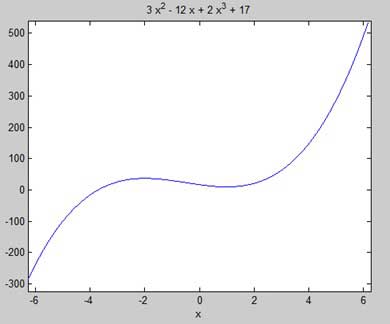
นี่คือรหัสเทียบเท่า Octave สำหรับตัวอย่างข้างต้น -
pkg load symbolic
symbols
x = sym('x');
y = inline("2*x^3 + 3*x^2 - 12*x + 17");
ezplot(y)
print -deps graph.epsOur aim is to find some local maxima and minima on the graph, so let us find the local maxima and minima for the interval [-2, 2] on the graph.
syms x
y = 2*x^3 + 3*x^2 - 12*x + 17; % defining the function
ezplot(y, [-2, 2])MATLAB รันโค้ดและส่งคืนพล็อตต่อไปนี้ -
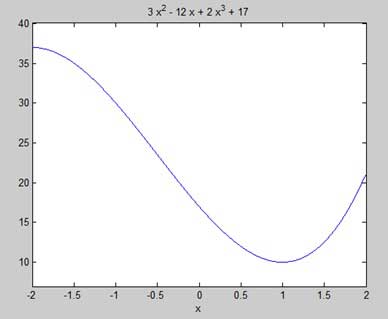
นี่คือรหัสเทียบเท่า Octave สำหรับตัวอย่างข้างต้น -
pkg load symbolic
symbols
x = sym('x');
y = inline("2*x^3 + 3*x^2 - 12*x + 17");
ezplot(y, [-2, 2])
print -deps graph.epsNext, let us compute the derivative.
g = diff(y)MATLAB รันโค้ดและส่งกลับผลลัพธ์ต่อไปนี้ -
g =
6*x^2 + 6*x - 12นี่คือ Octave เทียบเท่ากับการคำนวณข้างต้น -
pkg load symbolic
symbols
x = sym("x");
y = 2*x^3 + 3*x^2 - 12*x + 17;
g = differentiate(y,x)Octave รันโค้ดและส่งกลับผลลัพธ์ต่อไปนี้ -
g =
-12.0+(6.0)*x+(6.0)*x^(2.0)Let us solve the derivative function, g, to get the values where it becomes zero.
s = solve(g)MATLAB รันโค้ดและส่งกลับผลลัพธ์ต่อไปนี้ -
s =
1
-2ต่อไปนี้เป็น Octave เทียบเท่ากับการคำนวณข้างต้น -
pkg load symbolic
symbols
x = sym("x");
y = 2*x^3 + 3*x^2 - 12*x + 17;
g = differentiate(y,x)
roots([6, 6, -12])Octave รันโค้ดและส่งกลับผลลัพธ์ต่อไปนี้ -
g =
-12.0+(6.0)*x^(2.0)+(6.0)*x
ans =
-2
1This agrees with our plot. So let us evaluate the function f at the critical points x = 1, -2. เราสามารถแทนค่าในฟังก์ชันสัญลักษณ์โดยใช้ subs คำสั่ง
subs(y, 1), subs(y, -2)MATLAB รันโค้ดและส่งกลับผลลัพธ์ต่อไปนี้ -
ans =
10
ans =
37ต่อไปนี้เป็น Octave เทียบเท่ากับการคำนวณข้างต้น -
pkg load symbolic
symbols
x = sym("x");
y = 2*x^3 + 3*x^2 - 12*x + 17;
g = differentiate(y,x)
roots([6, 6, -12])
subs(y, x, 1), subs(y, x, -2)ans =
10.0
ans =
37.0-4.6734207789940138748E-18*Iดังนั้นค่าต่ำสุดและสูงสุดในฟังก์ชัน f (x) = 2x 3 + 3x 2 - 12x + 17 ในช่วงเวลา [-2,2] คือ 10 และ 37
การแก้สมการเชิงอนุพันธ์
MATLAB ให้ไฟล์ dsolve คำสั่งสำหรับการแก้สมการเชิงอนุพันธ์ในเชิงสัญลักษณ์
รูปแบบพื้นฐานที่สุดของไฟล์ dsolve คำสั่งสำหรับการหาคำตอบของสมการเดียวคือ
dsolve('eqn')โดยที่eqnเป็นสตริงข้อความที่ใช้ในการป้อนสมการ
ส่งคืนโซลูชันเชิงสัญลักษณ์พร้อมชุดค่าคงที่กำหนดเองที่ MATLAB เลเบล C1, C2 และอื่น ๆ
คุณยังสามารถระบุเงื่อนไขเริ่มต้นและขอบเขตของปัญหาได้โดยเป็นรายการที่คั่นด้วยจุลภาคตามสมการดังนี้ -
dsolve('eqn','cond1', 'cond2',…)สำหรับวัตถุประสงค์ในการใช้คำสั่ง dsolve derivatives are indicated with a D. ตัวอย่างเช่นสมการเช่น f '(t) = -2 * f + cost (t) จะถูกป้อนเป็น -
'Df = -2*f + cos(t)'
อนุพันธ์ที่สูงกว่าจะแสดงโดยทำตาม D ตามลำดับของอนุพันธ์
ตัวอย่างเช่นสมการ f "(x) + 2f '(x) = 5sin3x ควรป้อนเป็น -
'D2y + 2Dy = 5*sin(3*x)'
ให้เรายกตัวอย่างง่ายๆของสมการเชิงอนุพันธ์ลำดับที่หนึ่ง: y '= 5y
s = dsolve('Dy = 5*y')MATLAB รันโค้ดและส่งกลับผลลัพธ์ต่อไปนี้ -
s =
C2*exp(5*t)ให้เรายกตัวอย่างสมการเชิงอนุพันธ์ลำดับที่สองเป็น: y "- y = 0, y (0) = -1, y '(0) = 2
dsolve('D2y - y = 0','y(0) = -1','Dy(0) = 2')MATLAB รันโค้ดและส่งกลับผลลัพธ์ต่อไปนี้ -
ans =
exp(t)/2 - (3*exp(-t))/2การบูรณาการเกี่ยวข้องกับปัญหาสองประเภทที่แตกต่างกัน
ในประเภทแรกจะมีการกำหนดอนุพันธ์ของฟังก์ชันและเราต้องการค้นหาฟังก์ชัน ดังนั้นเราจึงย้อนกลับกระบวนการสร้างความแตกต่าง กระบวนการย้อนกลับนี้เรียกว่าการต่อต้านความแตกต่างหรือการค้นหาฟังก์ชันดั้งเดิมหรือการค้นหาindefinite integral.
ปัญหาประเภทที่สองเกี่ยวข้องกับการเพิ่มปริมาณที่น้อยมากเป็นจำนวนมากจากนั้นจึง จำกัด เมื่อขนาดของปริมาณเข้าใกล้ศูนย์ในขณะที่จำนวนคำมีแนวโน้มที่จะไม่มีที่สิ้นสุด กระบวนการนี้นำไปสู่คำจำกัดความของไฟล์definite integral.
อินทิกรัลที่แน่นอนใช้สำหรับการหาพื้นที่ปริมาตรจุดศูนย์ถ่วงโมเมนต์ความเฉื่อยงานที่ทำด้วยแรงและในการใช้งานอื่น ๆ อีกมากมาย
การค้นหาอินทิกรัลที่ไม่มีกำหนดโดยใช้ MATLAB
ตามนิยามถ้าอนุพันธ์ของฟังก์ชัน f (x) คือ f '(x) เราจะบอกว่าอินทิกรัลไม่ จำกัด ของ f' (x) เทียบกับ x คือ f (x) ยกตัวอย่างเช่นตั้งแต่อนุพันธ์ (ด้วยความเคารพ x) ของ x 2คือ 2x เราสามารถพูดได้ว่าหนึ่งไม่แน่นอนของ 2x คือ x 2
ในสัญลักษณ์ -
f'(x2) = 2xดังนั้น
∫ 2xdx = x2.
อินทิกรัลไม่แน่นอนไม่ซ้ำกันเนื่องจากอนุพันธ์ของ x 2 + c สำหรับค่าใด ๆ ของ c คงที่จะเป็น 2x ด้วย
สิ่งนี้แสดงในสัญลักษณ์เป็น -
∫ 2xdx = x2 + c.
โดยที่ c เรียกว่า 'ค่าคงที่โดยพลการ'
MATLAB ให้ไฟล์ intคำสั่งสำหรับคำนวณอินทิกรัลของนิพจน์ เพื่อให้ได้นิพจน์สำหรับอินทิกรัลไม่ จำกัด ของฟังก์ชันเราเขียน -
int(f);ตัวอย่างเช่นจากตัวอย่างก่อนหน้าของเรา -
syms x
int(2*x)MATLAB ดำเนินการคำสั่งข้างต้นและส่งกลับผลลัพธ์ต่อไปนี้ -
ans =
x^2ตัวอย่าง 1
ในตัวอย่างนี้ให้เราหาอินทิกรัลของนิพจน์ที่ใช้กันทั่วไป สร้างไฟล์สคริปต์และพิมพ์รหัสต่อไปนี้ -
syms x n
int(sym(x^n))
f = 'sin(n*t)'
int(sym(f))
syms a t
int(a*cos(pi*t))
int(a^x)เมื่อคุณเรียกใช้ไฟล์จะแสดงผลลัพธ์ต่อไปนี้ -
ans =
piecewise([n == -1, log(x)], [n ~= -1, x^(n + 1)/(n + 1)])
f =
sin(n*t)
ans =
-cos(n*t)/n
ans =
(a*sin(pi*t))/pi
ans =
a^x/log(a)ตัวอย่าง 2
สร้างไฟล์สคริปต์และพิมพ์รหัสต่อไปนี้ -
syms x n
int(cos(x))
int(exp(x))
int(log(x))
int(x^-1)
int(x^5*cos(5*x))
pretty(int(x^5*cos(5*x)))
int(x^-5)
int(sec(x)^2)
pretty(int(1 - 10*x + 9 * x^2))
int((3 + 5*x -6*x^2 - 7*x^3)/2*x^2)
pretty(int((3 + 5*x -6*x^2 - 7*x^3)/2*x^2))โปรดทราบว่าไฟล์ pretty ฟังก์ชันส่งคืนนิพจน์ในรูปแบบที่อ่านได้มากขึ้น
เมื่อคุณเรียกใช้ไฟล์จะแสดงผลลัพธ์ต่อไปนี้ -
ans =
sin(x)
ans =
exp(x)
ans =
x*(log(x) - 1)
ans =
log(x)
ans =
(24*cos(5*x))/3125 + (24*x*sin(5*x))/625 - (12*x^2*cos(5*x))/125 + (x^4*cos(5*x))/5 - (4*x^3*sin(5*x))/25 + (x^5*sin(5*x))/5
2 4
24 cos(5 x) 24 x sin(5 x) 12 x cos(5 x) x cos(5 x)
----------- + ------------- - -------------- + ------------
3125 625 125 5
3 5
4 x sin(5 x) x sin(5 x)
------------- + -----------
25 5
ans =
-1/(4*x^4)
ans =
tan(x)
2
x (3 x - 5 x + 1)
ans =
- (7*x^6)/12 - (3*x^5)/5 + (5*x^4)/8 + x^3/2
6 5 4 3
7 x 3 x 5 x x
- ---- - ---- + ---- + --
12 5 8 2การค้นหาอินทิกรัลที่แน่นอนโดยใช้ MATLAB
ตามความหมายแล้วอินทิกรัลที่แน่นอนคือขีด จำกัด ของผลรวม เราใช้ปริพันธ์ที่แน่นอนเพื่อหาพื้นที่เช่นพื้นที่ระหว่างเส้นโค้งกับแกน x และพื้นที่ระหว่างเส้นโค้งสองเส้น อินทิกรัลที่แน่นอนยังสามารถใช้ในสถานการณ์อื่น ๆ ซึ่งปริมาณที่ต้องการสามารถแสดงเป็นขีด จำกัด ของผลรวม
int ฟังก์ชันสามารถใช้สำหรับการรวมที่แน่นอนโดยส่งผ่านขีด จำกัด ที่คุณต้องการคำนวณอินทิกรัล
คำนวน

พวกเราเขียน,
int(x, a, b)ตัวอย่างเช่นในการคำนวณค่าที่

int(x, 4, 9)MATLAB ดำเนินการคำสั่งข้างต้นและส่งกลับผลลัพธ์ต่อไปนี้ -
ans =
65/2ต่อไปนี้เป็น Octave เทียบเท่ากับการคำนวณข้างต้น -
pkg load symbolic
symbols
x = sym("x");
f = x;
c = [1, 0];
integral = polyint(c);
a = polyval(integral, 9) - polyval(integral, 4);
display('Area: '), disp(double(a));Octave รันโค้ดและส่งกลับผลลัพธ์ต่อไปนี้ -
Area:
32.500โซลูชันทางเลือกสามารถกำหนดได้โดยใช้ฟังก์ชัน quad () ที่จัดทำโดย Octave ดังต่อไปนี้ -
pkg load symbolic
symbols
f = inline("x");
[a, ierror, nfneval] = quad(f, 4, 9);
display('Area: '), disp(double(a));Octave รันโค้ดและส่งกลับผลลัพธ์ต่อไปนี้ -
Area:
32.500ตัวอย่าง 1
ให้เราคำนวณพื้นที่ที่ล้อมรอบระหว่างแกน x และเส้นโค้ง y = x 3 −2x + 5 และพิกัด x = 1 และ x = 2
พื้นที่ที่ต้องการกำหนดโดย -

สร้างไฟล์สคริปต์และพิมพ์รหัสต่อไปนี้ -
f = x^3 - 2*x +5;
a = int(f, 1, 2)
display('Area: '), disp(double(a));เมื่อคุณเรียกใช้ไฟล์จะแสดงผลลัพธ์ต่อไปนี้ -
a =
23/4
Area:
5.7500ต่อไปนี้เป็น Octave เทียบเท่ากับการคำนวณข้างต้น -
pkg load symbolic
symbols
x = sym("x");
f = x^3 - 2*x +5;
c = [1, 0, -2, 5];
integral = polyint(c);
a = polyval(integral, 2) - polyval(integral, 1);
display('Area: '), disp(double(a));Octave รันโค้ดและส่งกลับผลลัพธ์ต่อไปนี้ -
Area:
5.7500โซลูชันทางเลือกสามารถกำหนดได้โดยใช้ฟังก์ชัน quad () ที่จัดทำโดย Octave ดังต่อไปนี้ -
pkg load symbolic
symbols
x = sym("x");
f = inline("x^3 - 2*x +5");
[a, ierror, nfneval] = quad(f, 1, 2);
display('Area: '), disp(double(a));Octave รันโค้ดและส่งกลับผลลัพธ์ต่อไปนี้ -
Area:
5.7500ตัวอย่าง 2
หาพื้นที่ใต้เส้นโค้ง: f (x) = x 2 cos (x) สำหรับ −4 ≤ x ≤ 9
สร้างไฟล์สคริปต์และเขียนโค้ดต่อไปนี้ -
f = x^2*cos(x);
ezplot(f, [-4,9])
a = int(f, -4, 9)
disp('Area: '), disp(double(a));เมื่อคุณเรียกใช้ไฟล์ MATLAB จะลงจุดกราฟ -
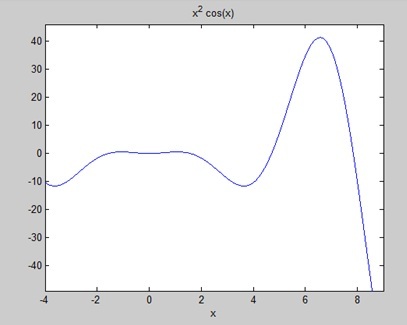
ผลลัพธ์จะได้รับด้านล่าง -
a =
8*cos(4) + 18*cos(9) + 14*sin(4) + 79*sin(9)
Area:
0.3326ต่อไปนี้เป็น Octave เทียบเท่ากับการคำนวณข้างต้น -
pkg load symbolic
symbols
x = sym("x");
f = inline("x^2*cos(x)");
ezplot(f, [-4,9])
print -deps graph.eps
[a, ierror, nfneval] = quad(f, -4, 9);
display('Area: '), disp(double(a));MATLAB แทนพหุนามเป็นเวกเตอร์แถวที่มีค่าสัมประสิทธิ์เรียงลำดับตามกำลังจากมากไปหาน้อย ตัวอย่างเช่นสมการ P (x) = x 4 + 7x 3 - 5x + 9 สามารถแสดงเป็น -
p = [1 7 0 -5 9];
การประเมินพหุนาม
polyvalฟังก์ชันใช้สำหรับการประเมินพหุนามตามค่าที่ระบุ ตัวอย่างเช่นเพื่อประเมินพหุนามก่อนหน้าของเราp, ที่ x = 4, พิมพ์ -
p = [1 7 0 -5 9];
polyval(p,4)MATLAB รันข้อความข้างต้นและส่งกลับผลลัพธ์ต่อไปนี้ -
ans = 693MATLAB ยังมีไฟล์ polyvalmฟังก์ชันสำหรับการประเมินพหุนามเมทริกซ์ พหุนามเมทริกซ์คือpolynomial โดยมีเมทริกซ์เป็นตัวแปร
ตัวอย่างเช่นให้เราสร้างเมทริกซ์สี่เหลี่ยม X และประเมินพหุนาม p ที่ X -
p = [1 7 0 -5 9];
X = [1 2 -3 4; 2 -5 6 3; 3 1 0 2; 5 -7 3 8];
polyvalm(p, X)MATLAB รันข้อความข้างต้นและส่งกลับผลลัพธ์ต่อไปนี้ -
ans =
2307 -1769 -939 4499
2314 -2376 -249 4695
2256 -1892 -549 4310
4570 -4532 -1062 9269การหารากของพหุนาม
rootsฟังก์ชันคำนวณรากของพหุนาม ตัวอย่างเช่นในการคำนวณรากของพหุนาม p ของเราให้พิมพ์ -
p = [1 7 0 -5 9];
r = roots(p)MATLAB รันข้อความข้างต้นและส่งกลับผลลัพธ์ต่อไปนี้ -
r =
-6.8661 + 0.0000i
-1.4247 + 0.0000i
0.6454 + 0.7095i
0.6454 - 0.7095iฟังก์ชั่น polyเป็นค่าผกผันของฟังก์ชันรากและกลับไปที่สัมประสิทธิ์พหุนาม ตัวอย่างเช่น -
p2 = poly(r)MATLAB รันข้อความข้างต้นและส่งกลับผลลัพธ์ต่อไปนี้ -
p2 =
Columns 1 through 3:
1.00000 + 0.00000i 7.00000 + 0.00000i 0.00000 + 0.00000i
Columns 4 and 5:
-5.00000 - 0.00000i 9.00000 + 0.00000iการติดตั้งเส้นโค้งพหุนาม
polyfitฟังก์ชันค้นหาค่าสัมประสิทธิ์ของพหุนามที่เหมาะกับชุดข้อมูลในความหมายกำลังสองน้อยที่สุด ถ้า x และ y เป็นเวกเตอร์สองตัวที่มีข้อมูล x และ y ที่จะพอดีกับพหุนามระดับ n เราจะได้พหุนามที่เหมาะสมกับข้อมูลโดยการเขียน -
p = polyfit(x,y,n)ตัวอย่าง
สร้างไฟล์สคริปต์และพิมพ์รหัสต่อไปนี้ -
x = [1 2 3 4 5 6]; y = [5.5 43.1 128 290.7 498.4 978.67]; %data
p = polyfit(x,y,4) %get the polynomial
% Compute the values of the polyfit estimate over a finer range,
% and plot the estimate over the real data values for comparison:
x2 = 1:.1:6;
y2 = polyval(p,x2);
plot(x,y,'o',x2,y2)
grid onเมื่อคุณเรียกใช้ไฟล์ MATLAB จะแสดงผลลัพธ์ต่อไปนี้ -
p =
4.1056 -47.9607 222.2598 -362.7453 191.1250และแปลงกราฟต่อไปนี้ -

MATLAB มีคำสั่งสำหรับการทำงานกับการแปลงเช่นการแปลงลาปลาซและฟูริเยร์ การแปลงใช้ในวิทยาศาสตร์และวิศวกรรมเป็นเครื่องมือสำหรับการวิเคราะห์ที่ง่ายขึ้นและมองข้อมูลจากอีกมุมหนึ่ง
ตัวอย่างเช่นการแปลงฟูริเยร์ช่วยให้เราสามารถแปลงสัญญาณที่แสดงเป็นฟังก์ชันของเวลาเป็นฟังก์ชันของความถี่ การแปลงลาปลาซช่วยให้เราสามารถแปลงสมการเชิงอนุพันธ์เป็นสมการพีชคณิต
MATLAB ให้ไฟล์ laplace, fourier และ fft คำสั่งเพื่อทำงานกับการแปลง Laplace, Fourier และ Fast Fourier
การแปลง Laplace
การแปลงลาปลาซของฟังก์ชันของเวลา f (t) ถูกกำหนดโดยอินทิกรัลต่อไปนี้ -

การแปลง Laplace ยังแสดงว่าเป็นการแปลงจาก f (t) เป็น F (s) คุณสามารถเห็นกระบวนการแปลงหรือการรวมนี้แปลง f (t) ซึ่งเป็นฟังก์ชันของตัวแปรสัญลักษณ์ t เป็นฟังก์ชันอื่น F พร้อมกับตัวแปรอื่น s
Laplace transform เปลี่ยนสมการเชิงอนุพันธ์เป็นพีชคณิต ในการคำนวณการแปลงลาปลาซของฟังก์ชัน f (t) ให้เขียน -
laplace(f(t))ตัวอย่าง
ในตัวอย่างนี้เราจะคำนวณการแปลง Laplace ของฟังก์ชันที่ใช้กันทั่วไป
สร้างไฟล์สคริปต์และพิมพ์รหัสต่อไปนี้ -
syms s t a b w
laplace(a)
laplace(t^2)
laplace(t^9)
laplace(exp(-b*t))
laplace(sin(w*t))
laplace(cos(w*t))เมื่อคุณเรียกใช้ไฟล์จะแสดงผลลัพธ์ต่อไปนี้ -
ans =
1/s^2
ans =
2/s^3
ans =
362880/s^10
ans =
1/(b + s)
ans =
w/(s^2 + w^2)
ans =
s/(s^2 + w^2)การแปลง Laplace ผกผัน
MATLAB ช่วยให้เราสามารถคำนวณการแปลงลาปลาซผกผันโดยใช้คำสั่ง ilaplace.
ตัวอย่างเช่น,
ilaplace(1/s^3)MATLAB จะดำเนินการตามคำสั่งข้างต้นและแสดงผลลัพธ์ -
ans =
t^2/2ตัวอย่าง
สร้างไฟล์สคริปต์และพิมพ์รหัสต่อไปนี้ -
syms s t a b w
ilaplace(1/s^7)
ilaplace(2/(w+s))
ilaplace(s/(s^2+4))
ilaplace(exp(-b*t))
ilaplace(w/(s^2 + w^2))
ilaplace(s/(s^2 + w^2))เมื่อคุณเรียกใช้ไฟล์จะแสดงผลลัพธ์ต่อไปนี้ -
ans =
t^6/720
ans =
2*exp(-t*w)
ans =
cos(2*t)
ans =
ilaplace(exp(-b*t), t, x)
ans =
sin(t*w)
ans =
cos(t*w)การแปลงฟูเรียร์
การแปลงฟูเรียร์โดยทั่วไปจะแปลงฟังก์ชันทางคณิตศาสตร์ของเวลา f (t) เป็นฟังก์ชันใหม่บางครั้งแสดงโดยหรือ F ซึ่งอาร์กิวเมนต์คือความถี่โดยมีหน่วยของรอบ / วินาที (เฮิรตซ์) หรือเรเดียนต่อวินาที ฟังก์ชันใหม่นี้เรียกว่าการแปลงฟูริเยร์และ / หรือสเปกตรัมความถี่ของฟังก์ชัน f
ตัวอย่าง
สร้างไฟล์สคริปต์และพิมพ์รหัสต่อไปนี้ -
syms x
f = exp(-2*x^2); %our function
ezplot(f,[-2,2]) % plot of our function
FT = fourier(f) % Fourier transformเมื่อคุณเรียกใช้ไฟล์ MATLAB จะแปลงกราฟต่อไปนี้ -
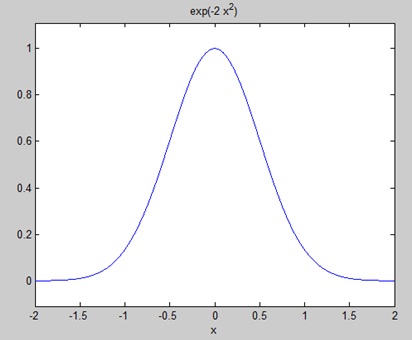
ผลลัพธ์ต่อไปนี้จะปรากฏขึ้น -
FT =
(2^(1/2)*pi^(1/2)*exp(-w^2/8))/2การพล็อตการแปลงฟูเรียร์เป็น -
ezplot(FT)ให้กราฟต่อไปนี้ -

การแปลงฟูเรียร์ผกผัน
MATLAB ให้ไฟล์ ifourierคำสั่งสำหรับการคำนวณการแปลงฟูเรียร์ผกผันของฟังก์ชัน ตัวอย่างเช่น,
f = ifourier(-2*exp(-abs(w)))MATLAB จะดำเนินการตามคำสั่งข้างต้นและแสดงผลลัพธ์ -
f =
-2/(pi*(x^2 + 1))GNU Octave เป็นภาษาโปรแกรมระดับสูงเช่น MATLAB และส่วนใหญ่เข้ากันได้กับ MATLAB นอกจากนี้ยังใช้สำหรับการคำนวณเชิงตัวเลข
Octave มีคุณสมบัติทั่วไปดังต่อไปนี้กับ MATLAB -
- เมทริกซ์เป็นประเภทข้อมูลพื้นฐาน
- มีการรองรับจำนวนเชิงซ้อนในตัว
- มีฟังก์ชันคณิตศาสตร์และไลบรารีในตัว
- รองรับฟังก์ชันที่ผู้ใช้กำหนดเอง
GNU Octave ยังเป็นซอฟต์แวร์ที่แจกจ่ายต่อได้อย่างอิสระ คุณสามารถแจกจ่ายซ้ำและ / หรือแก้ไขได้ภายใต้เงื่อนไขของ GNU General Public License (GPL) ตามที่เผยแพร่โดย Free Software Foundation
MATLAB เทียบกับ Octave
โปรแกรม MATLAB ส่วนใหญ่ทำงานใน Octave แต่โปรแกรม Octave บางโปรแกรมอาจไม่ทำงานใน MATLAB เนื่องจาก Octave อนุญาตให้ใช้ไวยากรณ์บางอย่างที่ MATLAB ไม่มี
ตัวอย่างเช่น MATLAB รองรับอัญประกาศเดี่ยวเท่านั้น แต่ Octave รองรับทั้งอัญประกาศเดี่ยวและคู่สำหรับการกำหนดสตริง หากคุณกำลังมองหาบทช่วยสอนเกี่ยวกับ Octave โปรดอ่านบทช่วยสอนนี้ตั้งแต่เริ่มต้นซึ่งครอบคลุมทั้ง MATLAB และ Octave
ตัวอย่างที่เข้ากันได้
ตัวอย่างเกือบทั้งหมดที่กล่าวถึงในบทช่วยสอนนี้เข้ากันได้กับ MATLAB และ Octave ลองทำตามตัวอย่างใน MATLAB และ Octave ซึ่งให้ผลลัพธ์เดียวกันโดยไม่มีการเปลี่ยนแปลงทางไวยากรณ์ -
ตัวอย่างนี้จะสร้างแผนที่พื้นผิว 3 มิติสำหรับฟังก์ชัน g = XE - (x 2 + y ที่2 ) สร้างไฟล์สคริปต์และพิมพ์รหัสต่อไปนี้ -
[x,y] = meshgrid(-2:.2:2);
g = x .* exp(-x.^2 - y.^2);
surf(x, y, g)
print -deps graph.epsเมื่อคุณเรียกใช้ไฟล์ MATLAB จะแสดงแผนที่ 3 มิติต่อไปนี้ -

ตัวอย่างที่เข้ากันไม่ได้
แม้ว่าฟังก์ชันหลักทั้งหมดของ MATLAB จะมีอยู่ใน Octave แต่ก็มีฟังก์ชันบางอย่างเช่น Differential & Integration Calculus ซึ่งไม่ตรงกันในทั้งสองภาษา บทช่วยสอนนี้ได้พยายามให้ตัวอย่างทั้งสองประเภทซึ่งแตกต่างกันในไวยากรณ์ของตน
พิจารณาตัวอย่างต่อไปนี้ที่ MATLAB และ Octave ใช้ประโยชน์จากฟังก์ชันต่าง ๆ เพื่อให้ได้พื้นที่ของเส้นโค้ง: f (x) = x 2 cos (x) สำหรับ −4 ≤ x ≤ 9 ต่อไปนี้เป็นเวอร์ชัน MATLAB ของโค้ด -
f = x^2*cos(x);
ezplot(f, [-4,9])
a = int(f, -4, 9)
disp('Area: '), disp(double(a));เมื่อคุณเรียกใช้ไฟล์ MATLAB จะลงจุดกราฟ -

ผลลัพธ์ต่อไปนี้จะปรากฏขึ้น
a =
8*cos(4) + 18*cos(9) + 14*sin(4) + 79*sin(9)
Area:
0.3326แต่เพื่อให้ได้พื้นที่ของเส้นโค้งเดียวกันใน Octave คุณจะต้องใช้ประโยชน์จาก symbolic แพคเกจดังนี้ -
pkg load symbolic
symbols
x = sym("x");
f = inline("x^2*cos(x)");
ezplot(f, [-4,9])
print -deps graph.eps
[a, ierror, nfneval] = quad(f, -4, 9);
display('Area: '), disp(double(a));Simulink เป็นสภาพแวดล้อมการออกแบบจำลองและตามโมเดลสำหรับระบบไดนามิกและระบบฝังตัวที่รวมเข้ากับ MATLAB Simulink ซึ่งพัฒนาโดย MathWorks เป็นเครื่องมือภาษาการเขียนโปรแกรมกราฟิกโฟลว์ข้อมูลสำหรับการสร้างแบบจำลองจำลองและวิเคราะห์ระบบไดนามิกแบบหลายโดเมน โดยพื้นฐานแล้วเป็นเครื่องมือสร้างไดอะแกรมบล็อกกราฟิกพร้อมชุดบล็อกไลบรารีที่ปรับแต่งได้
ช่วยให้คุณสามารถรวมอัลกอริทึม MATLAB ลงในแบบจำลองและส่งออกผลการจำลองไปยัง MATLAB เพื่อการวิเคราะห์เพิ่มเติม
Simulink รองรับ -
- การออกแบบระดับระบบ
- simulation
- การสร้างรหัสอัตโนมัติ
- การทดสอบและการตรวจสอบระบบฝังตัว
มีผลิตภัณฑ์เสริมอื่น ๆ อีกมากมายที่จัดทำโดย MathWorks และผลิตภัณฑ์ฮาร์ดแวร์และซอฟต์แวร์ของ บริษัท อื่นที่พร้อมใช้งานกับ Simulink
รายการต่อไปนี้ให้คำอธิบายสั้น ๆ เกี่ยวกับบางส่วน -
Stateflow อนุญาตให้พัฒนาเครื่องจักรของรัฐและผังงาน
Simulink Coder อนุญาตให้สร้างซอร์สโค้ด C สำหรับการใช้งานระบบแบบเรียลไทม์โดยอัตโนมัติ
xPC Target ร่วมกับ x86-based real-time systems จัดเตรียมสภาพแวดล้อมในการจำลองและทดสอบโมเดล Simulink และ Stateflow แบบเรียลไทม์บนระบบจริง
Embedded Coder รองรับเป้าหมายที่ฝังเฉพาะ
HDL Coder อนุญาตให้สร้าง VHDL และ Verilog ที่สังเคราะห์ได้โดยอัตโนมัติ
SimEvents จัดเตรียมไลบรารีของหน่วยการสร้างแบบกราฟิกสำหรับการสร้างแบบจำลองระบบคิว
Simulink สามารถตรวจสอบและตรวจสอบโมเดลได้อย่างเป็นระบบผ่านการตรวจสอบรูปแบบการสร้างแบบจำลองการตรวจสอบย้อนกลับข้อกำหนดและการวิเคราะห์ความครอบคลุมของโมเดล
Simulink Design Verifier ช่วยให้คุณระบุข้อผิดพลาดในการออกแบบและสร้างสถานการณ์กรณีทดสอบสำหรับการตรวจสอบโมเดล
ใช้ Simulink
หากต้องการเปิด Simulink ให้พิมพ์ MATLAB work space -
simulinkSimulink เปิดขึ้นพร้อมกับไฟล์ Library Browser. Library Browser ใช้สำหรับการสร้างโมเดลจำลอง

ในบานหน้าต่างด้านซ้ายคุณจะพบไลบรารีหลายแห่งที่แบ่งตามระบบต่างๆเมื่อคลิกที่แต่ละอันจะแสดงบล็อกการออกแบบที่บานหน้าต่างด้านขวา
แบบจำลองอาคาร
หากต้องการสร้างโมเดลใหม่ให้คลิก Newบนแถบเครื่องมือ Library Browser ซึ่งจะเปิดหน้าต่างรุ่นใหม่ที่ไม่มีชื่อ
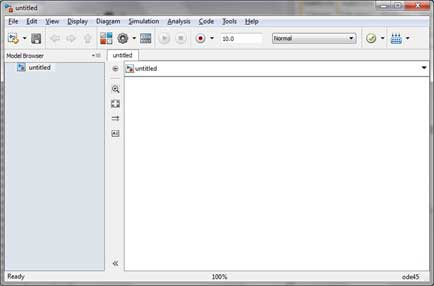
แบบจำลอง Simulink คือแผนภาพบล็อก
องค์ประกอบโมเดลจะถูกเพิ่มโดยการเลือกองค์ประกอบที่เหมาะสมจาก Library Browser และลากไปยังหน้าต่าง Model
คุณสามารถคัดลอกองค์ประกอบของโมเดลและวางลงในหน้าต่างแบบจำลองได้
ตัวอย่าง
ลากและวางรายการจากไลบรารี Simulink เพื่อสร้างโครงการของคุณ
สำหรับวัตถุประสงค์ของตัวอย่างนี้จะใช้สองบล็อกสำหรับการจำลอง - A Source (สัญญาณ) และ Sink(ขอบเขต) เครื่องกำเนิดสัญญาณ (แหล่งที่มา) สร้างสัญญาณแอนะล็อกซึ่งจะแสดงภาพกราฟิกโดยขอบเขต (อ่างล้างจาน)

เริ่มต้นด้วยการลากบล็อกที่ต้องการจากไลบรารีไปที่หน้าต่างโครงการ จากนั้นเชื่อมต่อบล็อกเข้าด้วยกันซึ่งสามารถทำได้โดยการลากตัวเชื่อมต่อจากจุดเชื่อมต่อในบล็อกหนึ่งไปยังอีกบล็อกหนึ่ง
ให้เราลากบล็อก 'Sine Wave' เข้าไปในโมเดล
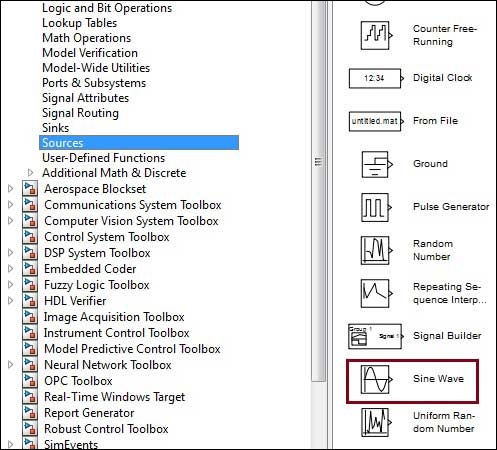
เลือก 'Sinks' จากไลบรารีและลากบล็อก 'Scope' ลงในโมเดล
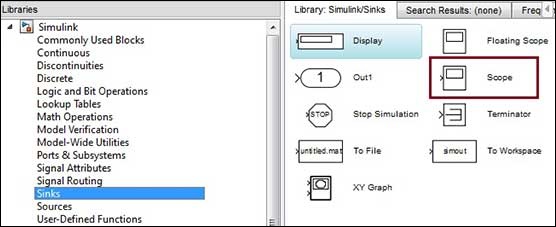
ลากสายสัญญาณจากเอาต์พุตของบล็อก Sine Wave ไปยังอินพุตของบล็อกขอบเขต

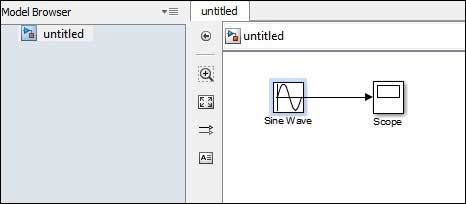
เรียกใช้การจำลองโดยกดปุ่ม 'Run'ทำให้พารามิเตอร์ทั้งหมดเป็นค่าเริ่มต้น (คุณสามารถเปลี่ยนได้จากเมนูการจำลอง)
คุณควรได้รับกราฟด้านล่างจากขอบเขต
